CHCECE017 Foster the holistic development and wellbeing of the child in early childhood
VerifiedAdded on 2023/06/10
|100
|15088
|384
AI Summary
This is a learner workbook, assessment workbook, simulation diary or logbook for the course CHCECE017 Foster the holistic development and wellbeing of the child in early childhood. It provides a guide of instruction and information in relation to the relevant assessment tasks. The assessments aim to test the learner's knowledge, skills and understanding in relation to the topics being taught within the course.
Contribute Materials
Your contribution can guide someone’s learning journey. Share your
documents today.

Secure Best Marks with AI Grader
Need help grading? Try our AI Grader for instant feedback on your assignments.

1. Table of Contents
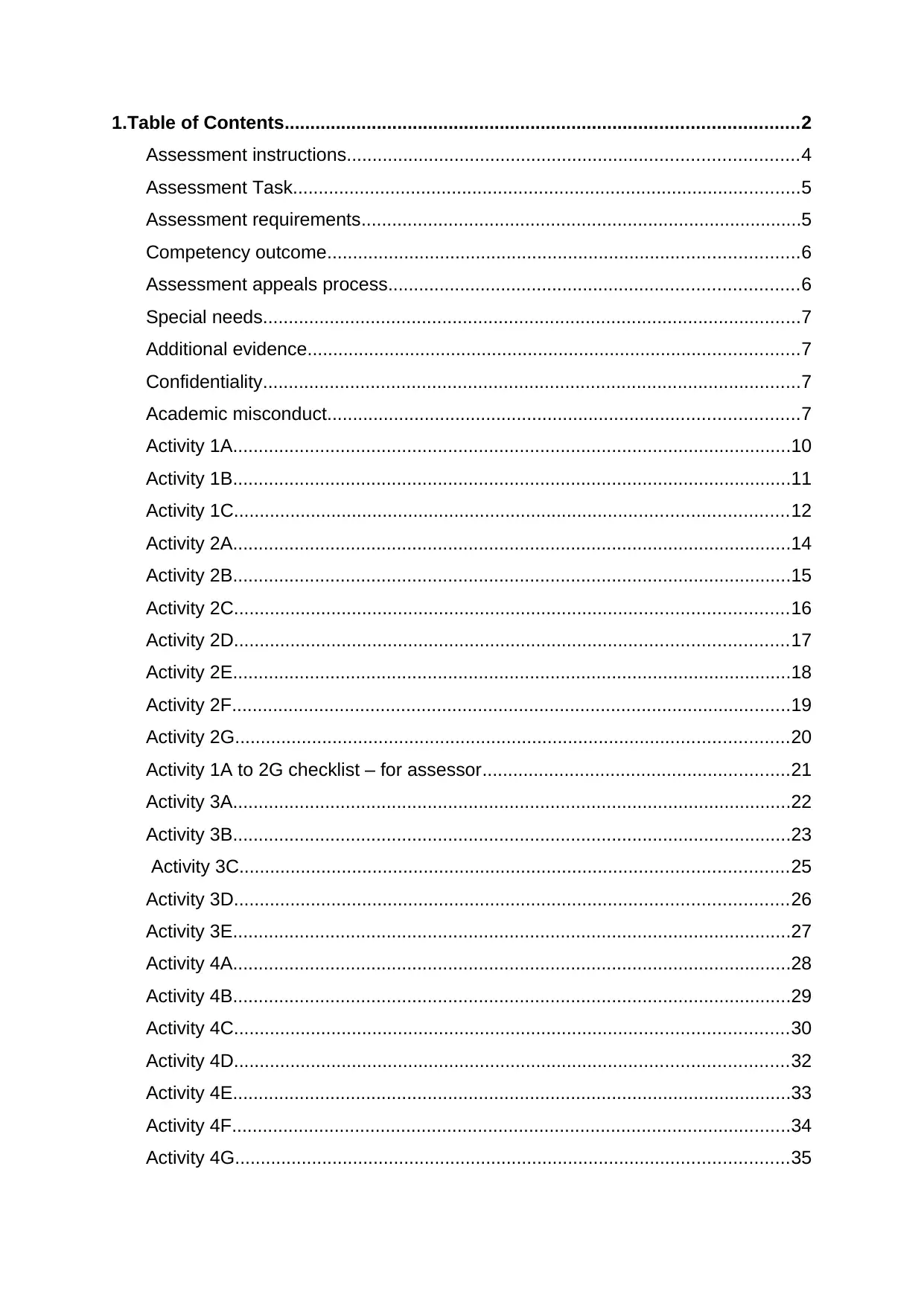
1.Table of Contents....................................................................................................2
Assessment instructions........................................................................................4
Assessment Task...................................................................................................5
Assessment requirements......................................................................................5
Competency outcome............................................................................................6
Assessment appeals process................................................................................6
Special needs.........................................................................................................7
Additional evidence................................................................................................7
Confidentiality.........................................................................................................7
Academic misconduct............................................................................................7
Activity 1A.............................................................................................................10
Activity 1B.............................................................................................................11
Activity 1C............................................................................................................12
Activity 2A.............................................................................................................14
Activity 2B.............................................................................................................15
Activity 2C............................................................................................................16
Activity 2D............................................................................................................17
Activity 2E.............................................................................................................18
Activity 2F.............................................................................................................19
Activity 2G............................................................................................................20
Activity 1A to 2G checklist – for assessor............................................................21
Activity 3A.............................................................................................................22
Activity 3B.............................................................................................................23
Activity 3C...........................................................................................................25
Activity 3D............................................................................................................26
Activity 3E.............................................................................................................27
Activity 4A.............................................................................................................28
Activity 4B.............................................................................................................29
Activity 4C............................................................................................................30
Activity 4D............................................................................................................32
Activity 4E.............................................................................................................33
Activity 4F.............................................................................................................34
Activity 4G............................................................................................................35
Assessment instructions........................................................................................4
Assessment Task...................................................................................................5
Assessment requirements......................................................................................5
Competency outcome............................................................................................6
Assessment appeals process................................................................................6
Special needs.........................................................................................................7
Additional evidence................................................................................................7
Confidentiality.........................................................................................................7
Academic misconduct............................................................................................7
Activity 1A.............................................................................................................10
Activity 1B.............................................................................................................11
Activity 1C............................................................................................................12
Activity 2A.............................................................................................................14
Activity 2B.............................................................................................................15
Activity 2C............................................................................................................16
Activity 2D............................................................................................................17
Activity 2E.............................................................................................................18
Activity 2F.............................................................................................................19
Activity 2G............................................................................................................20
Activity 1A to 2G checklist – for assessor............................................................21
Activity 3A.............................................................................................................22
Activity 3B.............................................................................................................23
Activity 3C...........................................................................................................25
Activity 3D............................................................................................................26
Activity 3E.............................................................................................................27
Activity 4A.............................................................................................................28
Activity 4B.............................................................................................................29
Activity 4C............................................................................................................30
Activity 4D............................................................................................................32
Activity 4E.............................................................................................................33
Activity 4F.............................................................................................................34
Activity 4G............................................................................................................35
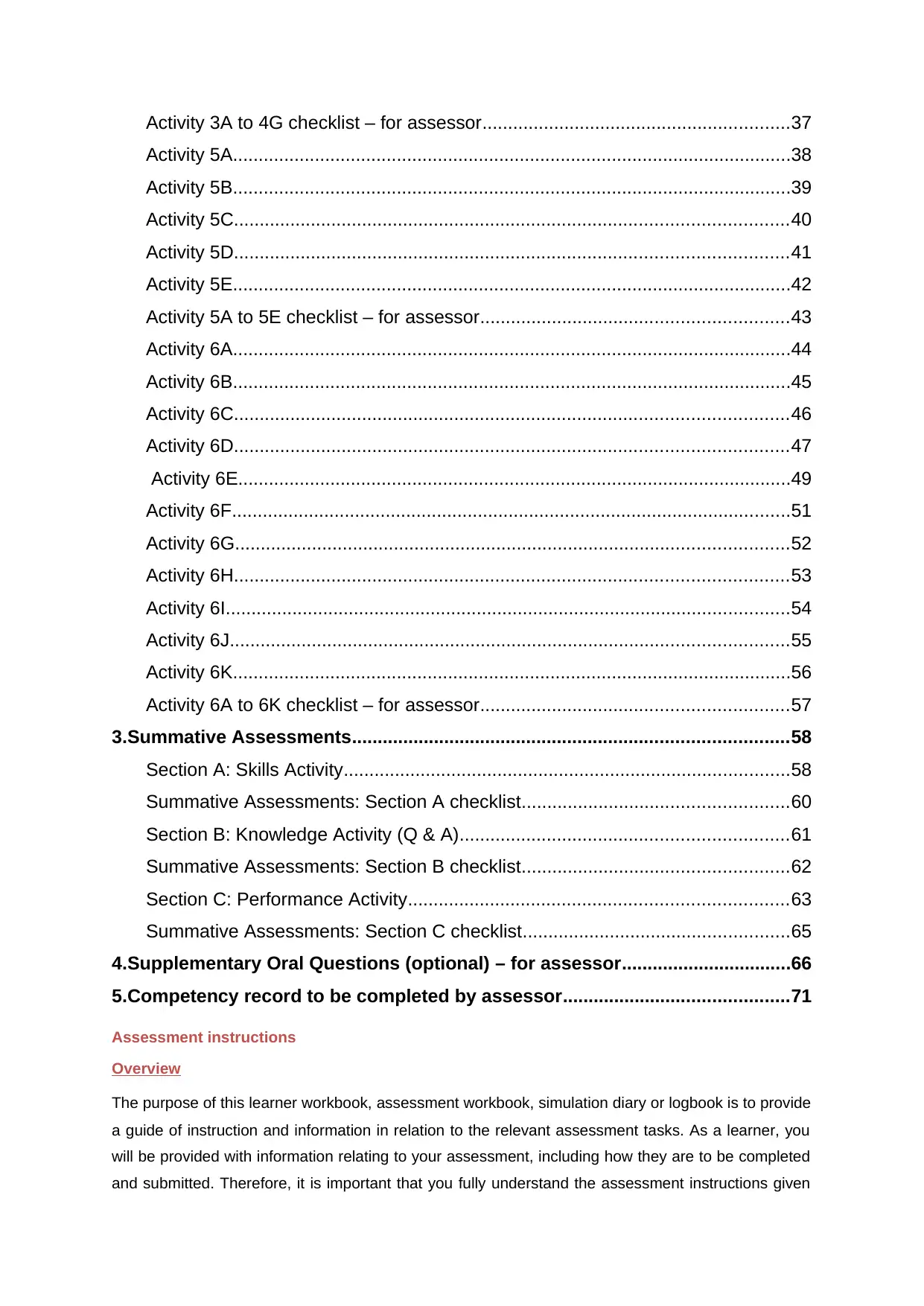
Activity 3A to 4G checklist – for assessor............................................................37
Activity 5A.............................................................................................................38
Activity 5B.............................................................................................................39
Activity 5C............................................................................................................40
Activity 5D............................................................................................................41
Activity 5E.............................................................................................................42
Activity 5A to 5E checklist – for assessor............................................................43
Activity 6A.............................................................................................................44
Activity 6B.............................................................................................................45
Activity 6C............................................................................................................46
Activity 6D............................................................................................................47
Activity 6E............................................................................................................49
Activity 6F.............................................................................................................51
Activity 6G............................................................................................................52
Activity 6H............................................................................................................53
Activity 6I..............................................................................................................54
Activity 6J.............................................................................................................55
Activity 6K.............................................................................................................56
Activity 6A to 6K checklist – for assessor............................................................57
3.Summative Assessments.....................................................................................58
Section A: Skills Activity.......................................................................................58
Summative Assessments: Section A checklist....................................................60
Section B: Knowledge Activity (Q & A)................................................................61
Summative Assessments: Section B checklist....................................................62
Section C: Performance Activity..........................................................................63
Summative Assessments: Section C checklist....................................................65
4.Supplementary Oral Questions (optional) – for assessor.................................66
5.Competency record to be completed by assessor............................................71
Assessment instructions
Overview
The purpose of this learner workbook, assessment workbook, simulation diary or logbook is to provide
a guide of instruction and information in relation to the relevant assessment tasks. As a learner, you
will be provided with information relating to your assessment, including how they are to be completed
and submitted. Therefore, it is important that you fully understand the assessment instructions given
Activity 5A.............................................................................................................38
Activity 5B.............................................................................................................39
Activity 5C............................................................................................................40
Activity 5D............................................................................................................41
Activity 5E.............................................................................................................42
Activity 5A to 5E checklist – for assessor............................................................43
Activity 6A.............................................................................................................44
Activity 6B.............................................................................................................45
Activity 6C............................................................................................................46
Activity 6D............................................................................................................47
Activity 6E............................................................................................................49
Activity 6F.............................................................................................................51
Activity 6G............................................................................................................52
Activity 6H............................................................................................................53
Activity 6I..............................................................................................................54
Activity 6J.............................................................................................................55
Activity 6K.............................................................................................................56
Activity 6A to 6K checklist – for assessor............................................................57
3.Summative Assessments.....................................................................................58
Section A: Skills Activity.......................................................................................58
Summative Assessments: Section A checklist....................................................60
Section B: Knowledge Activity (Q & A)................................................................61
Summative Assessments: Section B checklist....................................................62
Section C: Performance Activity..........................................................................63
Summative Assessments: Section C checklist....................................................65
4.Supplementary Oral Questions (optional) – for assessor.................................66
5.Competency record to be completed by assessor............................................71
Assessment instructions
Overview
The purpose of this learner workbook, assessment workbook, simulation diary or logbook is to provide
a guide of instruction and information in relation to the relevant assessment tasks. As a learner, you
will be provided with information relating to your assessment, including how they are to be completed
and submitted. Therefore, it is important that you fully understand the assessment instructions given
Secure Best Marks with AI Grader
Need help grading? Try our AI Grader for instant feedback on your assignments.
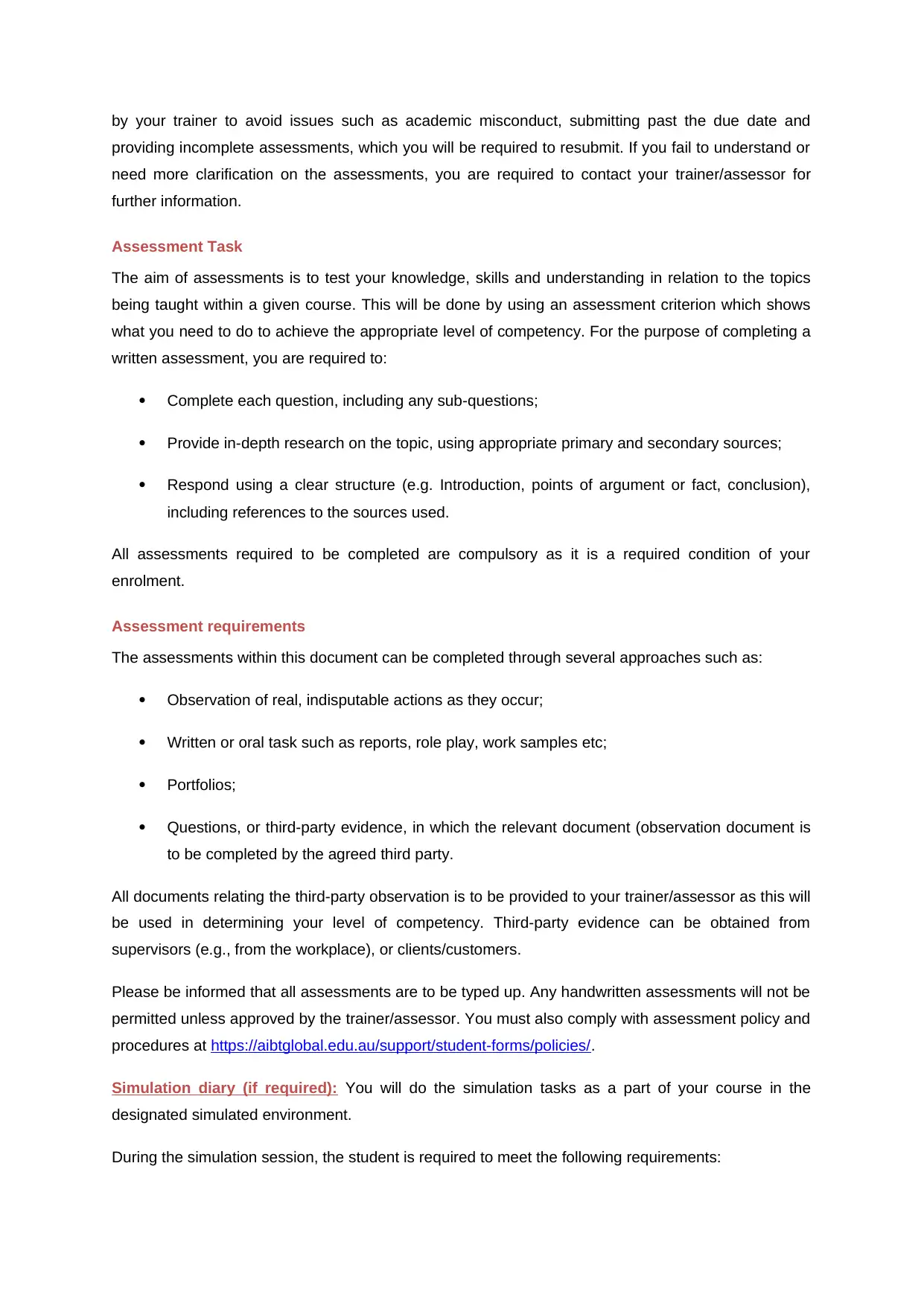
by your trainer to avoid issues such as academic misconduct, submitting past the due date and
providing incomplete assessments, which you will be required to resubmit. If you fail to understand or
need more clarification on the assessments, you are required to contact your trainer/assessor for
further information.
Assessment Task
The aim of assessments is to test your knowledge, skills and understanding in relation to the topics
being taught within a given course. This will be done by using an assessment criterion which shows
what you need to do to achieve the appropriate level of competency. For the purpose of completing a
written assessment, you are required to:
Complete each question, including any sub-questions;
Provide in-depth research on the topic, using appropriate primary and secondary sources;
Respond using a clear structure (e.g. Introduction, points of argument or fact, conclusion),
including references to the sources used.
All assessments required to be completed are compulsory as it is a required condition of your
enrolment.
Assessment requirements
The assessments within this document can be completed through several approaches such as:
Observation of real, indisputable actions as they occur;
Written or oral task such as reports, role play, work samples etc;
Portfolios;
Questions, or third-party evidence, in which the relevant document (observation document is
to be completed by the agreed third party.
All documents relating the third-party observation is to be provided to your trainer/assessor as this will
be used in determining your level of competency. Third-party evidence can be obtained from
supervisors (e.g., from the workplace), or clients/customers.
Please be informed that all assessments are to be typed up. Any handwritten assessments will not be
permitted unless approved by the trainer/assessor. You must also comply with assessment policy and
procedures at https://aibtglobal.edu.au/support/student-forms/policies/.
Simulation diary (if required): You will do the simulation tasks as a part of your course in the
designated simulated environment.
During the simulation session, the student is required to meet the following requirements:
providing incomplete assessments, which you will be required to resubmit. If you fail to understand or
need more clarification on the assessments, you are required to contact your trainer/assessor for
further information.
Assessment Task
The aim of assessments is to test your knowledge, skills and understanding in relation to the topics
being taught within a given course. This will be done by using an assessment criterion which shows
what you need to do to achieve the appropriate level of competency. For the purpose of completing a
written assessment, you are required to:
Complete each question, including any sub-questions;
Provide in-depth research on the topic, using appropriate primary and secondary sources;
Respond using a clear structure (e.g. Introduction, points of argument or fact, conclusion),
including references to the sources used.
All assessments required to be completed are compulsory as it is a required condition of your
enrolment.
Assessment requirements
The assessments within this document can be completed through several approaches such as:
Observation of real, indisputable actions as they occur;
Written or oral task such as reports, role play, work samples etc;
Portfolios;
Questions, or third-party evidence, in which the relevant document (observation document is
to be completed by the agreed third party.
All documents relating the third-party observation is to be provided to your trainer/assessor as this will
be used in determining your level of competency. Third-party evidence can be obtained from
supervisors (e.g., from the workplace), or clients/customers.
Please be informed that all assessments are to be typed up. Any handwritten assessments will not be
permitted unless approved by the trainer/assessor. You must also comply with assessment policy and
procedures at https://aibtglobal.edu.au/support/student-forms/policies/.
Simulation diary (if required): You will do the simulation tasks as a part of your course in the
designated simulated environment.
During the simulation session, the student is required to meet the following requirements:
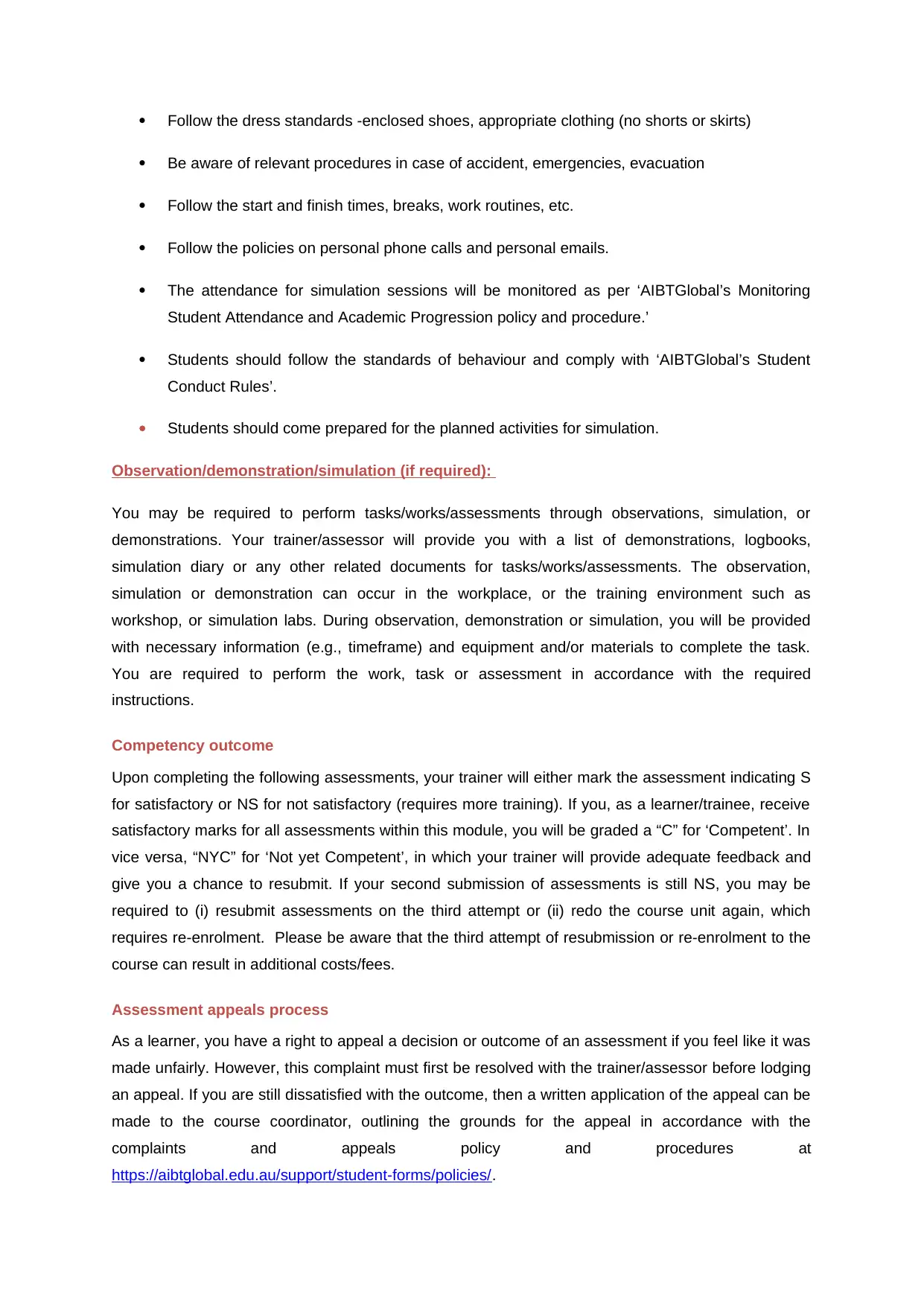
Follow the dress standards -enclosed shoes, appropriate clothing (no shorts or skirts)
Be aware of relevant procedures in case of accident, emergencies, evacuation
Follow the start and finish times, breaks, work routines, etc.
Follow the policies on personal phone calls and personal emails.
The attendance for simulation sessions will be monitored as per ‘AIBTGlobal’s Monitoring
Student Attendance and Academic Progression policy and procedure.’
Students should follow the standards of behaviour and comply with ‘AIBTGlobal’s Student
Conduct Rules’.
Students should come prepared for the planned activities for simulation.
Observation/demonstration/simulation (if required):
You may be required to perform tasks/works/assessments through observations, simulation, or
demonstrations. Your trainer/assessor will provide you with a list of demonstrations, logbooks,
simulation diary or any other related documents for tasks/works/assessments. The observation,
simulation or demonstration can occur in the workplace, or the training environment such as
workshop, or simulation labs. During observation, demonstration or simulation, you will be provided
with necessary information (e.g., timeframe) and equipment and/or materials to complete the task.
You are required to perform the work, task or assessment in accordance with the required
instructions.
Competency outcome
Upon completing the following assessments, your trainer will either mark the assessment indicating S
for satisfactory or NS for not satisfactory (requires more training). If you, as a learner/trainee, receive
satisfactory marks for all assessments within this module, you will be graded a “C” for ‘Competent’. In
vice versa, “NYC” for ‘Not yet Competent’, in which your trainer will provide adequate feedback and
give you a chance to resubmit. If your second submission of assessments is still NS, you may be
required to (i) resubmit assessments on the third attempt or (ii) redo the course unit again, which
requires re-enrolment. Please be aware that the third attempt of resubmission or re-enrolment to the
course can result in additional costs/fees.
Assessment appeals process
As a learner, you have a right to appeal a decision or outcome of an assessment if you feel like it was
made unfairly. However, this complaint must first be resolved with the trainer/assessor before lodging
an appeal. If you are still dissatisfied with the outcome, then a written application of the appeal can be
made to the course coordinator, outlining the grounds for the appeal in accordance with the
complaints and appeals policy and procedures at
https://aibtglobal.edu.au/support/student-forms/policies/.
Be aware of relevant procedures in case of accident, emergencies, evacuation
Follow the start and finish times, breaks, work routines, etc.
Follow the policies on personal phone calls and personal emails.
The attendance for simulation sessions will be monitored as per ‘AIBTGlobal’s Monitoring
Student Attendance and Academic Progression policy and procedure.’
Students should follow the standards of behaviour and comply with ‘AIBTGlobal’s Student
Conduct Rules’.
Students should come prepared for the planned activities for simulation.
Observation/demonstration/simulation (if required):
You may be required to perform tasks/works/assessments through observations, simulation, or
demonstrations. Your trainer/assessor will provide you with a list of demonstrations, logbooks,
simulation diary or any other related documents for tasks/works/assessments. The observation,
simulation or demonstration can occur in the workplace, or the training environment such as
workshop, or simulation labs. During observation, demonstration or simulation, you will be provided
with necessary information (e.g., timeframe) and equipment and/or materials to complete the task.
You are required to perform the work, task or assessment in accordance with the required
instructions.
Competency outcome
Upon completing the following assessments, your trainer will either mark the assessment indicating S
for satisfactory or NS for not satisfactory (requires more training). If you, as a learner/trainee, receive
satisfactory marks for all assessments within this module, you will be graded a “C” for ‘Competent’. In
vice versa, “NYC” for ‘Not yet Competent’, in which your trainer will provide adequate feedback and
give you a chance to resubmit. If your second submission of assessments is still NS, you may be
required to (i) resubmit assessments on the third attempt or (ii) redo the course unit again, which
requires re-enrolment. Please be aware that the third attempt of resubmission or re-enrolment to the
course can result in additional costs/fees.
Assessment appeals process
As a learner, you have a right to appeal a decision or outcome of an assessment if you feel like it was
made unfairly. However, this complaint must first be resolved with the trainer/assessor before lodging
an appeal. If you are still dissatisfied with the outcome, then a written application of the appeal can be
made to the course coordinator, outlining the grounds for the appeal in accordance with the
complaints and appeals policy and procedures at
https://aibtglobal.edu.au/support/student-forms/policies/.
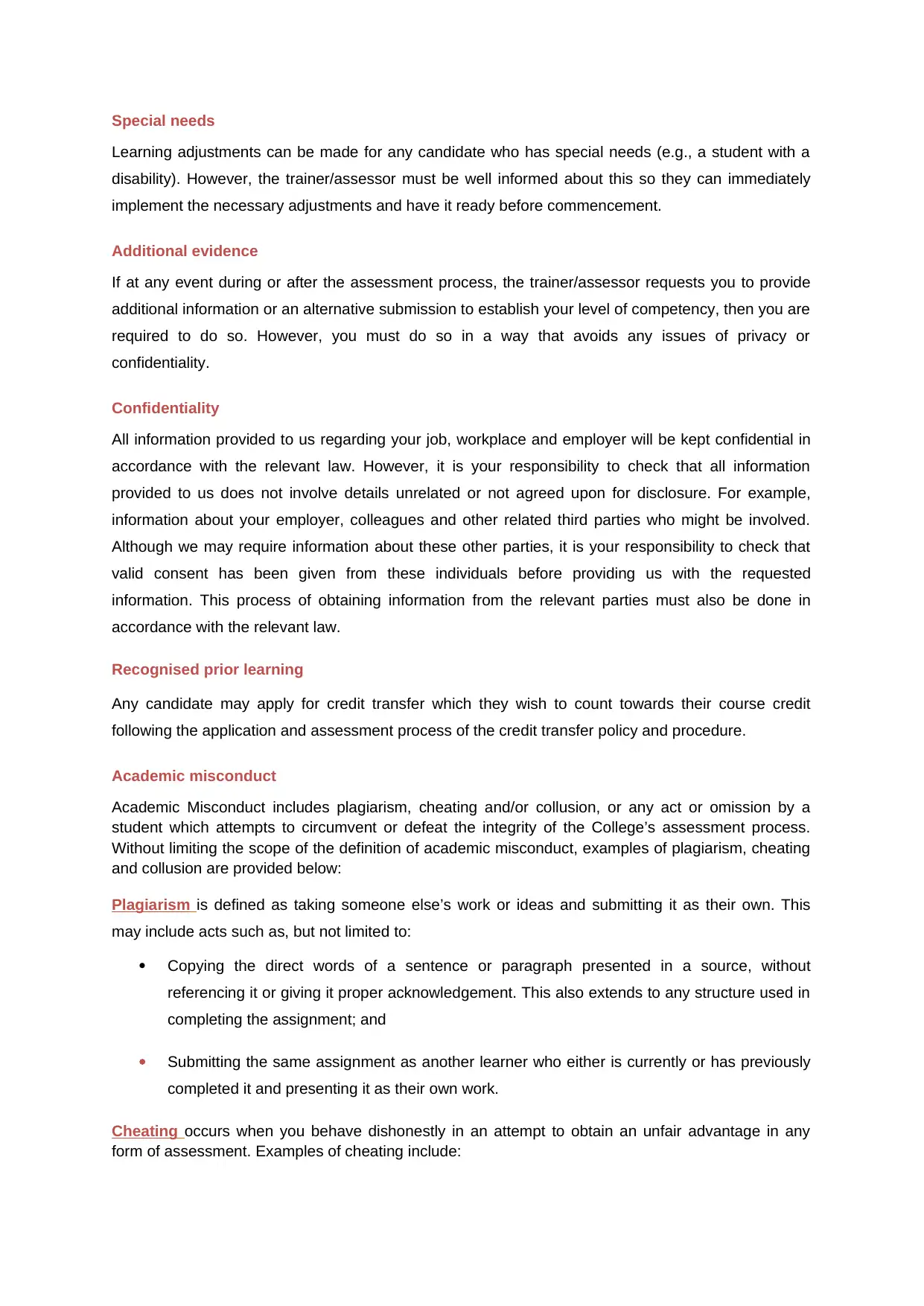
Special needs
Learning adjustments can be made for any candidate who has special needs (e.g., a student with a
disability). However, the trainer/assessor must be well informed about this so they can immediately
implement the necessary adjustments and have it ready before commencement.
Additional evidence
If at any event during or after the assessment process, the trainer/assessor requests you to provide
additional information or an alternative submission to establish your level of competency, then you are
required to do so. However, you must do so in a way that avoids any issues of privacy or
confidentiality.
Confidentiality
All information provided to us regarding your job, workplace and employer will be kept confidential in
accordance with the relevant law. However, it is your responsibility to check that all information
provided to us does not involve details unrelated or not agreed upon for disclosure. For example,
information about your employer, colleagues and other related third parties who might be involved.
Although we may require information about these other parties, it is your responsibility to check that
valid consent has been given from these individuals before providing us with the requested
information. This process of obtaining information from the relevant parties must also be done in
accordance with the relevant law.
Recognised prior learning
Any candidate may apply for credit transfer which they wish to count towards their course credit
following the application and assessment process of the credit transfer policy and procedure.
Academic misconduct
Academic Misconduct includes plagiarism, cheating and/or collusion, or any act or omission by a
student which attempts to circumvent or defeat the integrity of the College’s assessment process.
Without limiting the scope of the definition of academic misconduct, examples of plagiarism, cheating
and collusion are provided below:
Plagiarism is defined as taking someone else’s work or ideas and submitting it as their own. This
may include acts such as, but not limited to:
Copying the direct words of a sentence or paragraph presented in a source, without
referencing it or giving it proper acknowledgement. This also extends to any structure used in
completing the assignment; and
Submitting the same assignment as another learner who either is currently or has previously
completed it and presenting it as their own work.
Cheating occurs when you behave dishonestly in an attempt to obtain an unfair advantage in any
form of assessment. Examples of cheating include:
Learning adjustments can be made for any candidate who has special needs (e.g., a student with a
disability). However, the trainer/assessor must be well informed about this so they can immediately
implement the necessary adjustments and have it ready before commencement.
Additional evidence
If at any event during or after the assessment process, the trainer/assessor requests you to provide
additional information or an alternative submission to establish your level of competency, then you are
required to do so. However, you must do so in a way that avoids any issues of privacy or
confidentiality.
Confidentiality
All information provided to us regarding your job, workplace and employer will be kept confidential in
accordance with the relevant law. However, it is your responsibility to check that all information
provided to us does not involve details unrelated or not agreed upon for disclosure. For example,
information about your employer, colleagues and other related third parties who might be involved.
Although we may require information about these other parties, it is your responsibility to check that
valid consent has been given from these individuals before providing us with the requested
information. This process of obtaining information from the relevant parties must also be done in
accordance with the relevant law.
Recognised prior learning
Any candidate may apply for credit transfer which they wish to count towards their course credit
following the application and assessment process of the credit transfer policy and procedure.
Academic misconduct
Academic Misconduct includes plagiarism, cheating and/or collusion, or any act or omission by a
student which attempts to circumvent or defeat the integrity of the College’s assessment process.
Without limiting the scope of the definition of academic misconduct, examples of plagiarism, cheating
and collusion are provided below:
Plagiarism is defined as taking someone else’s work or ideas and submitting it as their own. This
may include acts such as, but not limited to:
Copying the direct words of a sentence or paragraph presented in a source, without
referencing it or giving it proper acknowledgement. This also extends to any structure used in
completing the assignment; and
Submitting the same assignment as another learner who either is currently or has previously
completed it and presenting it as their own work.
Cheating occurs when you behave dishonestly in an attempt to obtain an unfair advantage in any
form of assessment. Examples of cheating include:
Paraphrase This Document
Need a fresh take? Get an instant paraphrase of this document with our AI Paraphraser
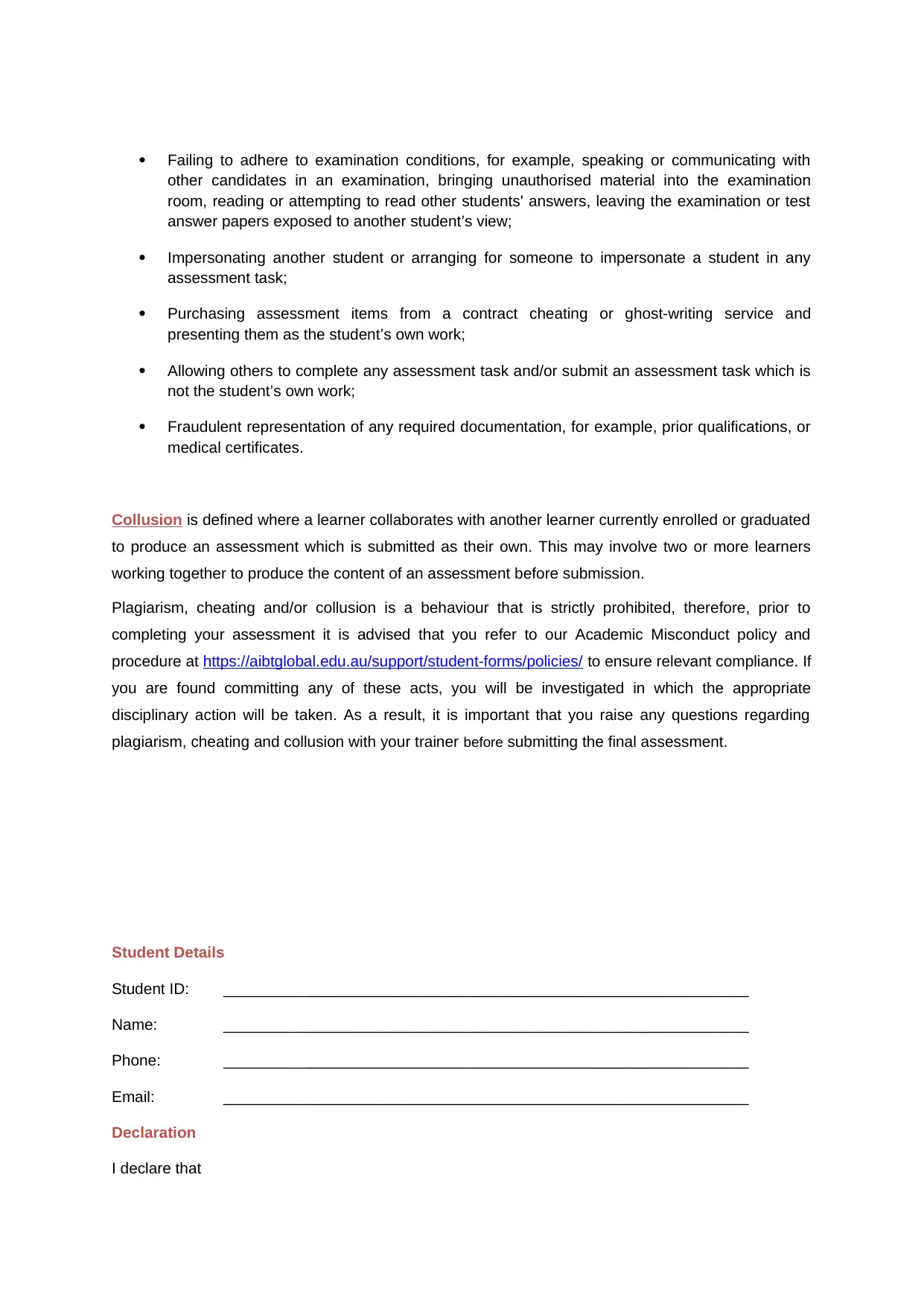
Failing to adhere to examination conditions, for example, speaking or communicating with
other candidates in an examination, bringing unauthorised material into the examination
room, reading or attempting to read other students' answers, leaving the examination or test
answer papers exposed to another student’s view;
Impersonating another student or arranging for someone to impersonate a student in any
assessment task;
Purchasing assessment items from a contract cheating or ghost-writing service and
presenting them as the student’s own work;
Allowing others to complete any assessment task and/or submit an assessment task which is
not the student’s own work;
Fraudulent representation of any required documentation, for example, prior qualifications, or
medical certificates.
Collusion is defined where a learner collaborates with another learner currently enrolled or graduated
to produce an assessment which is submitted as their own. This may involve two or more learners
working together to produce the content of an assessment before submission.
Plagiarism, cheating and/or collusion is a behaviour that is strictly prohibited, therefore, prior to
completing your assessment it is advised that you refer to our Academic Misconduct policy and
procedure at https://aibtglobal.edu.au/support/student-forms/policies/ to ensure relevant compliance. If
you are found committing any of these acts, you will be investigated in which the appropriate
disciplinary action will be taken. As a result, it is important that you raise any questions regarding
plagiarism, cheating and collusion with your trainer before submitting the final assessment.
Student Details
Student ID: _____________________________________________________________
Name: _____________________________________________________________
Phone: _____________________________________________________________
Email: _____________________________________________________________
Declaration
I declare that
other candidates in an examination, bringing unauthorised material into the examination
room, reading or attempting to read other students' answers, leaving the examination or test
answer papers exposed to another student’s view;
Impersonating another student or arranging for someone to impersonate a student in any
assessment task;
Purchasing assessment items from a contract cheating or ghost-writing service and
presenting them as the student’s own work;
Allowing others to complete any assessment task and/or submit an assessment task which is
not the student’s own work;
Fraudulent representation of any required documentation, for example, prior qualifications, or
medical certificates.
Collusion is defined where a learner collaborates with another learner currently enrolled or graduated
to produce an assessment which is submitted as their own. This may involve two or more learners
working together to produce the content of an assessment before submission.
Plagiarism, cheating and/or collusion is a behaviour that is strictly prohibited, therefore, prior to
completing your assessment it is advised that you refer to our Academic Misconduct policy and
procedure at https://aibtglobal.edu.au/support/student-forms/policies/ to ensure relevant compliance. If
you are found committing any of these acts, you will be investigated in which the appropriate
disciplinary action will be taken. As a result, it is important that you raise any questions regarding
plagiarism, cheating and collusion with your trainer before submitting the final assessment.
Student Details
Student ID: _____________________________________________________________
Name: _____________________________________________________________
Phone: _____________________________________________________________
Email: _____________________________________________________________
Declaration
I declare that
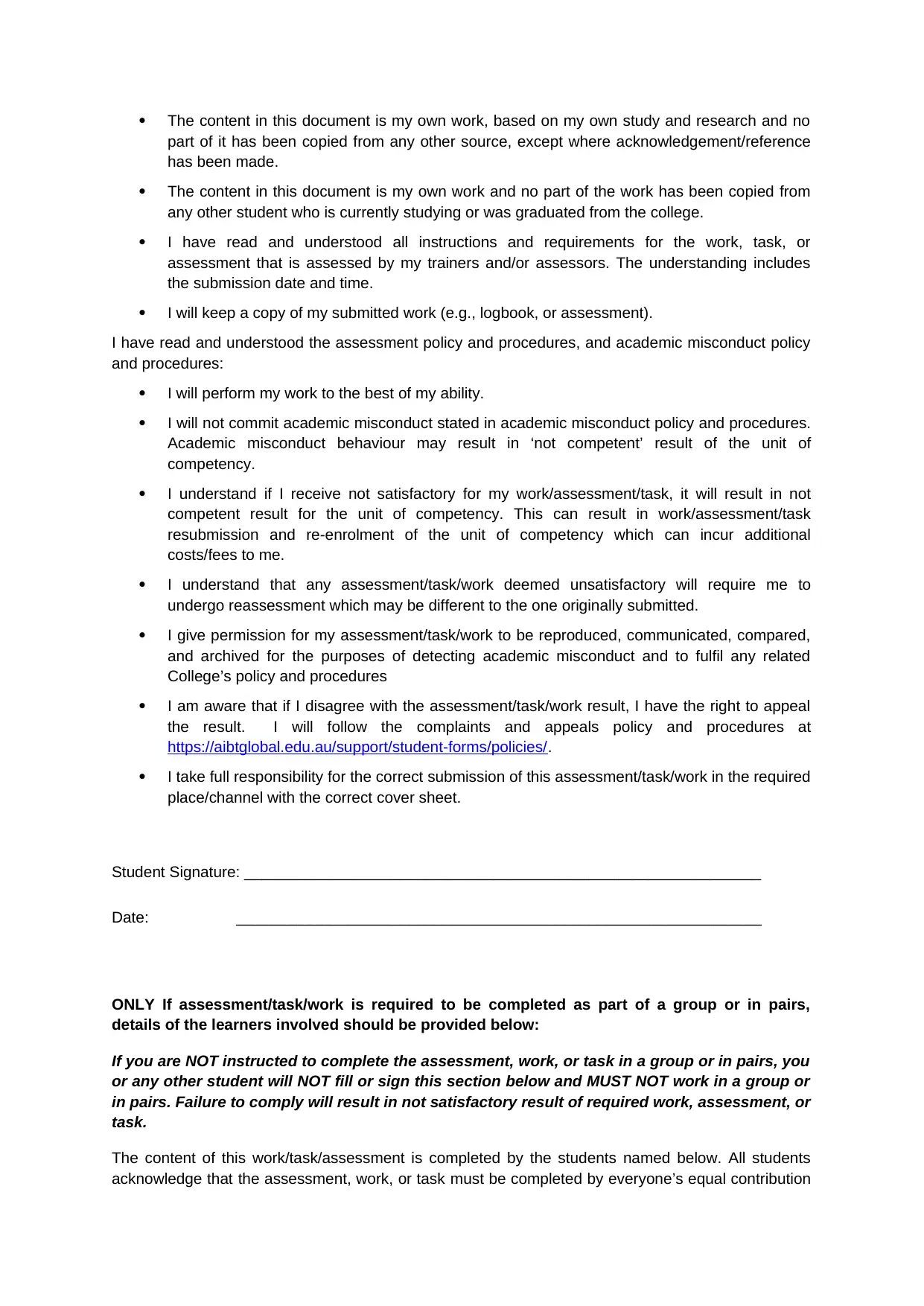
The content in this document is my own work, based on my own study and research and no
part of it has been copied from any other source, except where acknowledgement/reference
has been made.
The content in this document is my own work and no part of the work has been copied from
any other student who is currently studying or was graduated from the college.
I have read and understood all instructions and requirements for the work, task, or
assessment that is assessed by my trainers and/or assessors. The understanding includes
the submission date and time.
I will keep a copy of my submitted work (e.g., logbook, or assessment).
I have read and understood the assessment policy and procedures, and academic misconduct policy
and procedures:
I will perform my work to the best of my ability.
I will not commit academic misconduct stated in academic misconduct policy and procedures.
Academic misconduct behaviour may result in ‘not competent’ result of the unit of
competency.
I understand if I receive not satisfactory for my work/assessment/task, it will result in not
competent result for the unit of competency. This can result in work/assessment/task
resubmission and re-enrolment of the unit of competency which can incur additional
costs/fees to me.
I understand that any assessment/task/work deemed unsatisfactory will require me to
undergo reassessment which may be different to the one originally submitted.
I give permission for my assessment/task/work to be reproduced, communicated, compared,
and archived for the purposes of detecting academic misconduct and to fulfil any related
College’s policy and procedures
I am aware that if I disagree with the assessment/task/work result, I have the right to appeal
the result. I will follow the complaints and appeals policy and procedures at
https://aibtglobal.edu.au/support/student-forms/policies/.
I take full responsibility for the correct submission of this assessment/task/work in the required
place/channel with the correct cover sheet.
Student Signature: ____________________________________________________________
Date: _____________________________________________________________
ONLY If assessment/task/work is required to be completed as part of a group or in pairs,
details of the learners involved should be provided below:
If you are NOT instructed to complete the assessment, work, or task in a group or in pairs, you
or any other student will NOT fill or sign this section below and MUST NOT work in a group or
in pairs. Failure to comply will result in not satisfactory result of required work, assessment, or
task.
The content of this work/task/assessment is completed by the students named below. All students
acknowledge that the assessment, work, or task must be completed by everyone’s equal contribution
part of it has been copied from any other source, except where acknowledgement/reference
has been made.
The content in this document is my own work and no part of the work has been copied from
any other student who is currently studying or was graduated from the college.
I have read and understood all instructions and requirements for the work, task, or
assessment that is assessed by my trainers and/or assessors. The understanding includes
the submission date and time.
I will keep a copy of my submitted work (e.g., logbook, or assessment).
I have read and understood the assessment policy and procedures, and academic misconduct policy
and procedures:
I will perform my work to the best of my ability.
I will not commit academic misconduct stated in academic misconduct policy and procedures.
Academic misconduct behaviour may result in ‘not competent’ result of the unit of
competency.
I understand if I receive not satisfactory for my work/assessment/task, it will result in not
competent result for the unit of competency. This can result in work/assessment/task
resubmission and re-enrolment of the unit of competency which can incur additional
costs/fees to me.
I understand that any assessment/task/work deemed unsatisfactory will require me to
undergo reassessment which may be different to the one originally submitted.
I give permission for my assessment/task/work to be reproduced, communicated, compared,
and archived for the purposes of detecting academic misconduct and to fulfil any related
College’s policy and procedures
I am aware that if I disagree with the assessment/task/work result, I have the right to appeal
the result. I will follow the complaints and appeals policy and procedures at
https://aibtglobal.edu.au/support/student-forms/policies/.
I take full responsibility for the correct submission of this assessment/task/work in the required
place/channel with the correct cover sheet.
Student Signature: ____________________________________________________________
Date: _____________________________________________________________
ONLY If assessment/task/work is required to be completed as part of a group or in pairs,
details of the learners involved should be provided below:
If you are NOT instructed to complete the assessment, work, or task in a group or in pairs, you
or any other student will NOT fill or sign this section below and MUST NOT work in a group or
in pairs. Failure to comply will result in not satisfactory result of required work, assessment, or
task.
The content of this work/task/assessment is completed by the students named below. All students
acknowledge that the assessment, work, or task must be completed by everyone’s equal contribution
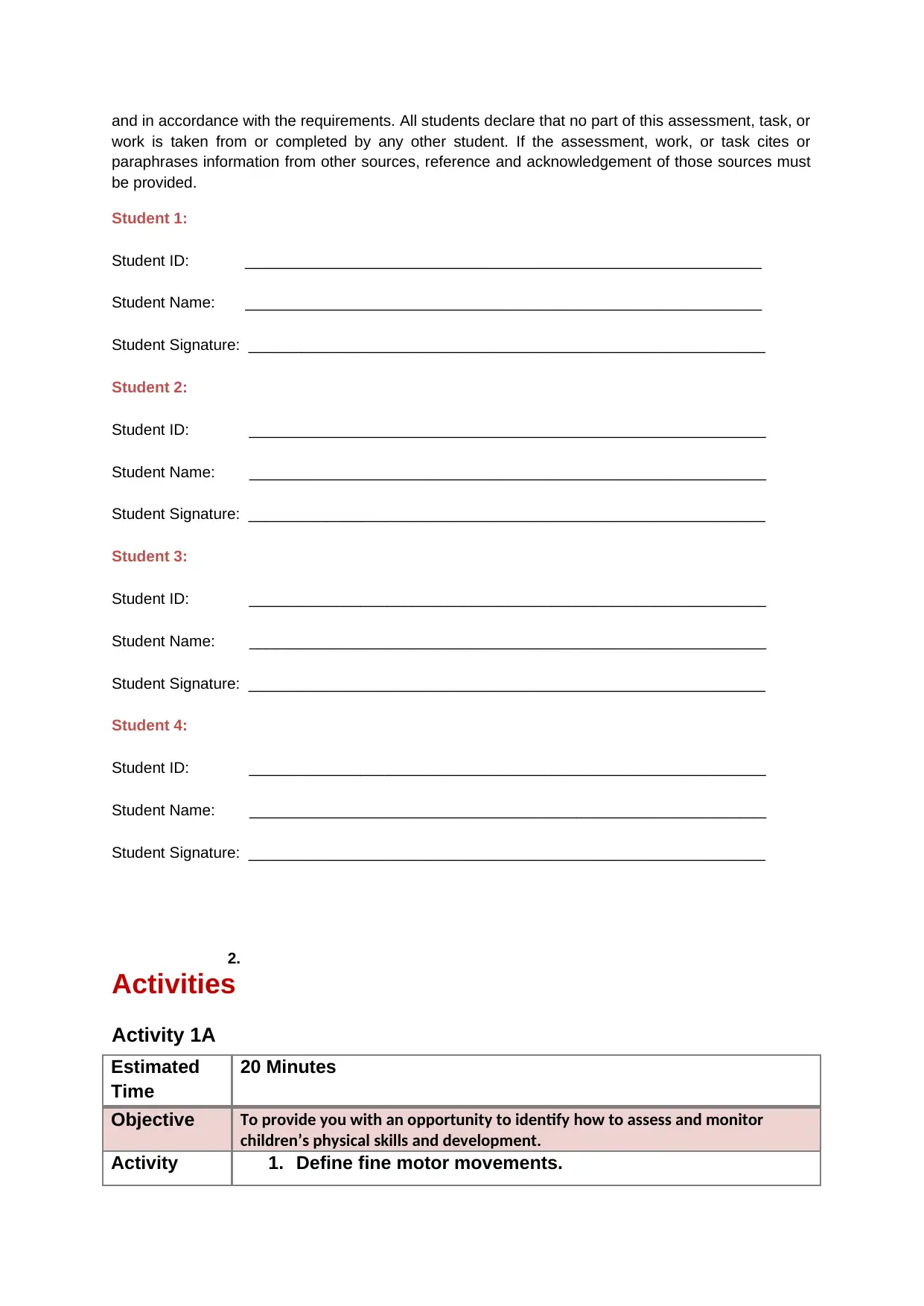
and in accordance with the requirements. All students declare that no part of this assessment, task, or
work is taken from or completed by any other student. If the assessment, work, or task cites or
paraphrases information from other sources, reference and acknowledgement of those sources must
be provided.
Student 1:
Student ID: ____________________________________________________________
Student Name: ____________________________________________________________
Student Signature: ____________________________________________________________
Student 2:
Student ID: ____________________________________________________________
Student Name: ____________________________________________________________
Student Signature: ____________________________________________________________
Student 3:
Student ID: ____________________________________________________________
Student Name: ____________________________________________________________
Student Signature: ____________________________________________________________
Student 4:
Student ID: ____________________________________________________________
Student Name: ____________________________________________________________
Student Signature: ____________________________________________________________
2.
Activities
Activity 1A
Estimated
Time
20 Minutes
Objective To provide you with an opportunity to identify how to assess and monitor
children’s physical skills and development.
Activity 1. Define fine motor movements.
work is taken from or completed by any other student. If the assessment, work, or task cites or
paraphrases information from other sources, reference and acknowledgement of those sources must
be provided.
Student 1:
Student ID: ____________________________________________________________
Student Name: ____________________________________________________________
Student Signature: ____________________________________________________________
Student 2:
Student ID: ____________________________________________________________
Student Name: ____________________________________________________________
Student Signature: ____________________________________________________________
Student 3:
Student ID: ____________________________________________________________
Student Name: ____________________________________________________________
Student Signature: ____________________________________________________________
Student 4:
Student ID: ____________________________________________________________
Student Name: ____________________________________________________________
Student Signature: ____________________________________________________________
2.
Activities
Activity 1A
Estimated
Time
20 Minutes
Objective To provide you with an opportunity to identify how to assess and monitor
children’s physical skills and development.
Activity 1. Define fine motor movements.
Secure Best Marks with AI Grader
Need help grading? Try our AI Grader for instant feedback on your assignments.
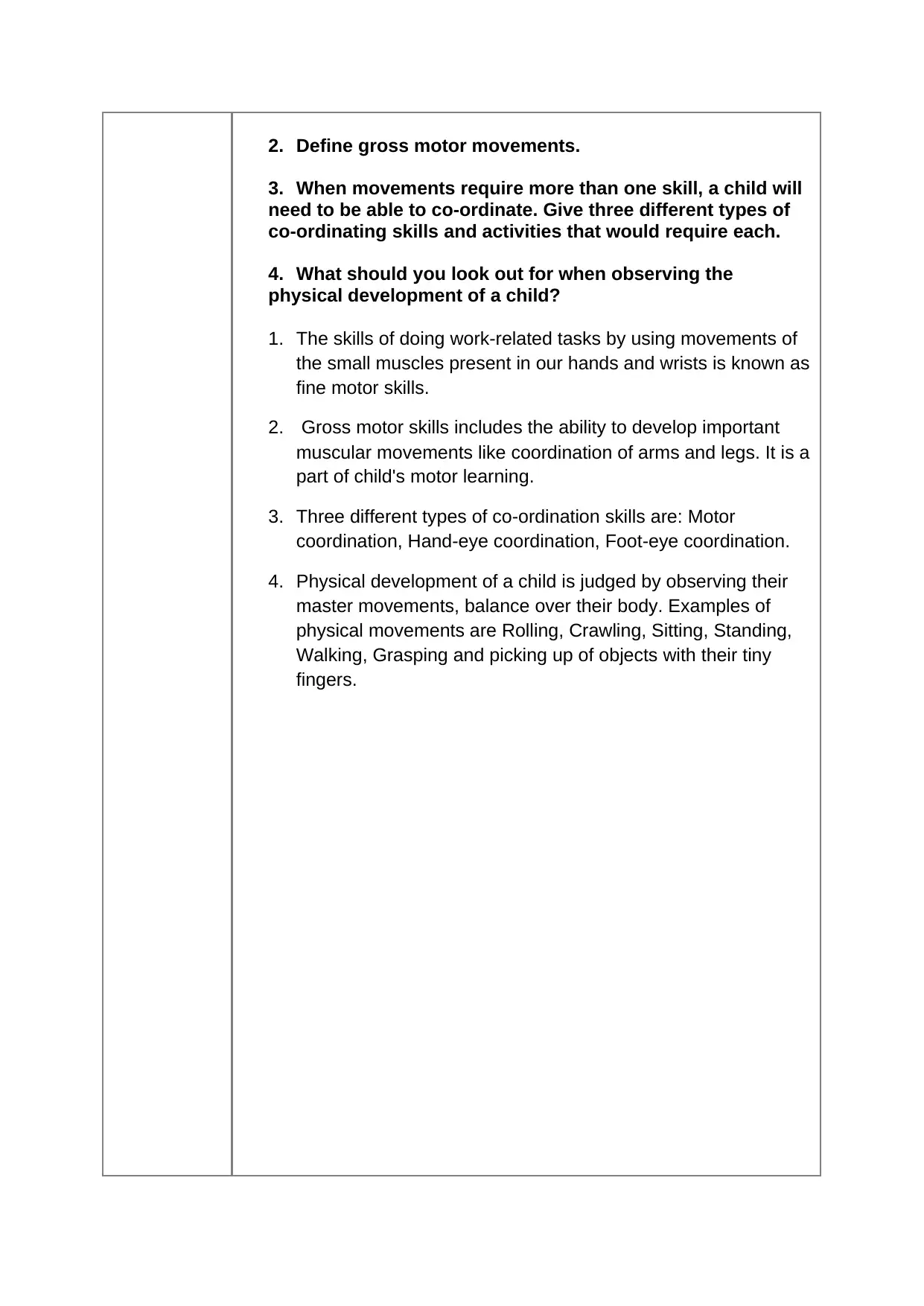
2. Define gross motor movements.
3. When movements require more than one skill, a child will
need to be able to co-ordinate. Give three different types of
co-ordinating skills and activities that would require each.
4. What should you look out for when observing the
physical development of a child?
1. The skills of doing work-related tasks by using movements of
the small muscles present in our hands and wrists is known as
fine motor skills.
2. Gross motor skills includes the ability to develop important
muscular movements like coordination of arms and legs. It is a
part of child's motor learning.
3. Three different types of co-ordination skills are: Motor
coordination, Hand-eye coordination, Foot-eye coordination.
4. Physical development of a child is judged by observing their
master movements, balance over their body. Examples of
physical movements are Rolling, Crawling, Sitting, Standing,
Walking, Grasping and picking up of objects with their tiny
fingers.
3. When movements require more than one skill, a child will
need to be able to co-ordinate. Give three different types of
co-ordinating skills and activities that would require each.
4. What should you look out for when observing the
physical development of a child?
1. The skills of doing work-related tasks by using movements of
the small muscles present in our hands and wrists is known as
fine motor skills.
2. Gross motor skills includes the ability to develop important
muscular movements like coordination of arms and legs. It is a
part of child's motor learning.
3. Three different types of co-ordination skills are: Motor
coordination, Hand-eye coordination, Foot-eye coordination.
4. Physical development of a child is judged by observing their
master movements, balance over their body. Examples of
physical movements are Rolling, Crawling, Sitting, Standing,
Walking, Grasping and picking up of objects with their tiny
fingers.
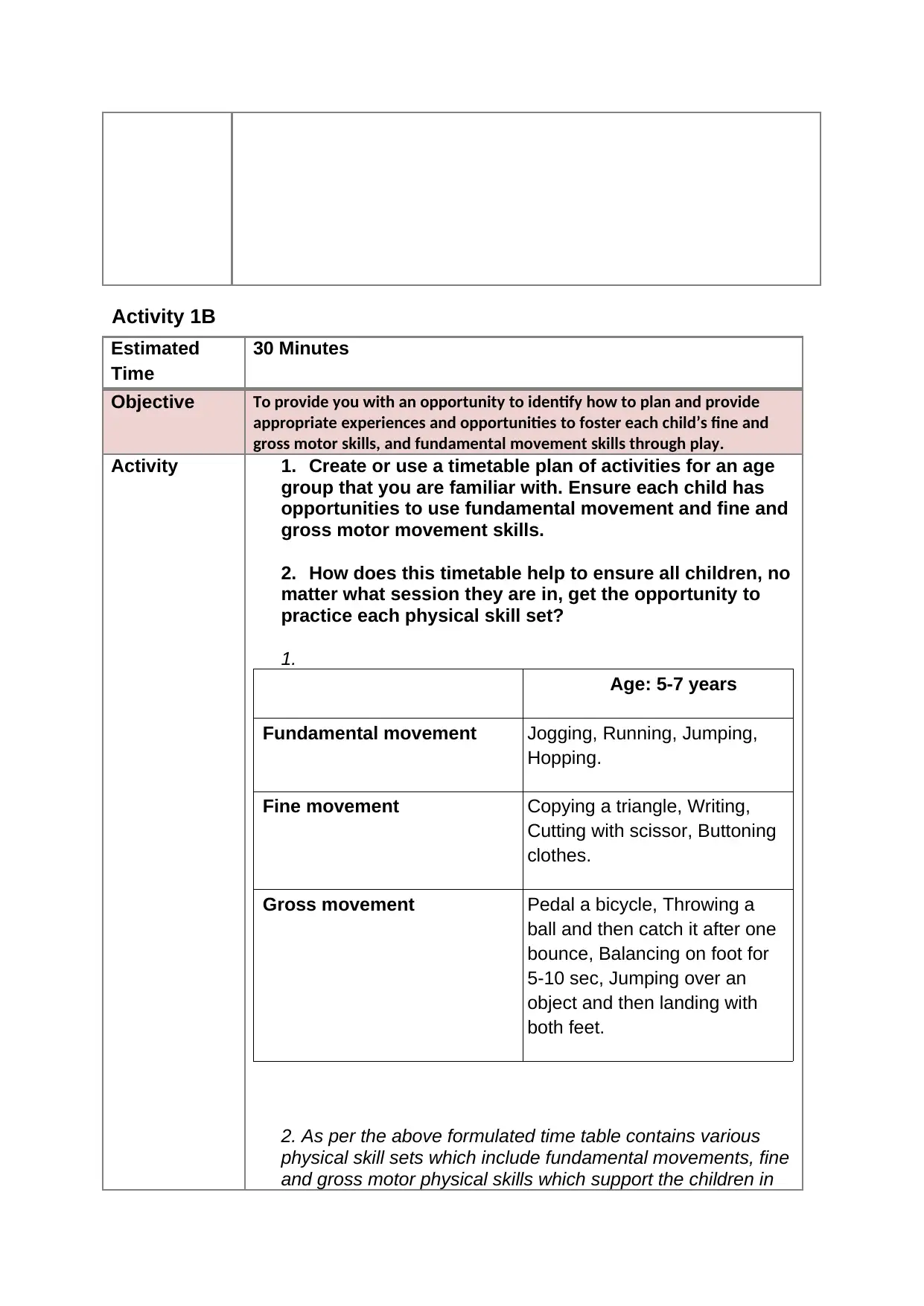
Activity 1B
Estimated
Time
30 Minutes
Objective To provide you with an opportunity to identify how to plan and provide
appropriate experiences and opportunities to foster each child’s fine and
gross motor skills, and fundamental movement skills through play.
Activity 1. Create or use a timetable plan of activities for an age
group that you are familiar with. Ensure each child has
opportunities to use fundamental movement and fine and
gross motor movement skills.
2. How does this timetable help to ensure all children, no
matter what session they are in, get the opportunity to
practice each physical skill set?
1.
Age: 5-7 years
Fundamental movement Jogging, Running, Jumping,
Hopping.
Fine movement Copying a triangle, Writing,
Cutting with scissor, Buttoning
clothes.
Gross movement Pedal a bicycle, Throwing a
ball and then catch it after one
bounce, Balancing on foot for
5-10 sec, Jumping over an
object and then landing with
both feet.
2. As per the above formulated time table contains various
physical skill sets which include fundamental movements, fine
and gross motor physical skills which support the children in
Estimated
Time
30 Minutes
Objective To provide you with an opportunity to identify how to plan and provide
appropriate experiences and opportunities to foster each child’s fine and
gross motor skills, and fundamental movement skills through play.
Activity 1. Create or use a timetable plan of activities for an age
group that you are familiar with. Ensure each child has
opportunities to use fundamental movement and fine and
gross motor movement skills.
2. How does this timetable help to ensure all children, no
matter what session they are in, get the opportunity to
practice each physical skill set?
1.
Age: 5-7 years
Fundamental movement Jogging, Running, Jumping,
Hopping.
Fine movement Copying a triangle, Writing,
Cutting with scissor, Buttoning
clothes.
Gross movement Pedal a bicycle, Throwing a
ball and then catch it after one
bounce, Balancing on foot for
5-10 sec, Jumping over an
object and then landing with
both feet.
2. As per the above formulated time table contains various
physical skill sets which include fundamental movements, fine
and gross motor physical skills which support the children in
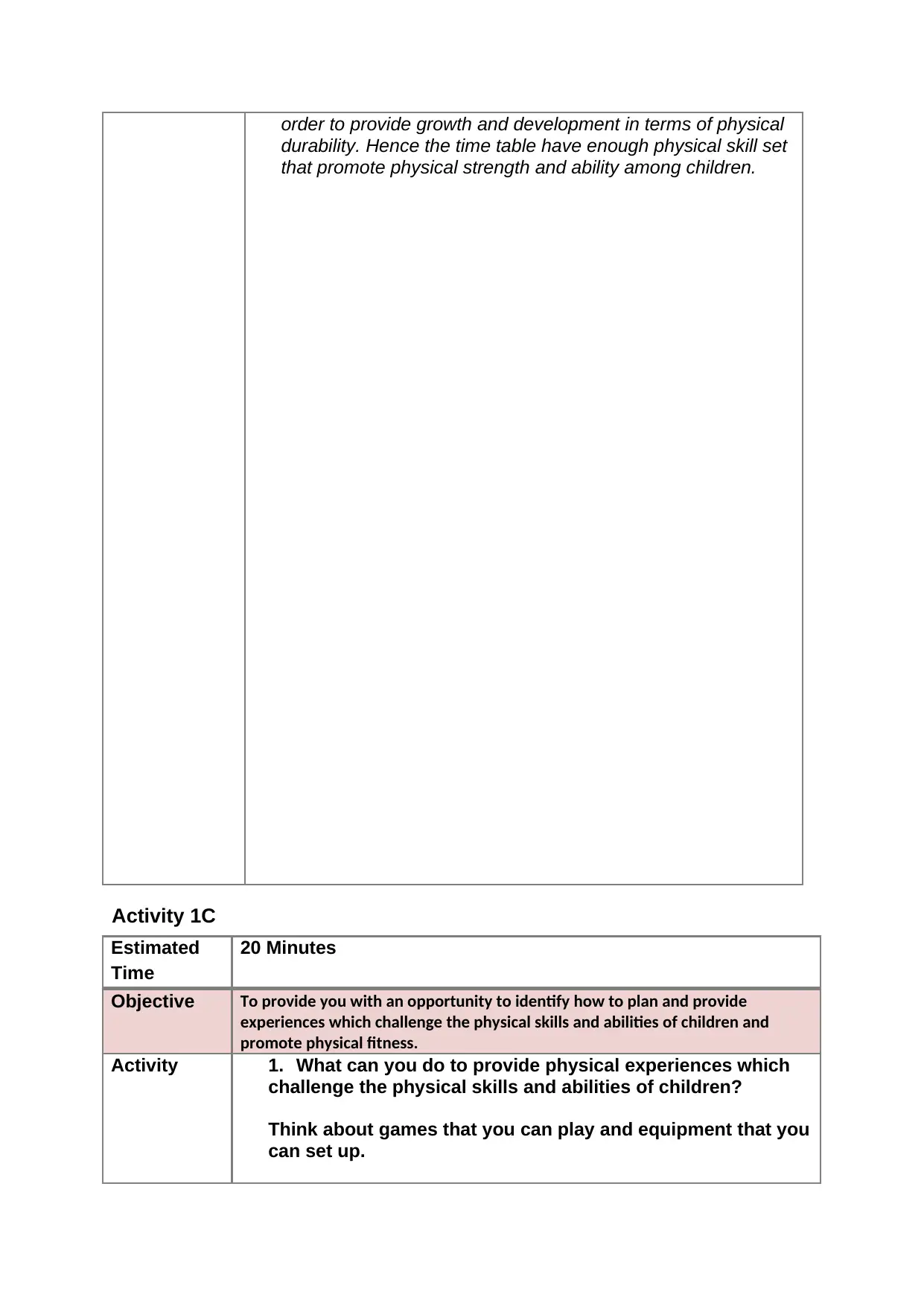
order to provide growth and development in terms of physical
durability. Hence the time table have enough physical skill set
that promote physical strength and ability among children.
Activity 1C
Estimated
Time
20 Minutes
Objective To provide you with an opportunity to identify how to plan and provide
experiences which challenge the physical skills and abilities of children and
promote physical fitness.
Activity 1. What can you do to provide physical experiences which
challenge the physical skills and abilities of children?
Think about games that you can play and equipment that you
can set up.
durability. Hence the time table have enough physical skill set
that promote physical strength and ability among children.
Activity 1C
Estimated
Time
20 Minutes
Objective To provide you with an opportunity to identify how to plan and provide
experiences which challenge the physical skills and abilities of children and
promote physical fitness.
Activity 1. What can you do to provide physical experiences which
challenge the physical skills and abilities of children?
Think about games that you can play and equipment that you
can set up.
Paraphrase This Document
Need a fresh take? Get an instant paraphrase of this document with our AI Paraphraser
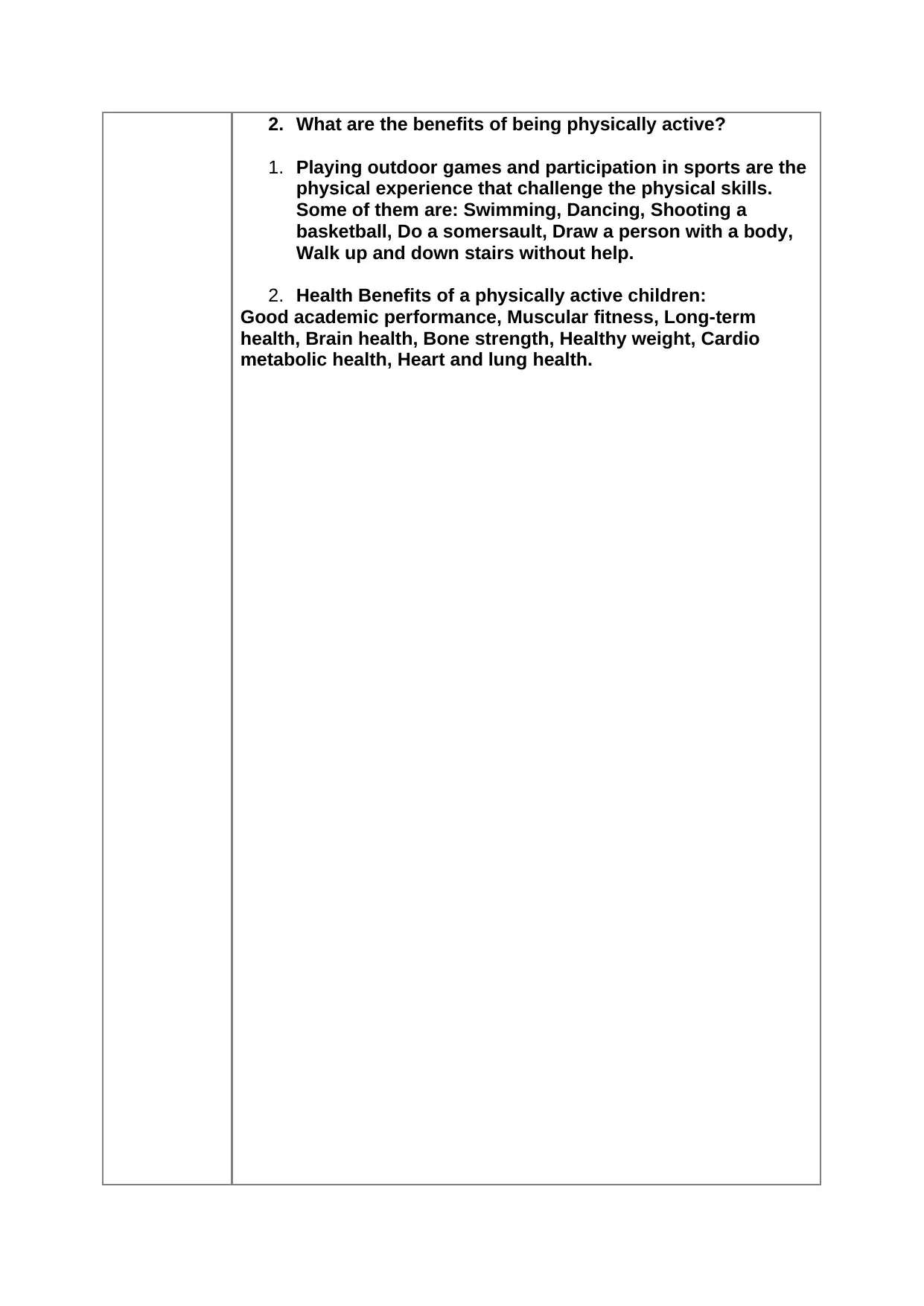
2. What are the benefits of being physically active?
1. Playing outdoor games and participation in sports are the
physical experience that challenge the physical skills.
Some of them are: Swimming, Dancing, Shooting a
basketball, Do a somersault, Draw a person with a body,
Walk up and down stairs without help.
2. Health Benefits of a physically active children:
Good academic performance, Muscular fitness, Long-term
health, Brain health, Bone strength, Healthy weight, Cardio
metabolic health, Heart and lung health.
1. Playing outdoor games and participation in sports are the
physical experience that challenge the physical skills.
Some of them are: Swimming, Dancing, Shooting a
basketball, Do a somersault, Draw a person with a body,
Walk up and down stairs without help.
2. Health Benefits of a physically active children:
Good academic performance, Muscular fitness, Long-term
health, Brain health, Bone strength, Healthy weight, Cardio
metabolic health, Heart and lung health.
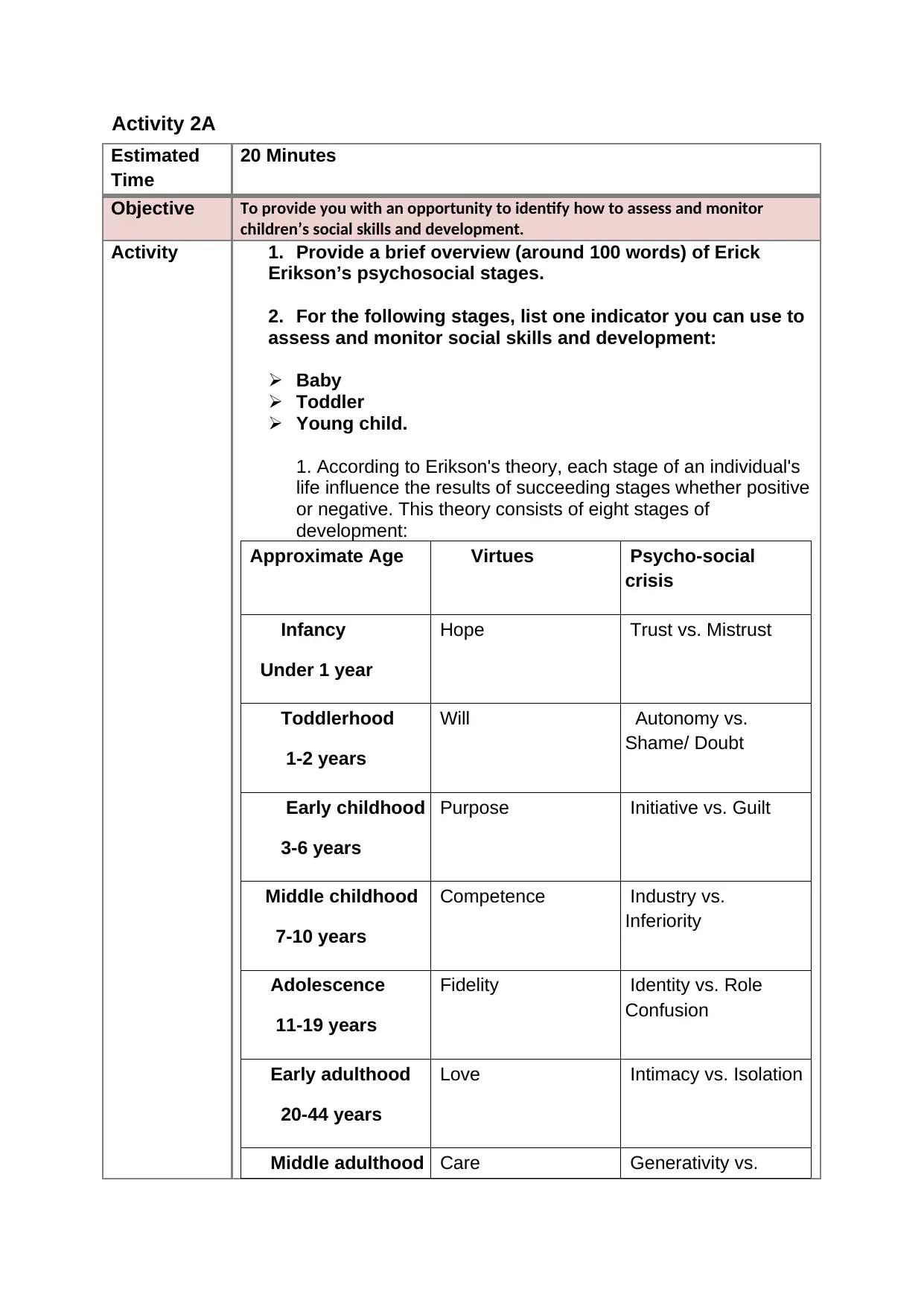
Activity 2A
Estimated
Time
20 Minutes
Objective To provide you with an opportunity to identify how to assess and monitor
children’s social skills and development.
Activity 1. Provide a brief overview (around 100 words) of Erick
Erikson’s psychosocial stages.
2. For the following stages, list one indicator you can use to
assess and monitor social skills and development:
Baby
Toddler
Young child.
1. According to Erikson's theory, each stage of an individual's
life influence the results of succeeding stages whether positive
or negative. This theory consists of eight stages of
development:
Approximate Age Virtues Psycho-social
crisis
Infancy
Under 1 year
Hope Trust vs. Mistrust
Toddlerhood
1-2 years
Will Autonomy vs.
Shame/ Doubt
Early childhood
3-6 years
Purpose Initiative vs. Guilt
Middle childhood
7-10 years
Competence Industry vs.
Inferiority
Adolescence
11-19 years
Fidelity Identity vs. Role
Confusion
Early adulthood
20-44 years
Love Intimacy vs. Isolation
Middle adulthood Care Generativity vs.
Estimated
Time
20 Minutes
Objective To provide you with an opportunity to identify how to assess and monitor
children’s social skills and development.
Activity 1. Provide a brief overview (around 100 words) of Erick
Erikson’s psychosocial stages.
2. For the following stages, list one indicator you can use to
assess and monitor social skills and development:
Baby
Toddler
Young child.
1. According to Erikson's theory, each stage of an individual's
life influence the results of succeeding stages whether positive
or negative. This theory consists of eight stages of
development:
Approximate Age Virtues Psycho-social
crisis
Infancy
Under 1 year
Hope Trust vs. Mistrust
Toddlerhood
1-2 years
Will Autonomy vs.
Shame/ Doubt
Early childhood
3-6 years
Purpose Initiative vs. Guilt
Middle childhood
7-10 years
Competence Industry vs.
Inferiority
Adolescence
11-19 years
Fidelity Identity vs. Role
Confusion
Early adulthood
20-44 years
Love Intimacy vs. Isolation
Middle adulthood Care Generativity vs.
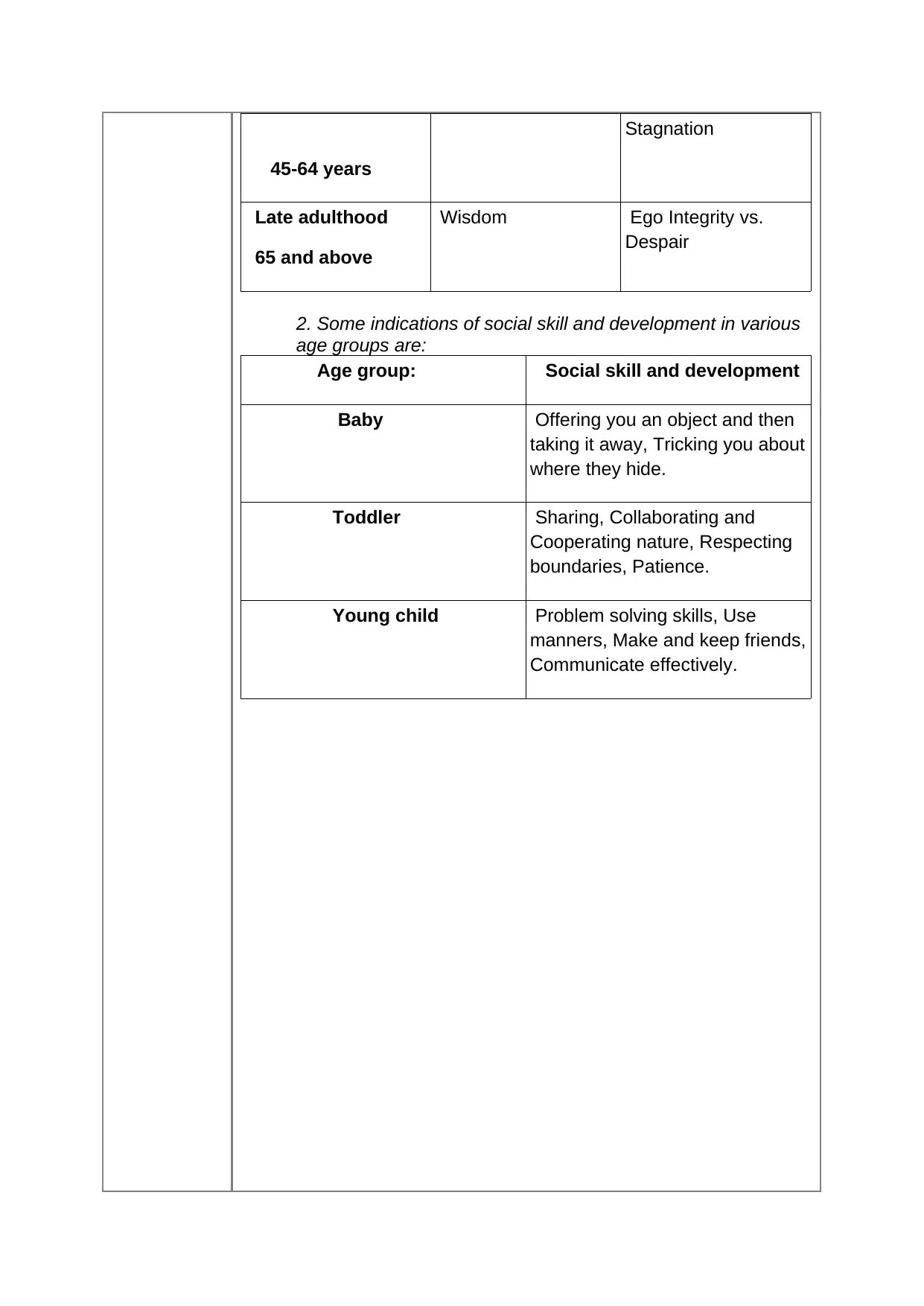
45-64 years
Stagnation
Late adulthood
65 and above
Wisdom Ego Integrity vs.
Despair
2. Some indications of social skill and development in various
age groups are:
Age group: Social skill and development
Baby Offering you an object and then
taking it away, Tricking you about
where they hide.
Toddler Sharing, Collaborating and
Cooperating nature, Respecting
boundaries, Patience.
Young child Problem solving skills, Use
manners, Make and keep friends,
Communicate effectively.
Stagnation
Late adulthood
65 and above
Wisdom Ego Integrity vs.
Despair
2. Some indications of social skill and development in various
age groups are:
Age group: Social skill and development
Baby Offering you an object and then
taking it away, Tricking you about
where they hide.
Toddler Sharing, Collaborating and
Cooperating nature, Respecting
boundaries, Patience.
Young child Problem solving skills, Use
manners, Make and keep friends,
Communicate effectively.
Secure Best Marks with AI Grader
Need help grading? Try our AI Grader for instant feedback on your assignments.
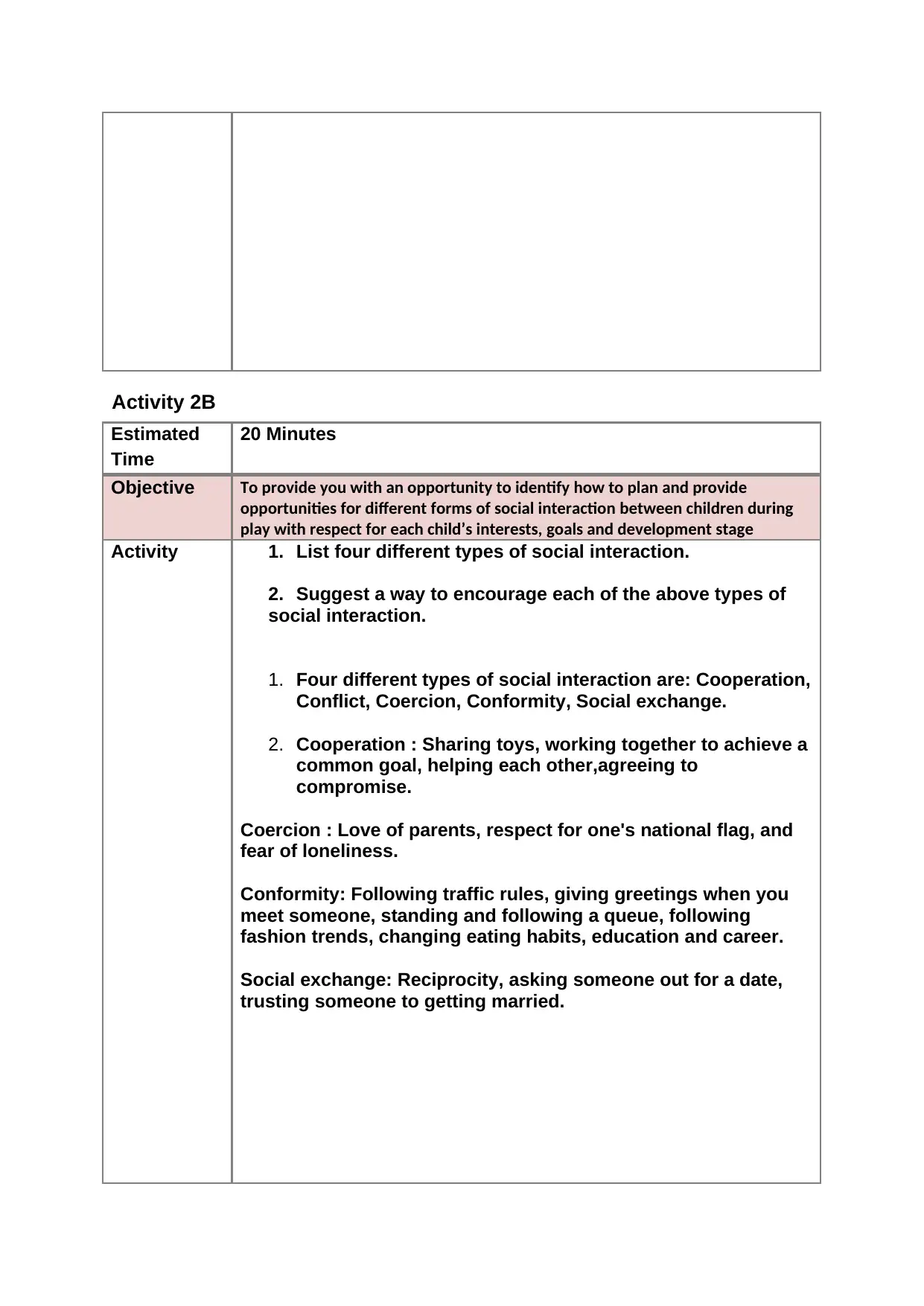
Activity 2B
Estimated
Time
20 Minutes
Objective To provide you with an opportunity to identify how to plan and provide
opportunities for different forms of social interaction between children during
play with respect for each child’s interests, goals and development stage
Activity 1. List four different types of social interaction.
2. Suggest a way to encourage each of the above types of
social interaction.
1. Four different types of social interaction are: Cooperation,
Conflict, Coercion, Conformity, Social exchange.
2. Cooperation : Sharing toys, working together to achieve a
common goal, helping each other,agreeing to
compromise.
Coercion : Love of parents, respect for one's national flag, and
fear of loneliness.
Conformity: Following traffic rules, giving greetings when you
meet someone, standing and following a queue, following
fashion trends, changing eating habits, education and career.
Social exchange: Reciprocity, asking someone out for a date,
trusting someone to getting married.
Estimated
Time
20 Minutes
Objective To provide you with an opportunity to identify how to plan and provide
opportunities for different forms of social interaction between children during
play with respect for each child’s interests, goals and development stage
Activity 1. List four different types of social interaction.
2. Suggest a way to encourage each of the above types of
social interaction.
1. Four different types of social interaction are: Cooperation,
Conflict, Coercion, Conformity, Social exchange.
2. Cooperation : Sharing toys, working together to achieve a
common goal, helping each other,agreeing to
compromise.
Coercion : Love of parents, respect for one's national flag, and
fear of loneliness.
Conformity: Following traffic rules, giving greetings when you
meet someone, standing and following a queue, following
fashion trends, changing eating habits, education and career.
Social exchange: Reciprocity, asking someone out for a date,
trusting someone to getting married.
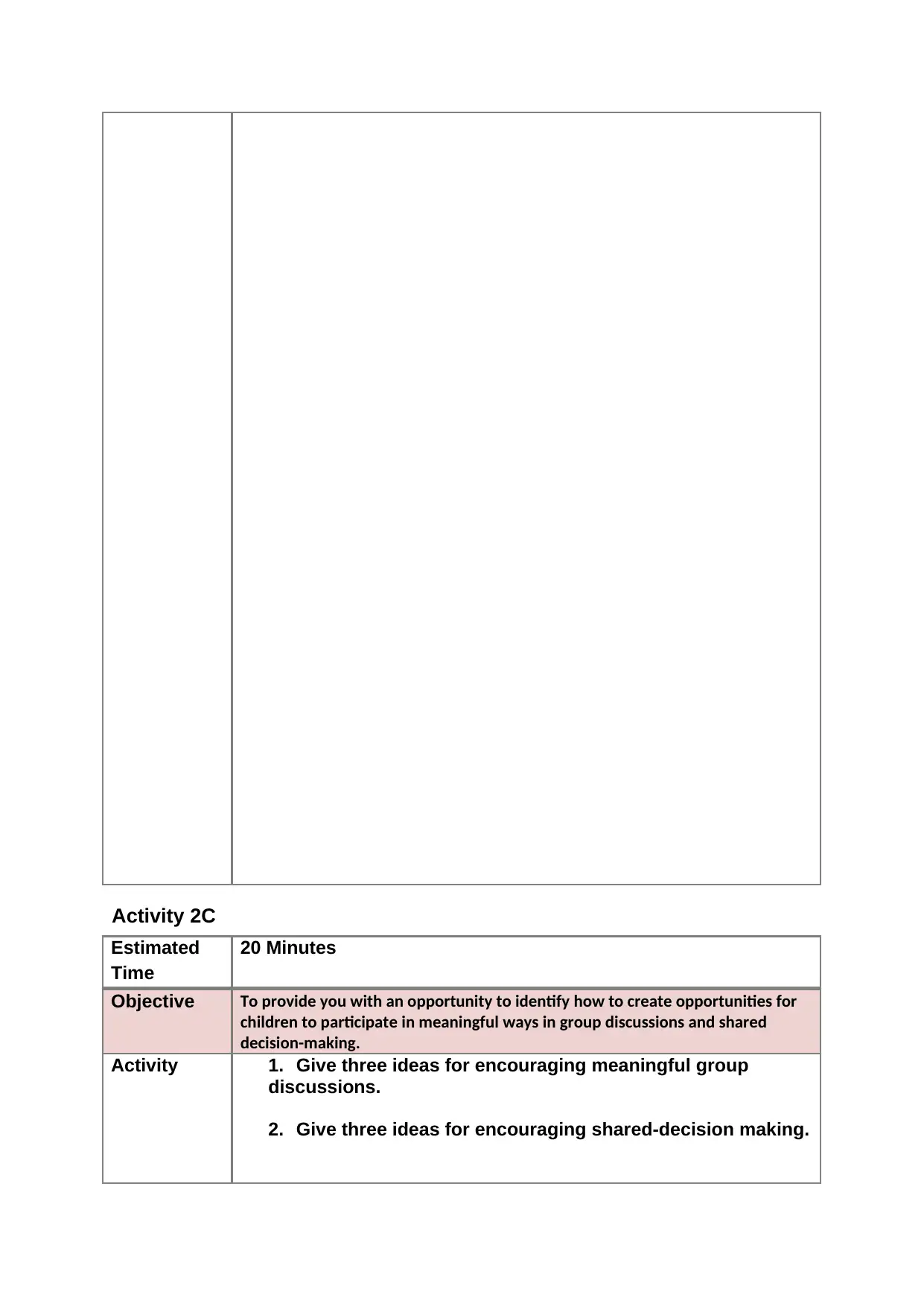
Activity 2C
Estimated
Time
20 Minutes
Objective To provide you with an opportunity to identify how to create opportunities for
children to participate in meaningful ways in group discussions and shared
decision-making.
Activity 1. Give three ideas for encouraging meaningful group
discussions.
2. Give three ideas for encouraging shared-decision making.
Estimated
Time
20 Minutes
Objective To provide you with an opportunity to identify how to create opportunities for
children to participate in meaningful ways in group discussions and shared
decision-making.
Activity 1. Give three ideas for encouraging meaningful group
discussions.
2. Give three ideas for encouraging shared-decision making.
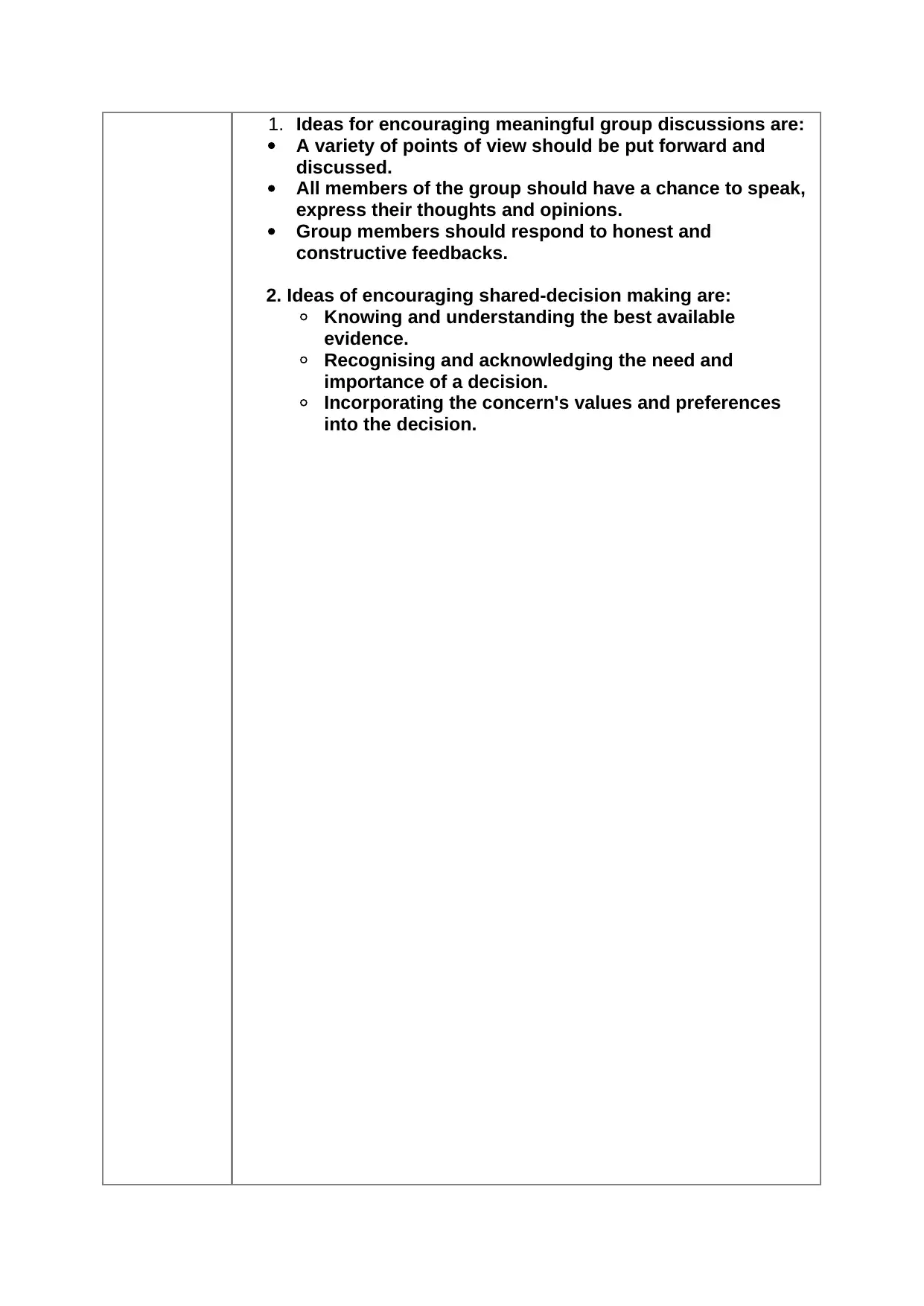
1. Ideas for encouraging meaningful group discussions are:
A variety of points of view should be put forward and
discussed.
All members of the group should have a chance to speak,
express their thoughts and opinions.
Group members should respond to honest and
constructive feedbacks.
2. Ideas of encouraging shared-decision making are:
◦ Knowing and understanding the best available
evidence.
◦ Recognising and acknowledging the need and
importance of a decision.
◦ Incorporating the concern's values and preferences
into the decision.
A variety of points of view should be put forward and
discussed.
All members of the group should have a chance to speak,
express their thoughts and opinions.
Group members should respond to honest and
constructive feedbacks.
2. Ideas of encouraging shared-decision making are:
◦ Knowing and understanding the best available
evidence.
◦ Recognising and acknowledging the need and
importance of a decision.
◦ Incorporating the concern's values and preferences
into the decision.
Paraphrase This Document
Need a fresh take? Get an instant paraphrase of this document with our AI Paraphraser
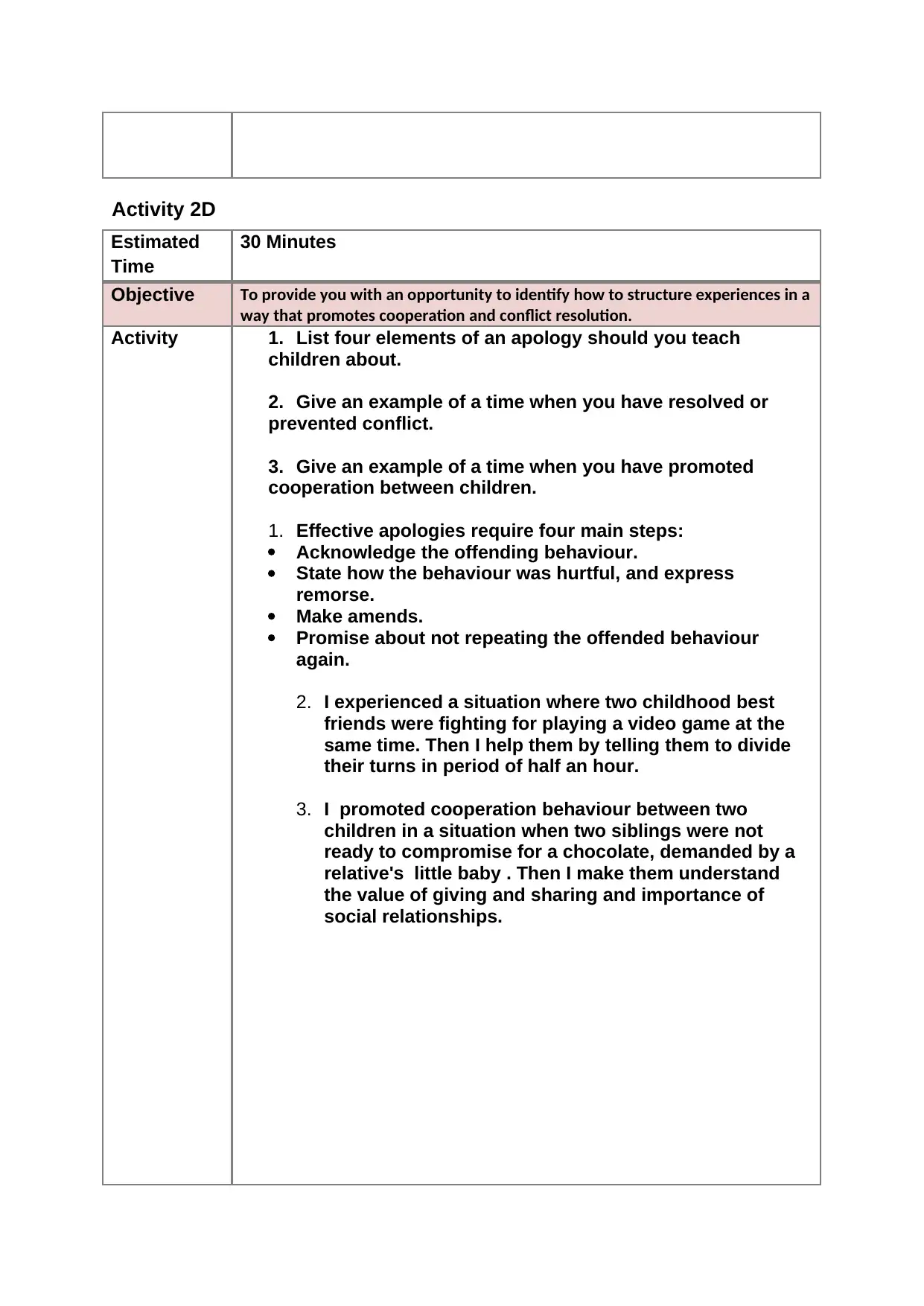
Activity 2D
Estimated
Time
30 Minutes
Objective To provide you with an opportunity to identify how to structure experiences in a
way that promotes cooperation and conflict resolution.
Activity 1. List four elements of an apology should you teach
children about.
2. Give an example of a time when you have resolved or
prevented conflict.
3. Give an example of a time when you have promoted
cooperation between children.
1. Effective apologies require four main steps:
Acknowledge the offending behaviour.
State how the behaviour was hurtful, and express
remorse.
Make amends.
Promise about not repeating the offended behaviour
again.
2. I experienced a situation where two childhood best
friends were fighting for playing a video game at the
same time. Then I help them by telling them to divide
their turns in period of half an hour.
3. I promoted cooperation behaviour between two
children in a situation when two siblings were not
ready to compromise for a chocolate, demanded by a
relative's little baby . Then I make them understand
the value of giving and sharing and importance of
social relationships.
Estimated
Time
30 Minutes
Objective To provide you with an opportunity to identify how to structure experiences in a
way that promotes cooperation and conflict resolution.
Activity 1. List four elements of an apology should you teach
children about.
2. Give an example of a time when you have resolved or
prevented conflict.
3. Give an example of a time when you have promoted
cooperation between children.
1. Effective apologies require four main steps:
Acknowledge the offending behaviour.
State how the behaviour was hurtful, and express
remorse.
Make amends.
Promise about not repeating the offended behaviour
again.
2. I experienced a situation where two childhood best
friends were fighting for playing a video game at the
same time. Then I help them by telling them to divide
their turns in period of half an hour.
3. I promoted cooperation behaviour between two
children in a situation when two siblings were not
ready to compromise for a chocolate, demanded by a
relative's little baby . Then I make them understand
the value of giving and sharing and importance of
social relationships.

Activity 2E
Estimated
Time
15 Minutes
Objective To provide you with an opportunity to identify how to promote a sense of
community within the service.
Activity Explain in around 200 words what do you do in your setting to
promote a sense of community within the service.
You may wish to reference:
Communication with caregivers
Trips into the community
Empowering children.
1. Researchers have showed that children who are active
enough to make their identity within a group are
successful ones in academic performances and have
ability to adjust in every situation and find a way to cope
up with it. They are good with maintaining relationships
and co-operating schedules within work and studies.
Some of the most important skills children need to
develop for lead a successful life are communication
skills, interest towards social interaction, collaboration
and problem solving skills by itself. There are many ways
Estimated
Time
15 Minutes
Objective To provide you with an opportunity to identify how to promote a sense of
community within the service.
Activity Explain in around 200 words what do you do in your setting to
promote a sense of community within the service.
You may wish to reference:
Communication with caregivers
Trips into the community
Empowering children.
1. Researchers have showed that children who are active
enough to make their identity within a group are
successful ones in academic performances and have
ability to adjust in every situation and find a way to cope
up with it. They are good with maintaining relationships
and co-operating schedules within work and studies.
Some of the most important skills children need to
develop for lead a successful life are communication
skills, interest towards social interaction, collaboration
and problem solving skills by itself. There are many ways

to build a sense of community are:
Get involved with community organisation : Promote and
wake up interest of children towards care taking of
community by explaining them the importance and
goodness of participating with help-providing
organisations. Bring the children to libraries, gyms,
churches.
Hold a neighbourhood drive : Promote the children to get
outside , take active participation in community-related
activities. Take them to charitable events, expose them to
the reality of world and motivate them to make at least a
small change towards environment. Allowing them to host
a neighbourhood clothing or food drive; to deliver foods
and clothes to the ones who are in need.
Celebrate the good times : Participate in neighbouring
parties and take your children along with you. Promote
their interest in making new friends, establish new
relationships with neighbours, invite them in parties.
Children should have a tendency to enjoy and share their
feelings and emotions.
Get involved with community organisation : Promote and
wake up interest of children towards care taking of
community by explaining them the importance and
goodness of participating with help-providing
organisations. Bring the children to libraries, gyms,
churches.
Hold a neighbourhood drive : Promote the children to get
outside , take active participation in community-related
activities. Take them to charitable events, expose them to
the reality of world and motivate them to make at least a
small change towards environment. Allowing them to host
a neighbourhood clothing or food drive; to deliver foods
and clothes to the ones who are in need.
Celebrate the good times : Participate in neighbouring
parties and take your children along with you. Promote
their interest in making new friends, establish new
relationships with neighbours, invite them in parties.
Children should have a tendency to enjoy and share their
feelings and emotions.
Secure Best Marks with AI Grader
Need help grading? Try our AI Grader for instant feedback on your assignments.
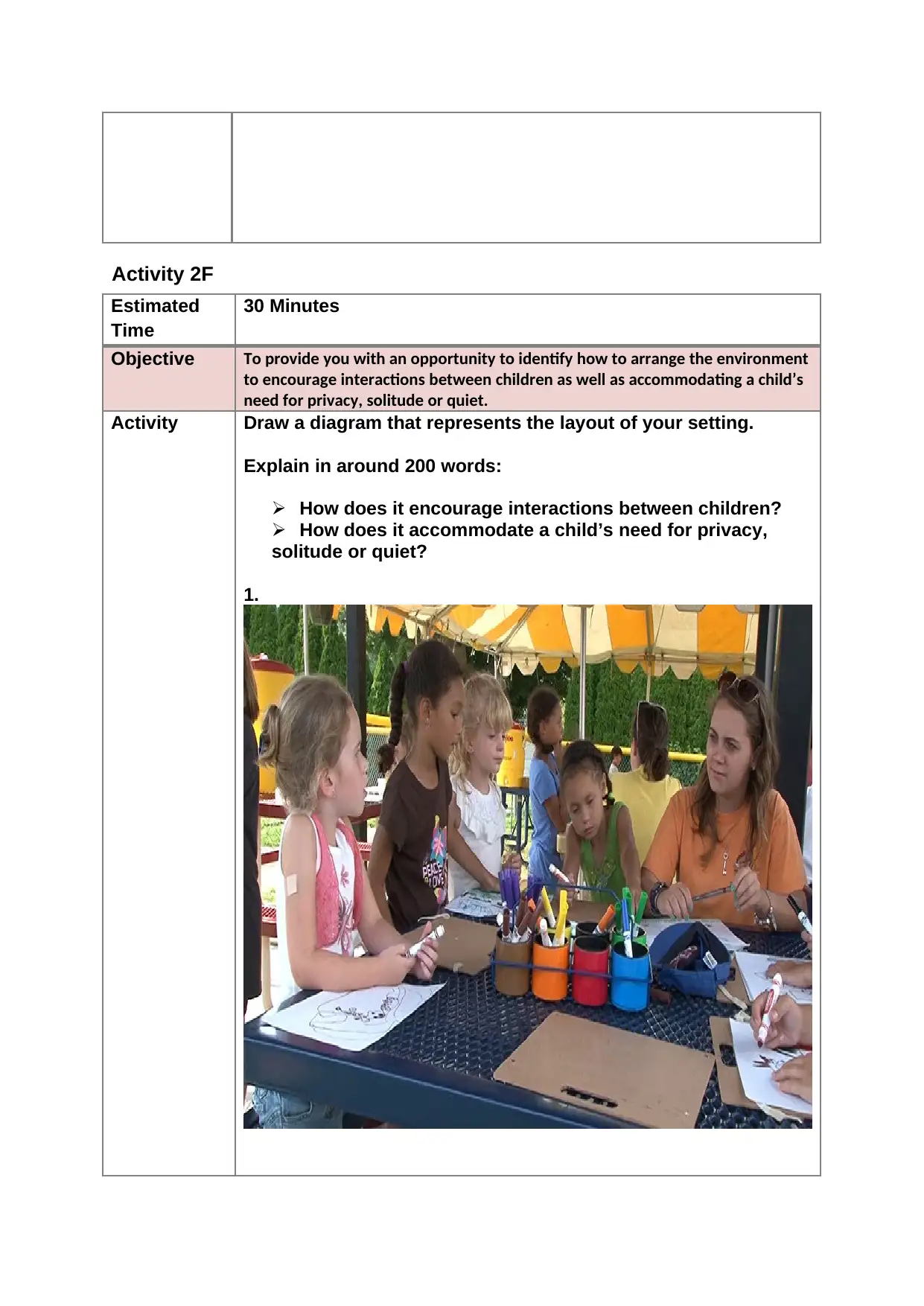
Activity 2F
Estimated
Time
30 Minutes
Objective To provide you with an opportunity to identify how to arrange the environment
to encourage interactions between children as well as accommodating a child’s
need for privacy, solitude or quiet.
Activity Draw a diagram that represents the layout of your setting.
Explain in around 200 words:
How does it encourage interactions between children?
How does it accommodate a child’s need for privacy,
solitude or quiet?
1.
Estimated
Time
30 Minutes
Objective To provide you with an opportunity to identify how to arrange the environment
to encourage interactions between children as well as accommodating a child’s
need for privacy, solitude or quiet.
Activity Draw a diagram that represents the layout of your setting.
Explain in around 200 words:
How does it encourage interactions between children?
How does it accommodate a child’s need for privacy,
solitude or quiet?
1.

2. It is Important to have interaction between children .
Communication helps in gain information learn different
language and develop social skills. Difficulty in conversation
may reduce self esteem and affect the confidence of coming
forward. Some strategies can be followed to encourage the
interaction among children.
Set up small groups: Allow children to engage in group by making
friends, encourage them to involve in some role plays. Interact with
each child in the group, observe which child is less participating and
feels left over , encourage him/ her to get involve.
Direct conversations away from yourself : It's always a good idea
to initiate interesting conversation with children and discuss about
any of the TV show they used to watch, try to open up with them that
what they think about any particular character, what according to
their prediction; will be the character's next move, what did they
learn from the movie/ show, why would they liked it.
Creates a physical environment that promotes small groups :
Create bookshelves, art corner in a room, limit materials so children
have to share things with each other.
2. In order to provide solitude and quite place to children; it is
important to give them some privacy where they can rest, take a nap
and able to spend some “ME TIME” without any interruption.
Respecting children's privacy is a part of a good parenting. Resting
time create a calm mood for sleeping, quiet play or get indulged in
crafts and arts of their own interest.
Communication helps in gain information learn different
language and develop social skills. Difficulty in conversation
may reduce self esteem and affect the confidence of coming
forward. Some strategies can be followed to encourage the
interaction among children.
Set up small groups: Allow children to engage in group by making
friends, encourage them to involve in some role plays. Interact with
each child in the group, observe which child is less participating and
feels left over , encourage him/ her to get involve.
Direct conversations away from yourself : It's always a good idea
to initiate interesting conversation with children and discuss about
any of the TV show they used to watch, try to open up with them that
what they think about any particular character, what according to
their prediction; will be the character's next move, what did they
learn from the movie/ show, why would they liked it.
Creates a physical environment that promotes small groups :
Create bookshelves, art corner in a room, limit materials so children
have to share things with each other.
2. In order to provide solitude and quite place to children; it is
important to give them some privacy where they can rest, take a nap
and able to spend some “ME TIME” without any interruption.
Respecting children's privacy is a part of a good parenting. Resting
time create a calm mood for sleeping, quiet play or get indulged in
crafts and arts of their own interest.
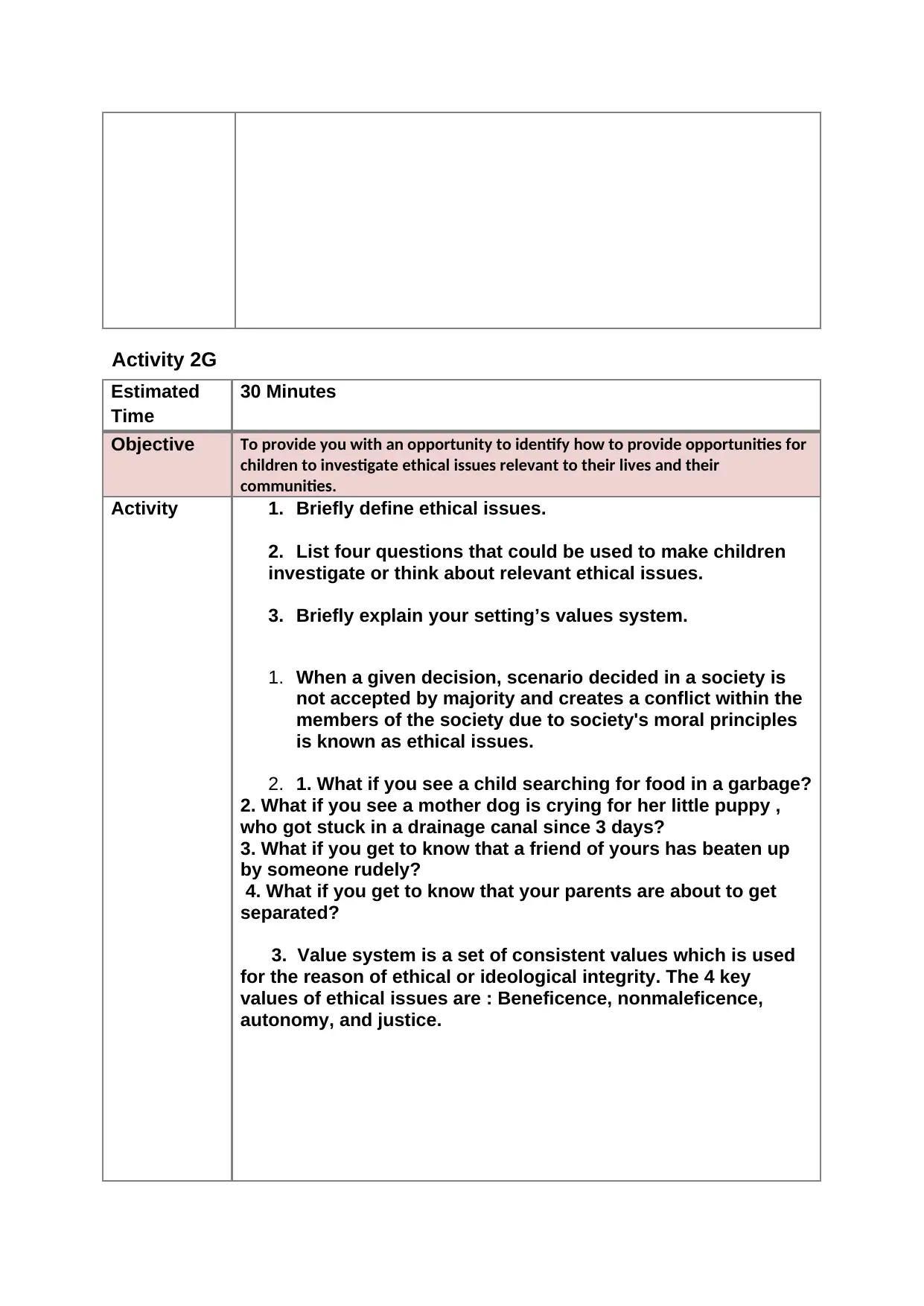
Activity 2G
Estimated
Time
30 Minutes
Objective To provide you with an opportunity to identify how to provide opportunities for
children to investigate ethical issues relevant to their lives and their
communities.
Activity 1. Briefly define ethical issues.
2. List four questions that could be used to make children
investigate or think about relevant ethical issues.
3. Briefly explain your setting’s values system.
1. When a given decision, scenario decided in a society is
not accepted by majority and creates a conflict within the
members of the society due to society's moral principles
is known as ethical issues.
2. 1. What if you see a child searching for food in a garbage?
2. What if you see a mother dog is crying for her little puppy ,
who got stuck in a drainage canal since 3 days?
3. What if you get to know that a friend of yours has beaten up
by someone rudely?
4. What if you get to know that your parents are about to get
separated?
3. Value system is a set of consistent values which is used
for the reason of ethical or ideological integrity. The 4 key
values of ethical issues are : Beneficence, nonmaleficence,
autonomy, and justice.
Estimated
Time
30 Minutes
Objective To provide you with an opportunity to identify how to provide opportunities for
children to investigate ethical issues relevant to their lives and their
communities.
Activity 1. Briefly define ethical issues.
2. List four questions that could be used to make children
investigate or think about relevant ethical issues.
3. Briefly explain your setting’s values system.
1. When a given decision, scenario decided in a society is
not accepted by majority and creates a conflict within the
members of the society due to society's moral principles
is known as ethical issues.
2. 1. What if you see a child searching for food in a garbage?
2. What if you see a mother dog is crying for her little puppy ,
who got stuck in a drainage canal since 3 days?
3. What if you get to know that a friend of yours has beaten up
by someone rudely?
4. What if you get to know that your parents are about to get
separated?
3. Value system is a set of consistent values which is used
for the reason of ethical or ideological integrity. The 4 key
values of ethical issues are : Beneficence, nonmaleficence,
autonomy, and justice.
Paraphrase This Document
Need a fresh take? Get an instant paraphrase of this document with our AI Paraphraser

Activity 1A to 2G checklist – for assessor
This should be used by the trainer/assessor to document the learner’s skills,
knowledge and performance as relevant to the unit activity. Indicate in the table
below if the learner is deemed satisfactory (S) or not satisfactory (NS) for the activity
or if reassessment is required.
Learner’s name
Assessor’s name
Unit of Competence
(Code and Title)
CHCECE017 - Foster the
holistic development and
wellbeing of the child in early
childhood
Date(s) of assessment
This should be used by the trainer/assessor to document the learner’s skills,
knowledge and performance as relevant to the unit activity. Indicate in the table
below if the learner is deemed satisfactory (S) or not satisfactory (NS) for the activity
or if reassessment is required.
Learner’s name
Assessor’s name
Unit of Competence
(Code and Title)
CHCECE017 - Foster the
holistic development and
wellbeing of the child in early
childhood
Date(s) of assessment

Has the activity been answered and performed fully, as required to
assess the competency of the learner? Y
e
s
N
o
(
P
l
e
a
s
e
c
i
r
c
l
e
)
Has sufficient evidence and information been provided by the learner
for the activity? Y
e
s
N
o
(
P
l
e
a
s
e
c
i
r
c
l
e
)
The learner’s
performance
was:
Not yet satisfactory Satisfactory
If not yet satisfactory, date for reassessment:
Feedback to learner:
assess the competency of the learner? Y
e
s
N
o
(
P
l
e
a
s
e
c
i
r
c
l
e
)
Has sufficient evidence and information been provided by the learner
for the activity? Y
e
s
N
o
(
P
l
e
a
s
e
c
i
r
c
l
e
)
The learner’s
performance
was:
Not yet satisfactory Satisfactory
If not yet satisfactory, date for reassessment:
Feedback to learner:
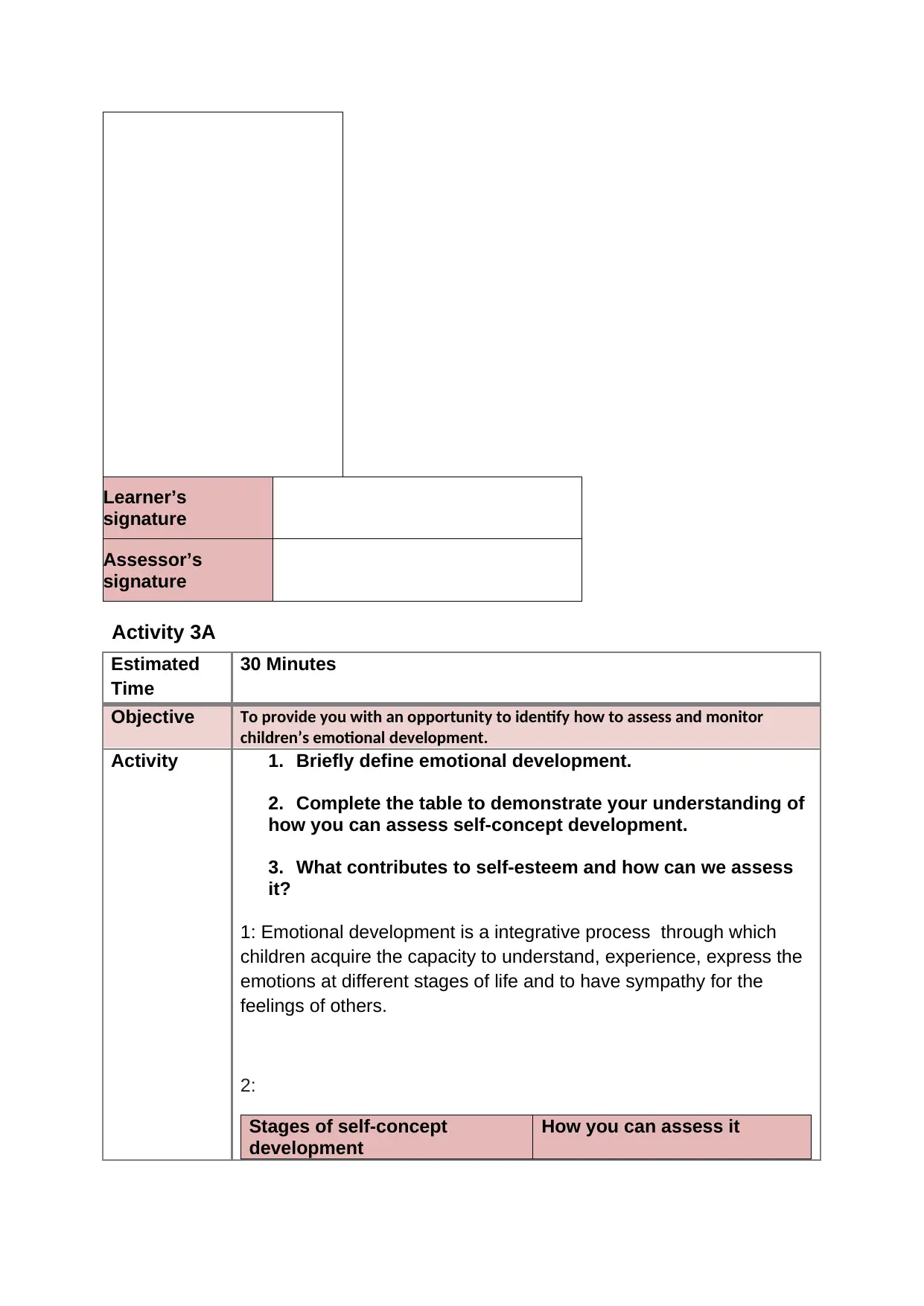
Learner’s
signature
Assessor’s
signature
Activity 3A
Estimated
Time
30 Minutes
Objective To provide you with an opportunity to identify how to assess and monitor
children’s emotional development.
Activity 1. Briefly define emotional development.
2. Complete the table to demonstrate your understanding of
how you can assess self-concept development.
3. What contributes to self-esteem and how can we assess
it?
1: Emotional development is a integrative process through which
children acquire the capacity to understand, experience, express the
emotions at different stages of life and to have sympathy for the
feelings of others.
2:
Stages of self-concept
development
How you can assess it
signature
Assessor’s
signature
Activity 3A
Estimated
Time
30 Minutes
Objective To provide you with an opportunity to identify how to assess and monitor
children’s emotional development.
Activity 1. Briefly define emotional development.
2. Complete the table to demonstrate your understanding of
how you can assess self-concept development.
3. What contributes to self-esteem and how can we assess
it?
1: Emotional development is a integrative process through which
children acquire the capacity to understand, experience, express the
emotions at different stages of life and to have sympathy for the
feelings of others.
2:
Stages of self-concept
development
How you can assess it
Secure Best Marks with AI Grader
Need help grading? Try our AI Grader for instant feedback on your assignments.
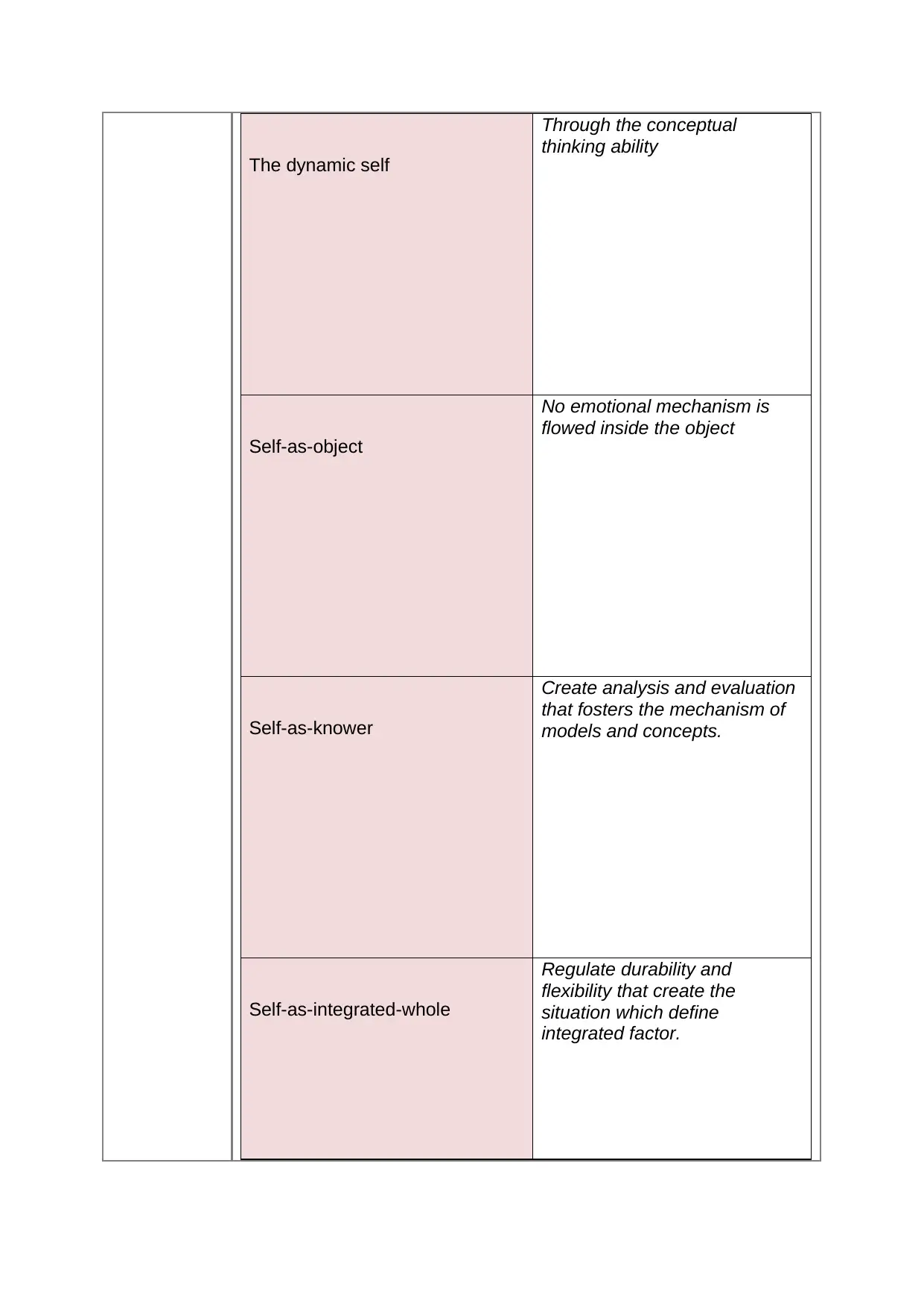
The dynamic self
Through the conceptual
thinking ability
Self-as-object
No emotional mechanism is
flowed inside the object
Self-as-knower
Create analysis and evaluation
that fosters the mechanism of
models and concepts.
Self-as-integrated-whole
Regulate durability and
flexibility that create the
situation which define
integrated factor.
Through the conceptual
thinking ability
Self-as-object
No emotional mechanism is
flowed inside the object
Self-as-knower
Create analysis and evaluation
that fosters the mechanism of
models and concepts.
Self-as-integrated-whole
Regulate durability and
flexibility that create the
situation which define
integrated factor.
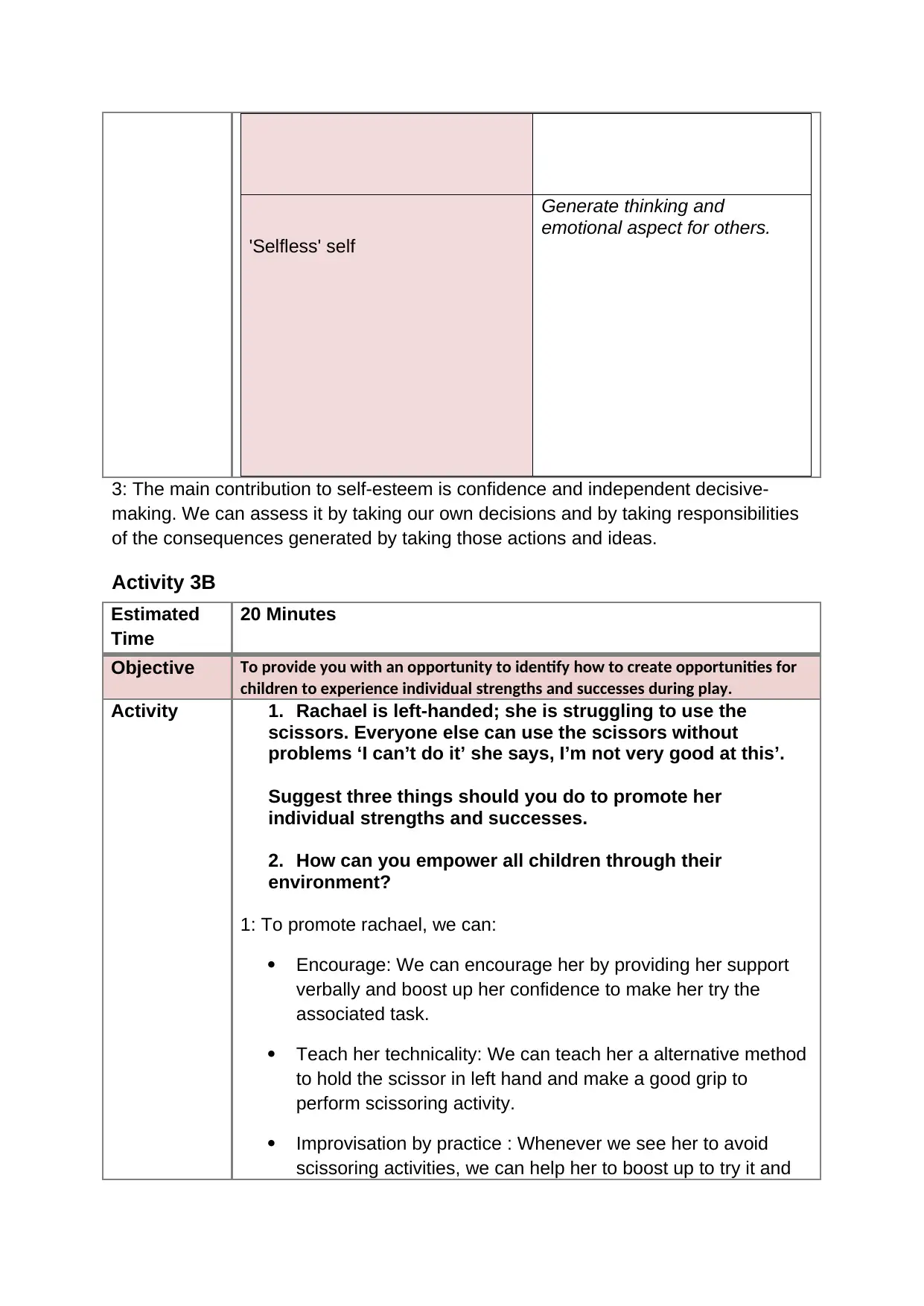
'Selfless' self
Generate thinking and
emotional aspect for others.
3: The main contribution to self-esteem is confidence and independent decisive-
making. We can assess it by taking our own decisions and by taking responsibilities
of the consequences generated by taking those actions and ideas.
Activity 3B
Estimated
Time
20 Minutes
Objective To provide you with an opportunity to identify how to create opportunities for
children to experience individual strengths and successes during play.
Activity 1. Rachael is left-handed; she is struggling to use the
scissors. Everyone else can use the scissors without
problems ‘I can’t do it’ she says, I’m not very good at this’.
Suggest three things should you do to promote her
individual strengths and successes.
2. How can you empower all children through their
environment?
1: To promote rachael, we can:
Encourage: We can encourage her by providing her support
verbally and boost up her confidence to make her try the
associated task.
Teach her technicality: We can teach her a alternative method
to hold the scissor in left hand and make a good grip to
perform scissoring activity.
Improvisation by practice : Whenever we see her to avoid
scissoring activities, we can help her to boost up to try it and
Generate thinking and
emotional aspect for others.
3: The main contribution to self-esteem is confidence and independent decisive-
making. We can assess it by taking our own decisions and by taking responsibilities
of the consequences generated by taking those actions and ideas.
Activity 3B
Estimated
Time
20 Minutes
Objective To provide you with an opportunity to identify how to create opportunities for
children to experience individual strengths and successes during play.
Activity 1. Rachael is left-handed; she is struggling to use the
scissors. Everyone else can use the scissors without
problems ‘I can’t do it’ she says, I’m not very good at this’.
Suggest three things should you do to promote her
individual strengths and successes.
2. How can you empower all children through their
environment?
1: To promote rachael, we can:
Encourage: We can encourage her by providing her support
verbally and boost up her confidence to make her try the
associated task.
Teach her technicality: We can teach her a alternative method
to hold the scissor in left hand and make a good grip to
perform scissoring activity.
Improvisation by practice : Whenever we see her to avoid
scissoring activities, we can help her to boost up to try it and

ensure that she make it a practice until she get her hands set
on it.
2: It is important to empower children from a young age using
positive parenting . It helps them to shape-up and develop good
character and a better person.
By promoting child to raise their voice and speak up whenever they
feel to do so.
By discouraging injustice and gender stereotyping.
By explaining them the motive behind the task you gave to them. So
that thy will be able to understand the seriousness and reason
behind why and what they are going to do. And they can complete
the task with full enthusiasm.
Make a habit to listen and talk to them and engage with them to
openly talk about their likes and dislikes. Reason behind their like
and dislike behaviour towards anything. Listen to their opinions, will
encourage them to gather information regarding right and wrong-
doing and analyse a difference.
on it.
2: It is important to empower children from a young age using
positive parenting . It helps them to shape-up and develop good
character and a better person.
By promoting child to raise their voice and speak up whenever they
feel to do so.
By discouraging injustice and gender stereotyping.
By explaining them the motive behind the task you gave to them. So
that thy will be able to understand the seriousness and reason
behind why and what they are going to do. And they can complete
the task with full enthusiasm.
Make a habit to listen and talk to them and engage with them to
openly talk about their likes and dislikes. Reason behind their like
and dislike behaviour towards anything. Listen to their opinions, will
encourage them to gather information regarding right and wrong-
doing and analyse a difference.
Paraphrase This Document
Need a fresh take? Get an instant paraphrase of this document with our AI Paraphraser


Activity 3C
Estimated
Time
20 Minutes
Objective To provide you with an opportunity to identify how to plan and provide
opportunities through play that challenge children’s emerging skills and
capabilities.
Activity Provide three examples of children’s current or emerging
skills. For each, note what area the skill is in and what you
can do to challenge the skill.
Some examples of life skills that play promotes:
1: Spatial skills and coordination: Constructive play allows
children to better understand basic functions like, drawing,
painting, stacking, constructing. We can challenge their skills by
giving them some task like, giving a picture and tell them to draw
much close to it, tell them to stack coins to a particular height,
etc.
2: Communication and negotiation skills: Being engaged in
cooperative activities like playing with friends, family or relatives
always helps to develop negotiation skills. While going out with
friends and family and waiting for their chance to get a turn on
slides is also a example of developing sharing and patience,
cooperation and self control.
3: Pre - Reading and reading comprehension skills: Reading and
writing is also a fundamental part of the development of language
skills.
Estimated
Time
20 Minutes
Objective To provide you with an opportunity to identify how to plan and provide
opportunities through play that challenge children’s emerging skills and
capabilities.
Activity Provide three examples of children’s current or emerging
skills. For each, note what area the skill is in and what you
can do to challenge the skill.
Some examples of life skills that play promotes:
1: Spatial skills and coordination: Constructive play allows
children to better understand basic functions like, drawing,
painting, stacking, constructing. We can challenge their skills by
giving them some task like, giving a picture and tell them to draw
much close to it, tell them to stack coins to a particular height,
etc.
2: Communication and negotiation skills: Being engaged in
cooperative activities like playing with friends, family or relatives
always helps to develop negotiation skills. While going out with
friends and family and waiting for their chance to get a turn on
slides is also a example of developing sharing and patience,
cooperation and self control.
3: Pre - Reading and reading comprehension skills: Reading and
writing is also a fundamental part of the development of language
skills.
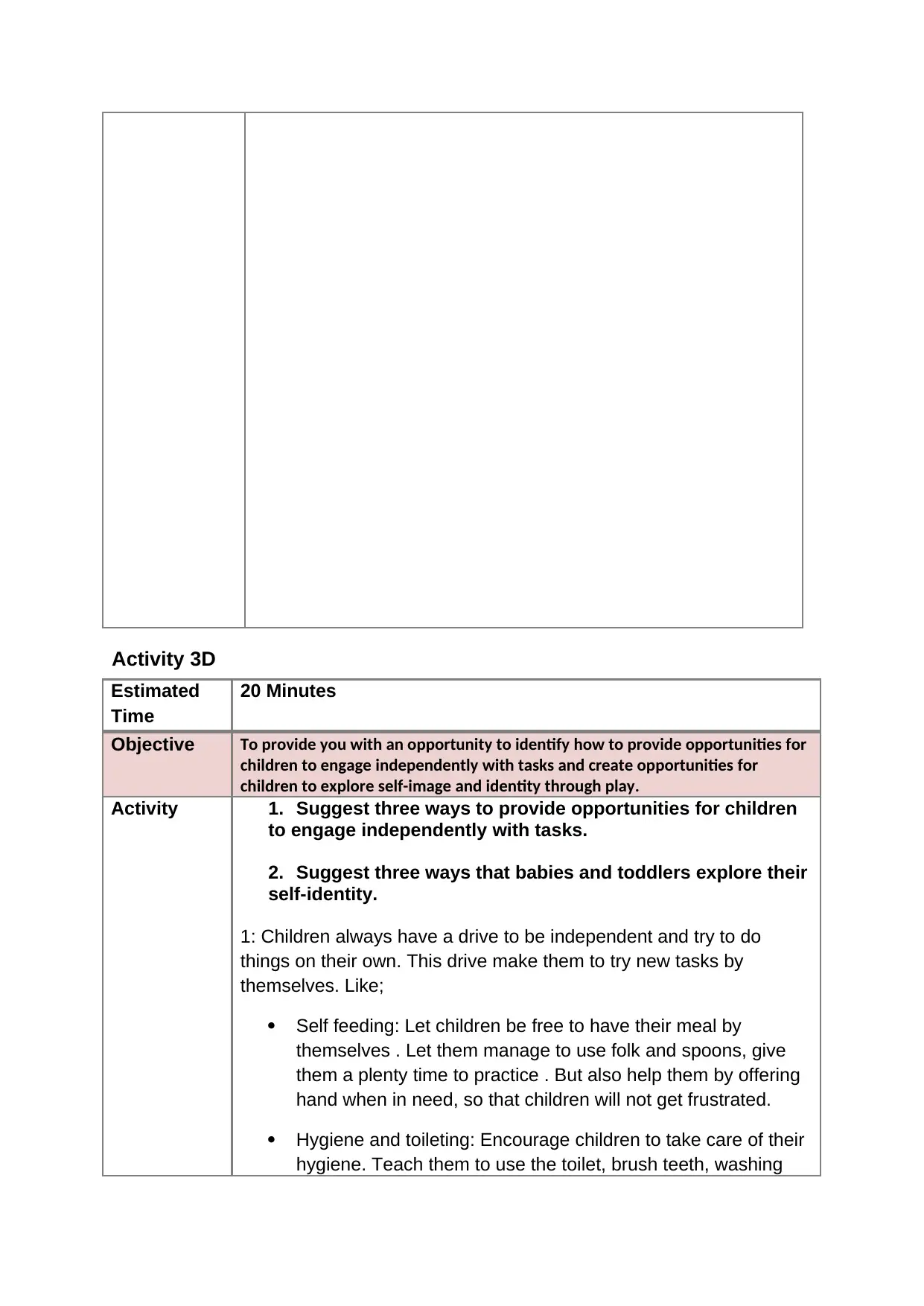
Activity 3D
Estimated
Time
20 Minutes
Objective To provide you with an opportunity to identify how to provide opportunities for
children to engage independently with tasks and create opportunities for
children to explore self-image and identity through play.
Activity 1. Suggest three ways to provide opportunities for children
to engage independently with tasks.
2. Suggest three ways that babies and toddlers explore their
self-identity.
1: Children always have a drive to be independent and try to do
things on their own. This drive make them to try new tasks by
themselves. Like;
Self feeding: Let children be free to have their meal by
themselves . Let them manage to use folk and spoons, give
them a plenty time to practice . But also help them by offering
hand when in need, so that children will not get frustrated.
Hygiene and toileting: Encourage children to take care of their
hygiene. Teach them to use the toilet, brush teeth, washing
Estimated
Time
20 Minutes
Objective To provide you with an opportunity to identify how to provide opportunities for
children to engage independently with tasks and create opportunities for
children to explore self-image and identity through play.
Activity 1. Suggest three ways to provide opportunities for children
to engage independently with tasks.
2. Suggest three ways that babies and toddlers explore their
self-identity.
1: Children always have a drive to be independent and try to do
things on their own. This drive make them to try new tasks by
themselves. Like;
Self feeding: Let children be free to have their meal by
themselves . Let them manage to use folk and spoons, give
them a plenty time to practice . But also help them by offering
hand when in need, so that children will not get frustrated.
Hygiene and toileting: Encourage children to take care of their
hygiene. Teach them to use the toilet, brush teeth, washing
Secure Best Marks with AI Grader
Need help grading? Try our AI Grader for instant feedback on your assignments.
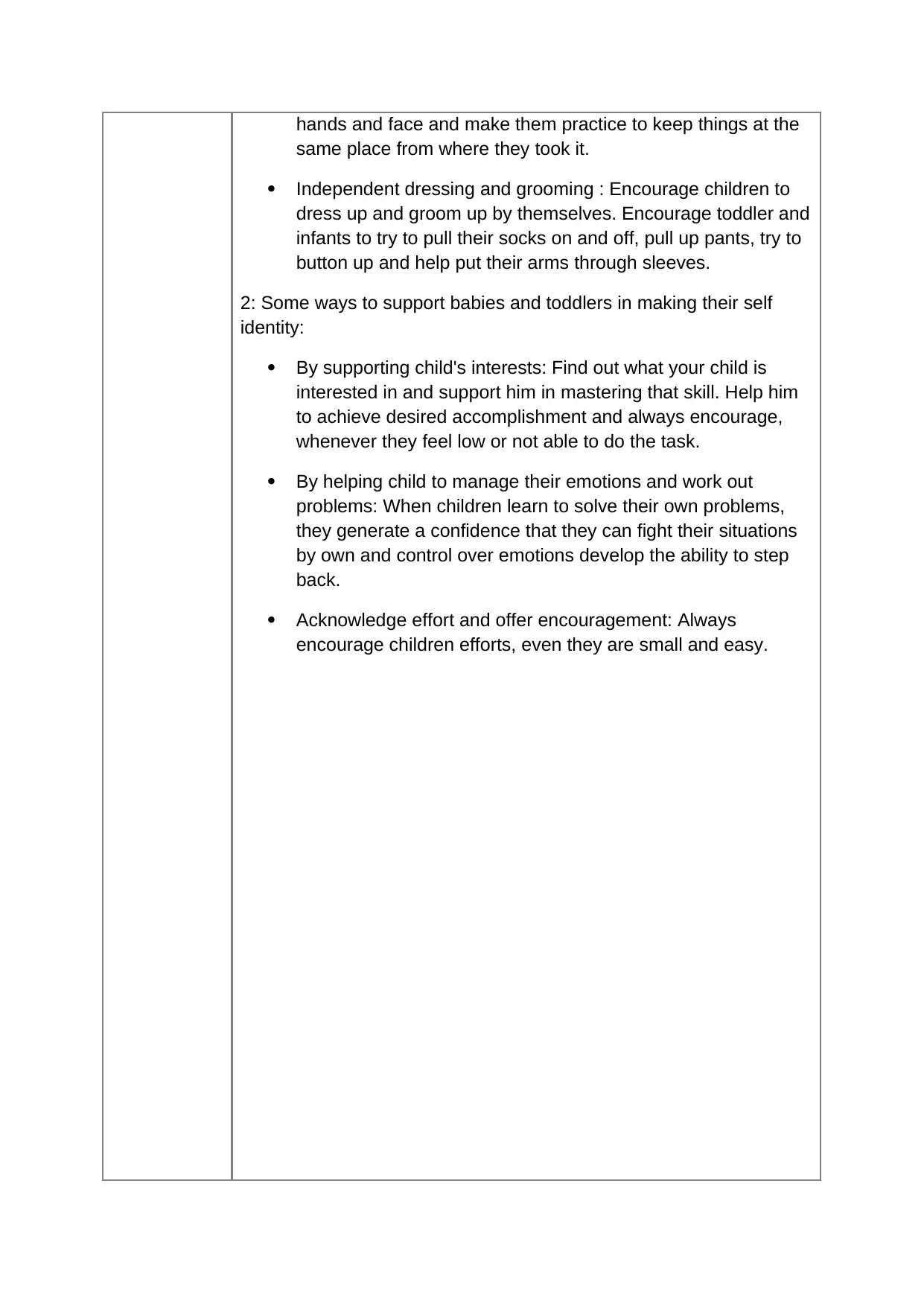
hands and face and make them practice to keep things at the
same place from where they took it.
Independent dressing and grooming : Encourage children to
dress up and groom up by themselves. Encourage toddler and
infants to try to pull their socks on and off, pull up pants, try to
button up and help put their arms through sleeves.
2: Some ways to support babies and toddlers in making their self
identity:
By supporting child's interests: Find out what your child is
interested in and support him in mastering that skill. Help him
to achieve desired accomplishment and always encourage,
whenever they feel low or not able to do the task.
By helping child to manage their emotions and work out
problems: When children learn to solve their own problems,
they generate a confidence that they can fight their situations
by own and control over emotions develop the ability to step
back.
Acknowledge effort and offer encouragement: Always
encourage children efforts, even they are small and easy.
same place from where they took it.
Independent dressing and grooming : Encourage children to
dress up and groom up by themselves. Encourage toddler and
infants to try to pull their socks on and off, pull up pants, try to
button up and help put their arms through sleeves.
2: Some ways to support babies and toddlers in making their self
identity:
By supporting child's interests: Find out what your child is
interested in and support him in mastering that skill. Help him
to achieve desired accomplishment and always encourage,
whenever they feel low or not able to do the task.
By helping child to manage their emotions and work out
problems: When children learn to solve their own problems,
they generate a confidence that they can fight their situations
by own and control over emotions develop the ability to step
back.
Acknowledge effort and offer encouragement: Always
encourage children efforts, even they are small and easy.
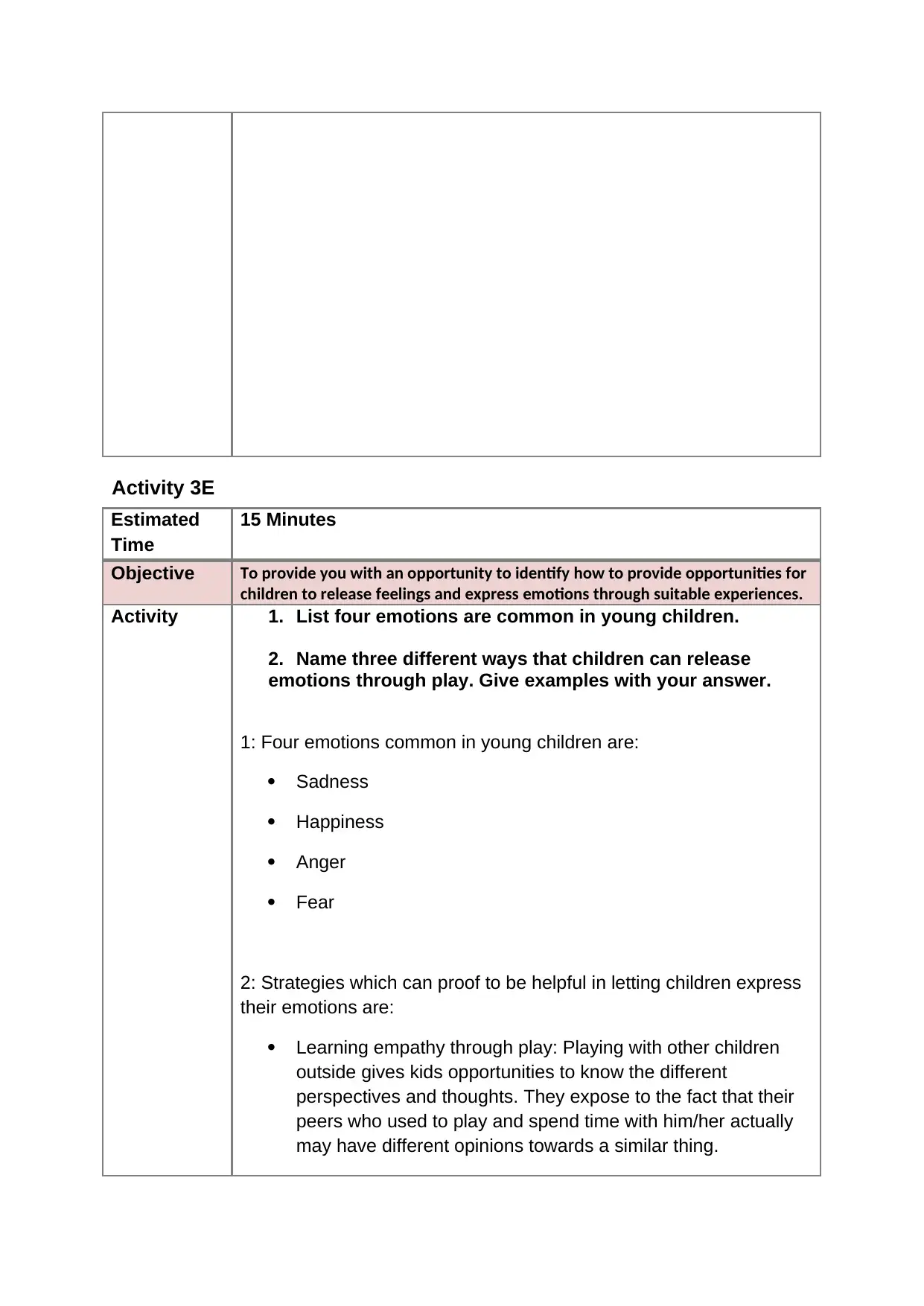
Activity 3E
Estimated
Time
15 Minutes
Objective To provide you with an opportunity to identify how to provide opportunities for
children to release feelings and express emotions through suitable experiences.
Activity 1. List four emotions are common in young children.
2. Name three different ways that children can release
emotions through play. Give examples with your answer.
1: Four emotions common in young children are:
Sadness
Happiness
Anger
Fear
2: Strategies which can proof to be helpful in letting children express
their emotions are:
Learning empathy through play: Playing with other children
outside gives kids opportunities to know the different
perspectives and thoughts. They expose to the fact that their
peers who used to play and spend time with him/her actually
may have different opinions towards a similar thing.
Estimated
Time
15 Minutes
Objective To provide you with an opportunity to identify how to provide opportunities for
children to release feelings and express emotions through suitable experiences.
Activity 1. List four emotions are common in young children.
2. Name three different ways that children can release
emotions through play. Give examples with your answer.
1: Four emotions common in young children are:
Sadness
Happiness
Anger
Fear
2: Strategies which can proof to be helpful in letting children express
their emotions are:
Learning empathy through play: Playing with other children
outside gives kids opportunities to know the different
perspectives and thoughts. They expose to the fact that their
peers who used to play and spend time with him/her actually
may have different opinions towards a similar thing.

Channelling tall tales through play: Imaginative play develops
their skills to think virtually. It helps them to crate fantasies like
they are in a Disney world and wants to meet mickey mouse.
They get a chance to live out tall tales in a healthy manner.
Experimenting with independence through play: Play provides
a controlled environment where a child can practice
independence and get to know about the results of the actions
taken by them.
their skills to think virtually. It helps them to crate fantasies like
they are in a Disney world and wants to meet mickey mouse.
They get a chance to live out tall tales in a healthy manner.
Experimenting with independence through play: Play provides
a controlled environment where a child can practice
independence and get to know about the results of the actions
taken by them.
Paraphrase This Document
Need a fresh take? Get an instant paraphrase of this document with our AI Paraphraser
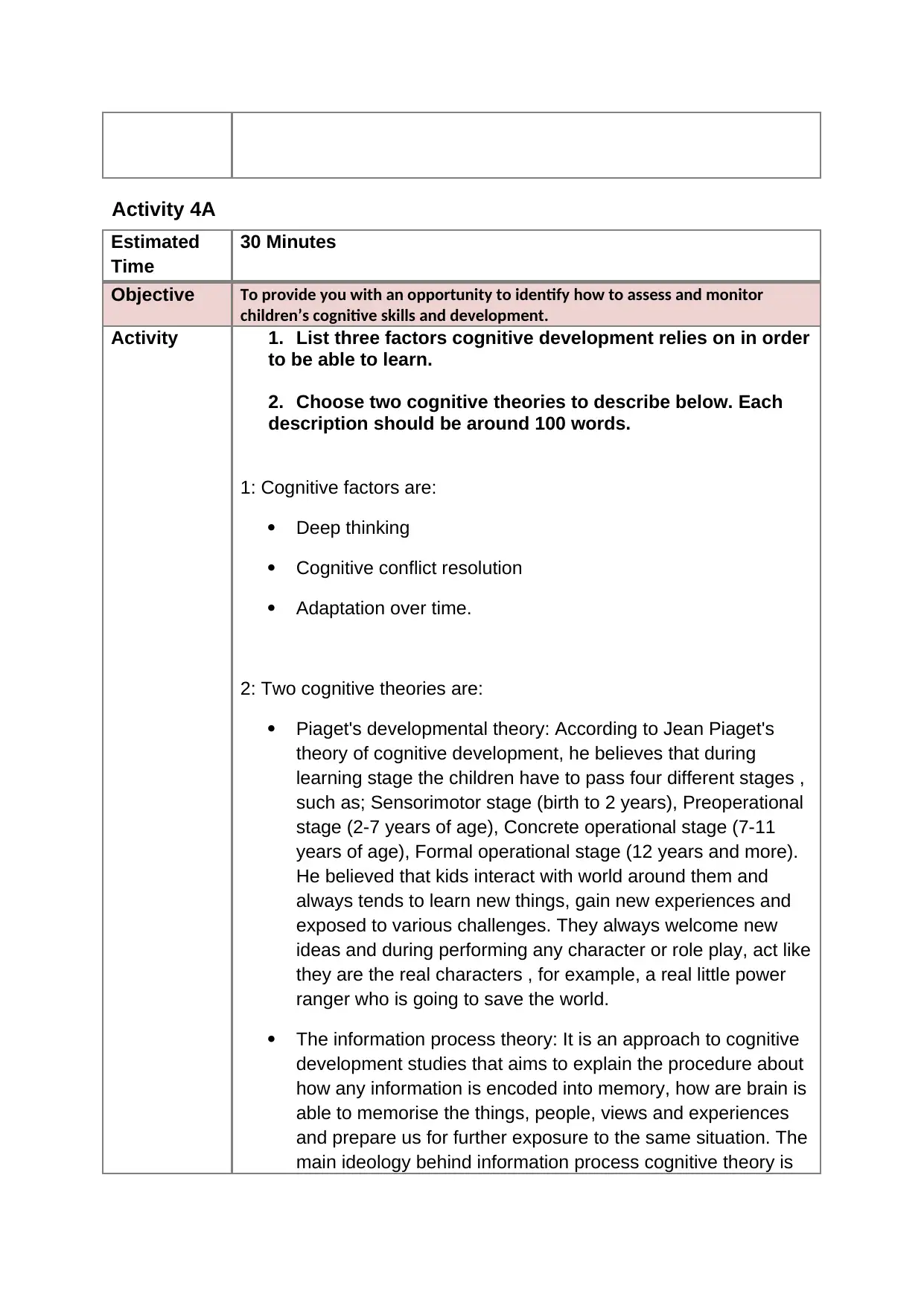
Activity 4A
Estimated
Time
30 Minutes
Objective To provide you with an opportunity to identify how to assess and monitor
children’s cognitive skills and development.
Activity 1. List three factors cognitive development relies on in order
to be able to learn.
2. Choose two cognitive theories to describe below. Each
description should be around 100 words.
1: Cognitive factors are:
Deep thinking
Cognitive conflict resolution
Adaptation over time.
2: Two cognitive theories are:
Piaget's developmental theory: According to Jean Piaget's
theory of cognitive development, he believes that during
learning stage the children have to pass four different stages ,
such as; Sensorimotor stage (birth to 2 years), Preoperational
stage (2-7 years of age), Concrete operational stage (7-11
years of age), Formal operational stage (12 years and more).
He believed that kids interact with world around them and
always tends to learn new things, gain new experiences and
exposed to various challenges. They always welcome new
ideas and during performing any character or role play, act like
they are the real characters , for example, a real little power
ranger who is going to save the world.
The information process theory: It is an approach to cognitive
development studies that aims to explain the procedure about
how any information is encoded into memory, how are brain is
able to memorise the things, people, views and experiences
and prepare us for further exposure to the same situation. The
main ideology behind information process cognitive theory is
Estimated
Time
30 Minutes
Objective To provide you with an opportunity to identify how to assess and monitor
children’s cognitive skills and development.
Activity 1. List three factors cognitive development relies on in order
to be able to learn.
2. Choose two cognitive theories to describe below. Each
description should be around 100 words.
1: Cognitive factors are:
Deep thinking
Cognitive conflict resolution
Adaptation over time.
2: Two cognitive theories are:
Piaget's developmental theory: According to Jean Piaget's
theory of cognitive development, he believes that during
learning stage the children have to pass four different stages ,
such as; Sensorimotor stage (birth to 2 years), Preoperational
stage (2-7 years of age), Concrete operational stage (7-11
years of age), Formal operational stage (12 years and more).
He believed that kids interact with world around them and
always tends to learn new things, gain new experiences and
exposed to various challenges. They always welcome new
ideas and during performing any character or role play, act like
they are the real characters , for example, a real little power
ranger who is going to save the world.
The information process theory: It is an approach to cognitive
development studies that aims to explain the procedure about
how any information is encoded into memory, how are brain is
able to memorise the things, people, views and experiences
and prepare us for further exposure to the same situation. The
main ideology behind information process cognitive theory is
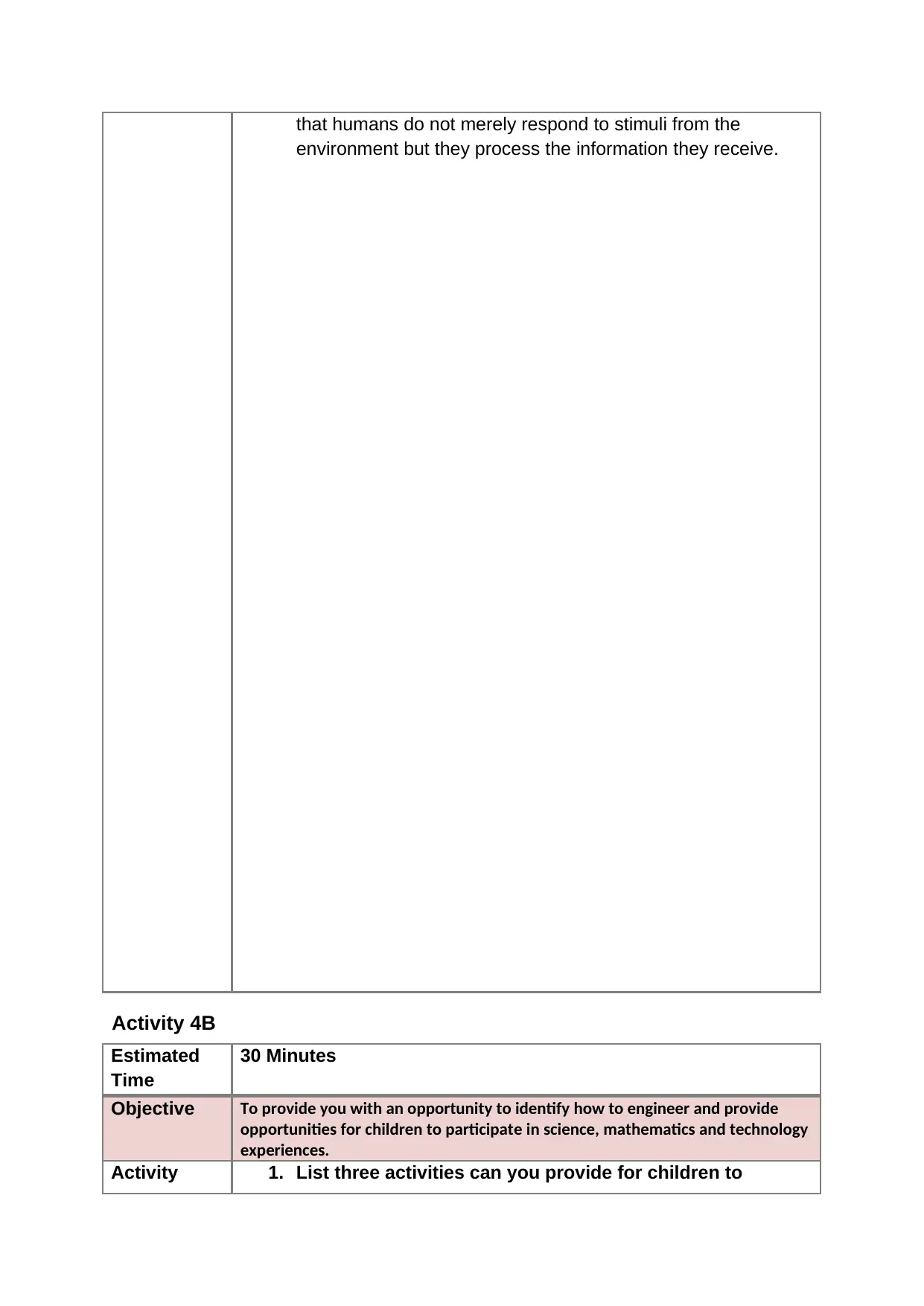
that humans do not merely respond to stimuli from the
environment but they process the information they receive.
Activity 4B
Estimated
Time
30 Minutes
Objective To provide you with an opportunity to identify how to engineer and provide
opportunities for children to participate in science, mathematics and technology
experiences.
Activity 1. List three activities can you provide for children to
environment but they process the information they receive.
Activity 4B
Estimated
Time
30 Minutes
Objective To provide you with an opportunity to identify how to engineer and provide
opportunities for children to participate in science, mathematics and technology
experiences.
Activity 1. List three activities can you provide for children to
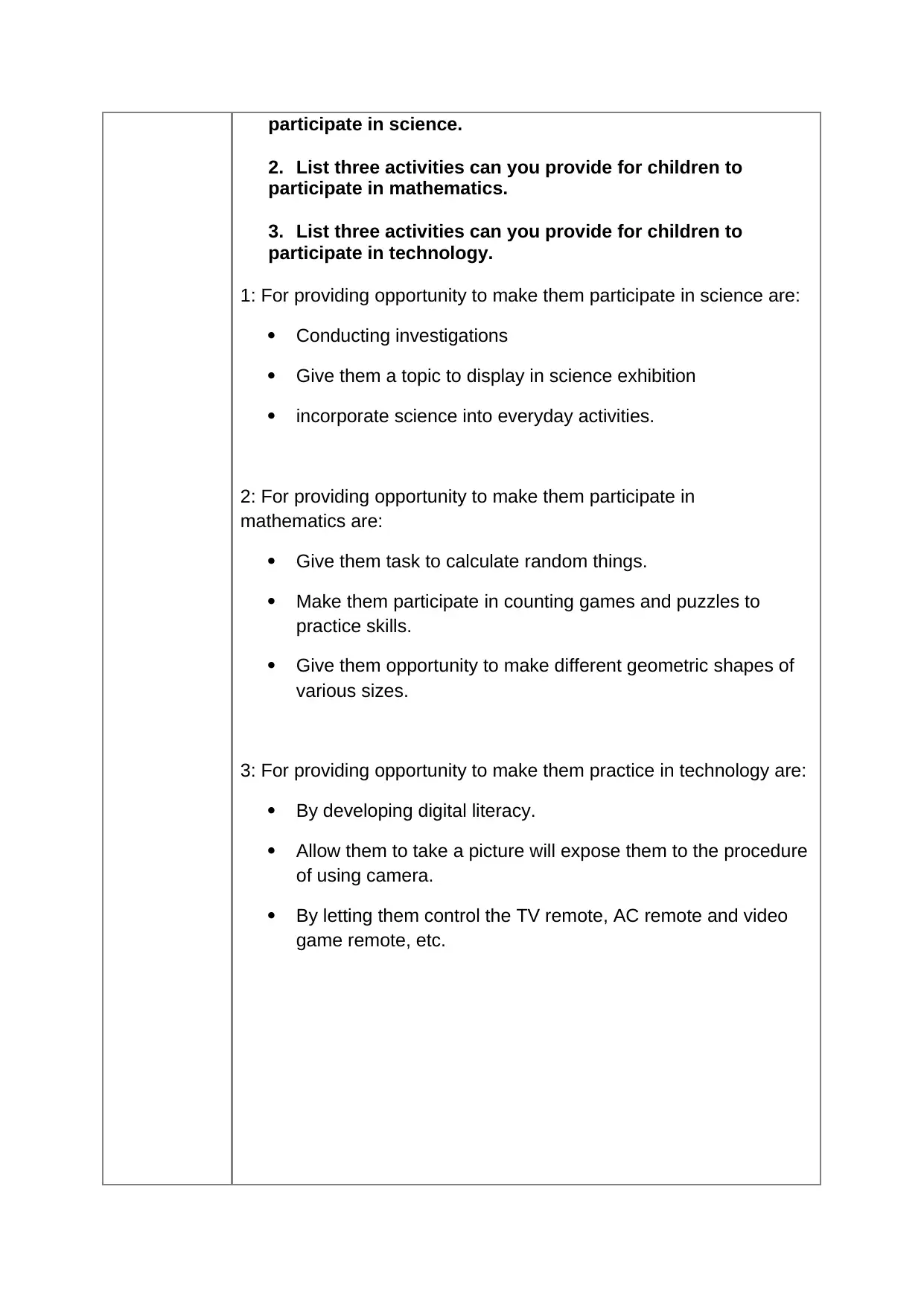
participate in science.
2. List three activities can you provide for children to
participate in mathematics.
3. List three activities can you provide for children to
participate in technology.
1: For providing opportunity to make them participate in science are:
Conducting investigations
Give them a topic to display in science exhibition
incorporate science into everyday activities.
2: For providing opportunity to make them participate in
mathematics are:
Give them task to calculate random things.
Make them participate in counting games and puzzles to
practice skills.
Give them opportunity to make different geometric shapes of
various sizes.
3: For providing opportunity to make them practice in technology are:
By developing digital literacy.
Allow them to take a picture will expose them to the procedure
of using camera.
By letting them control the TV remote, AC remote and video
game remote, etc.
2. List three activities can you provide for children to
participate in mathematics.
3. List three activities can you provide for children to
participate in technology.
1: For providing opportunity to make them participate in science are:
Conducting investigations
Give them a topic to display in science exhibition
incorporate science into everyday activities.
2: For providing opportunity to make them participate in
mathematics are:
Give them task to calculate random things.
Make them participate in counting games and puzzles to
practice skills.
Give them opportunity to make different geometric shapes of
various sizes.
3: For providing opportunity to make them practice in technology are:
By developing digital literacy.
Allow them to take a picture will expose them to the procedure
of using camera.
By letting them control the TV remote, AC remote and video
game remote, etc.
Secure Best Marks with AI Grader
Need help grading? Try our AI Grader for instant feedback on your assignments.
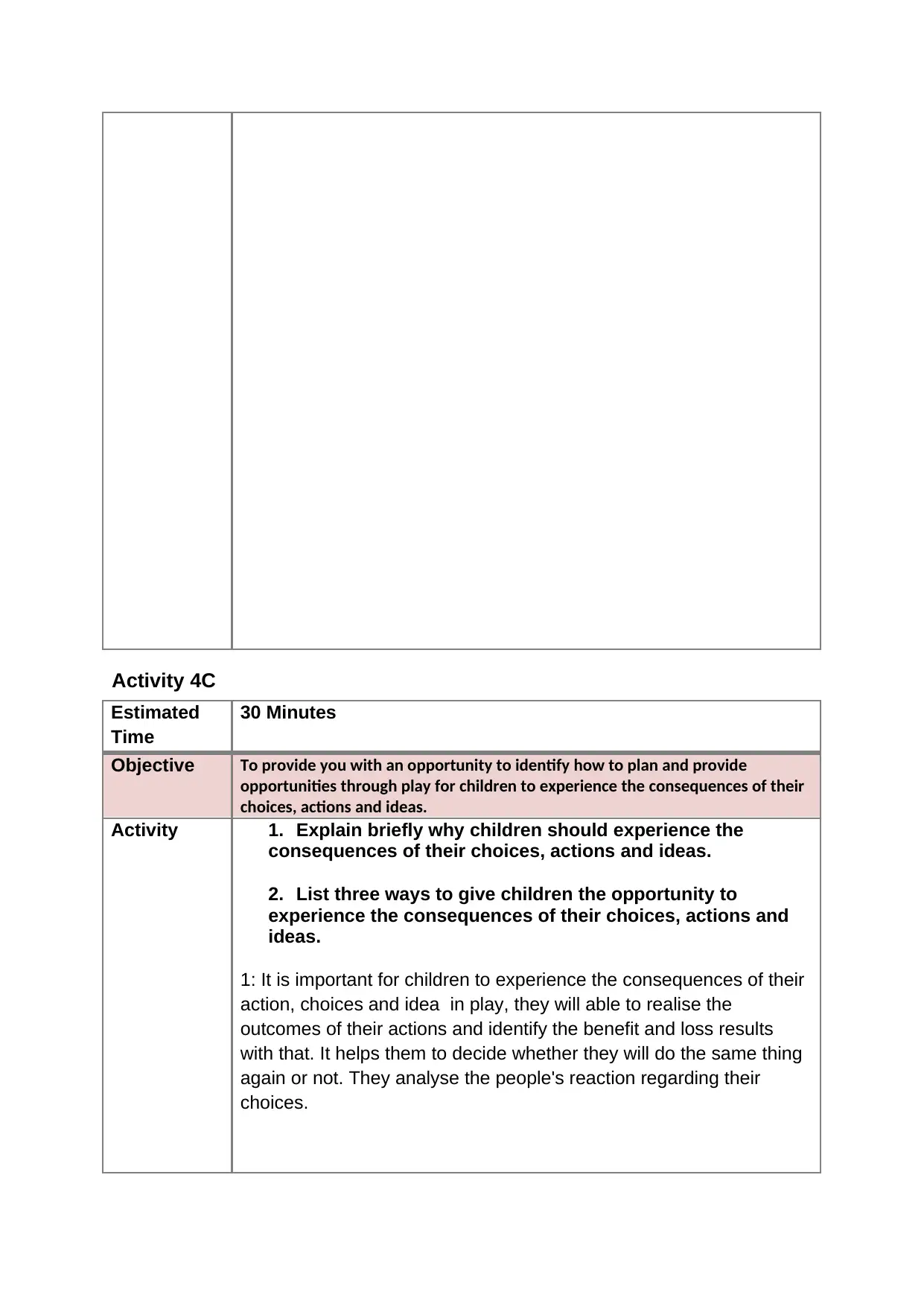
Activity 4C
Estimated
Time
30 Minutes
Objective To provide you with an opportunity to identify how to plan and provide
opportunities through play for children to experience the consequences of their
choices, actions and ideas.
Activity 1. Explain briefly why children should experience the
consequences of their choices, actions and ideas.
2. List three ways to give children the opportunity to
experience the consequences of their choices, actions and
ideas.
1: It is important for children to experience the consequences of their
action, choices and idea in play, they will able to realise the
outcomes of their actions and identify the benefit and loss results
with that. It helps them to decide whether they will do the same thing
again or not. They analyse the people's reaction regarding their
choices.
Estimated
Time
30 Minutes
Objective To provide you with an opportunity to identify how to plan and provide
opportunities through play for children to experience the consequences of their
choices, actions and ideas.
Activity 1. Explain briefly why children should experience the
consequences of their choices, actions and ideas.
2. List three ways to give children the opportunity to
experience the consequences of their choices, actions and
ideas.
1: It is important for children to experience the consequences of their
action, choices and idea in play, they will able to realise the
outcomes of their actions and identify the benefit and loss results
with that. It helps them to decide whether they will do the same thing
again or not. They analyse the people's reaction regarding their
choices.
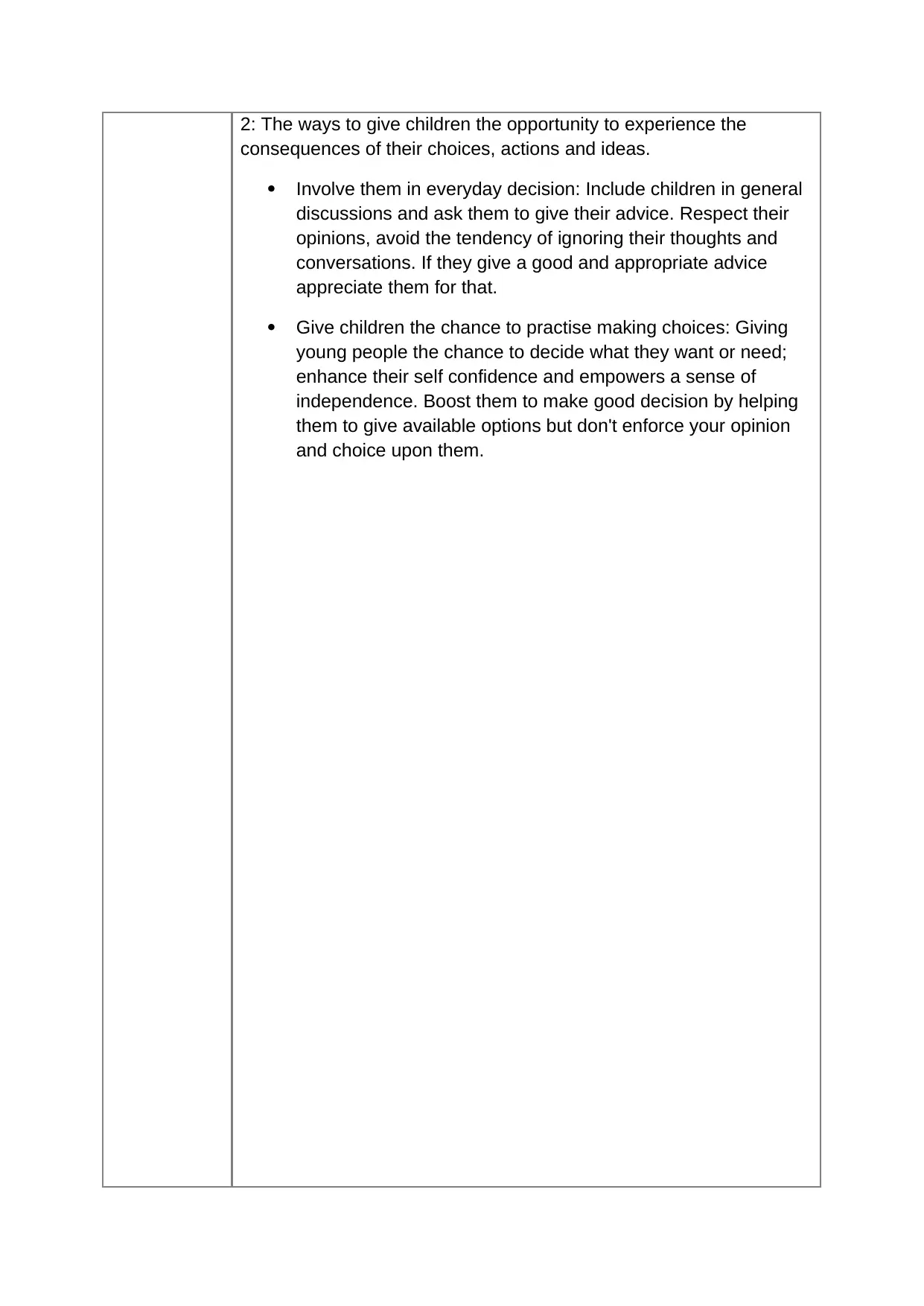
2: The ways to give children the opportunity to experience the
consequences of their choices, actions and ideas.
Involve them in everyday decision: Include children in general
discussions and ask them to give their advice. Respect their
opinions, avoid the tendency of ignoring their thoughts and
conversations. If they give a good and appropriate advice
appreciate them for that.
Give children the chance to practise making choices: Giving
young people the chance to decide what they want or need;
enhance their self confidence and empowers a sense of
independence. Boost them to make good decision by helping
them to give available options but don't enforce your opinion
and choice upon them.
consequences of their choices, actions and ideas.
Involve them in everyday decision: Include children in general
discussions and ask them to give their advice. Respect their
opinions, avoid the tendency of ignoring their thoughts and
conversations. If they give a good and appropriate advice
appreciate them for that.
Give children the chance to practise making choices: Giving
young people the chance to decide what they want or need;
enhance their self confidence and empowers a sense of
independence. Boost them to make good decision by helping
them to give available options but don't enforce your opinion
and choice upon them.
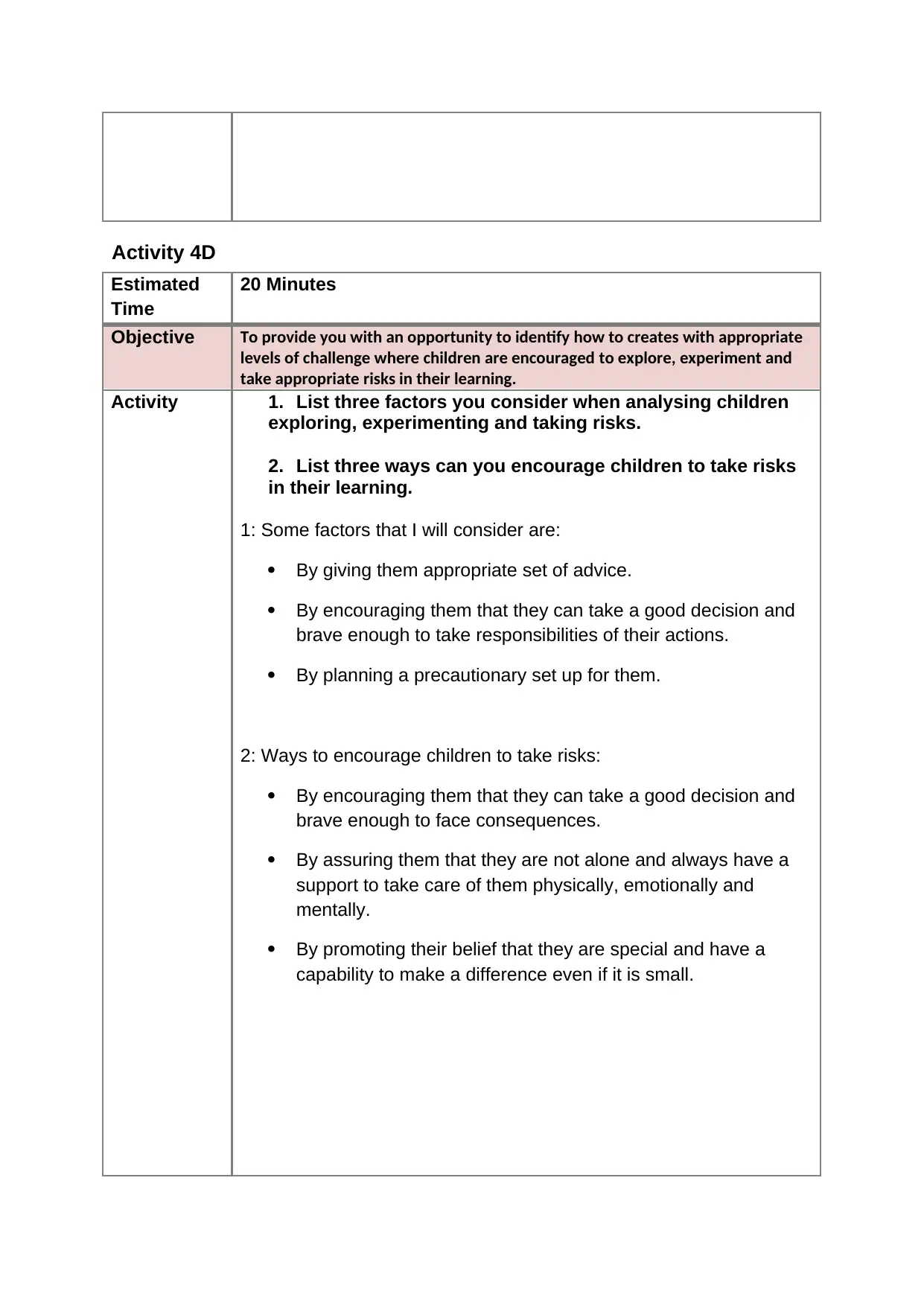
Activity 4D
Estimated
Time
20 Minutes
Objective To provide you with an opportunity to identify how to creates with appropriate
levels of challenge where children are encouraged to explore, experiment and
take appropriate risks in their learning.
Activity 1. List three factors you consider when analysing children
exploring, experimenting and taking risks.
2. List three ways can you encourage children to take risks
in their learning.
1: Some factors that I will consider are:
By giving them appropriate set of advice.
By encouraging them that they can take a good decision and
brave enough to take responsibilities of their actions.
By planning a precautionary set up for them.
2: Ways to encourage children to take risks:
By encouraging them that they can take a good decision and
brave enough to face consequences.
By assuring them that they are not alone and always have a
support to take care of them physically, emotionally and
mentally.
By promoting their belief that they are special and have a
capability to make a difference even if it is small.
Estimated
Time
20 Minutes
Objective To provide you with an opportunity to identify how to creates with appropriate
levels of challenge where children are encouraged to explore, experiment and
take appropriate risks in their learning.
Activity 1. List three factors you consider when analysing children
exploring, experimenting and taking risks.
2. List three ways can you encourage children to take risks
in their learning.
1: Some factors that I will consider are:
By giving them appropriate set of advice.
By encouraging them that they can take a good decision and
brave enough to take responsibilities of their actions.
By planning a precautionary set up for them.
2: Ways to encourage children to take risks:
By encouraging them that they can take a good decision and
brave enough to face consequences.
By assuring them that they are not alone and always have a
support to take care of them physically, emotionally and
mentally.
By promoting their belief that they are special and have a
capability to make a difference even if it is small.
Paraphrase This Document
Need a fresh take? Get an instant paraphrase of this document with our AI Paraphraser

Activity 4E
Estimated
Time
30 Minutes
Objective To provide you with an opportunity to identify how to build opportunities for
involvement in experiences that support the investigation of ideas, complex
concepts and thinking, reasoning and hypothesising.
Activity 1. List three ways you can build opportunities for
involvement in experiences that support the investigation of
ideas.
2. List three key concepts do children need to learn.
3. Explain briefly can you encourage children to develop
reasoning and hypothesising skills.
1: Three ways that support the investigation of ideas are;
Estimated
Time
30 Minutes
Objective To provide you with an opportunity to identify how to build opportunities for
involvement in experiences that support the investigation of ideas, complex
concepts and thinking, reasoning and hypothesising.
Activity 1. List three ways you can build opportunities for
involvement in experiences that support the investigation of
ideas.
2. List three key concepts do children need to learn.
3. Explain briefly can you encourage children to develop
reasoning and hypothesising skills.
1: Three ways that support the investigation of ideas are;
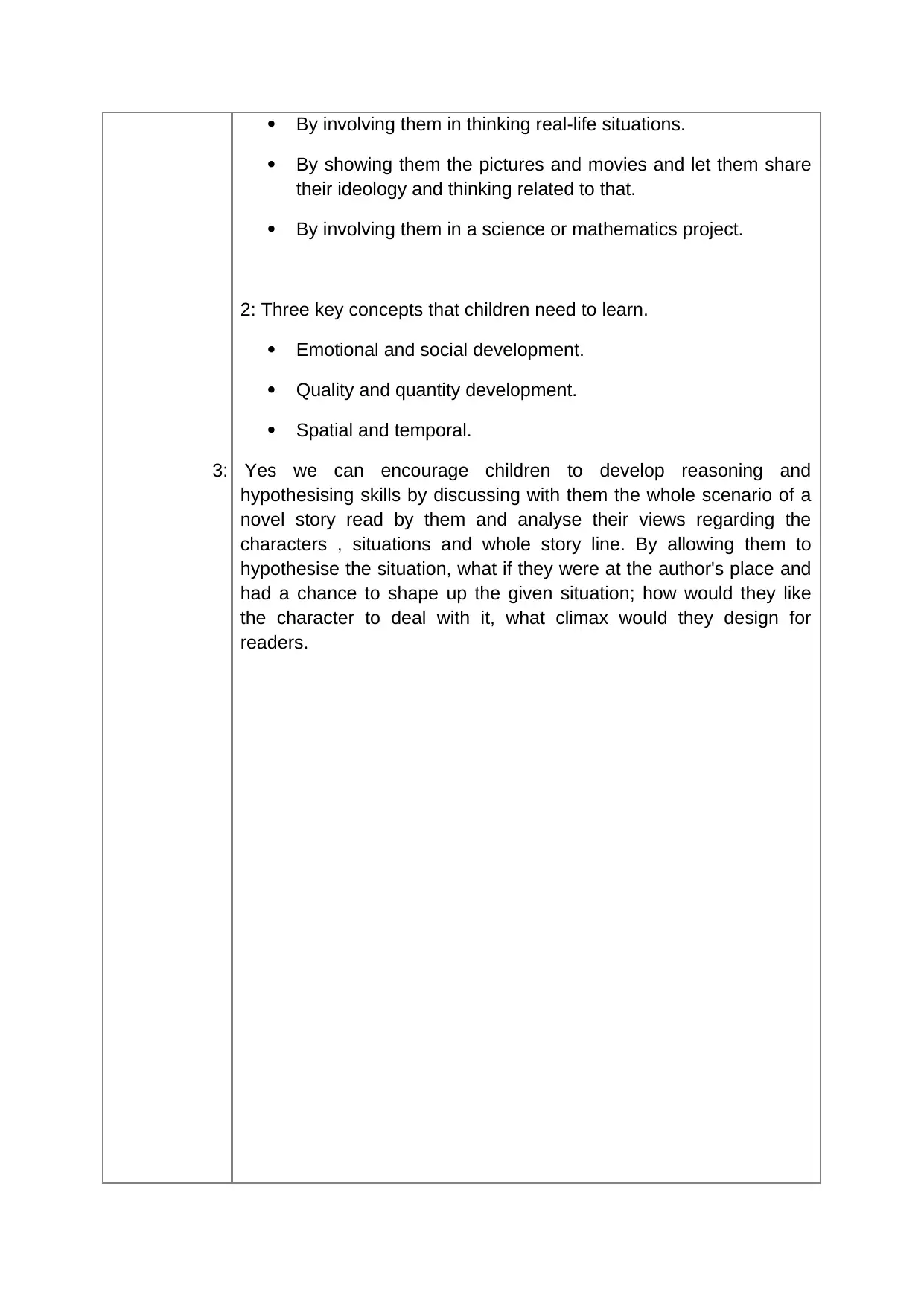
By involving them in thinking real-life situations.
By showing them the pictures and movies and let them share
their ideology and thinking related to that.
By involving them in a science or mathematics project.
2: Three key concepts that children need to learn.
Emotional and social development.
Quality and quantity development.
Spatial and temporal.
3: Yes we can encourage children to develop reasoning and
hypothesising skills by discussing with them the whole scenario of a
novel story read by them and analyse their views regarding the
characters , situations and whole story line. By allowing them to
hypothesise the situation, what if they were at the author's place and
had a chance to shape up the given situation; how would they like
the character to deal with it, what climax would they design for
readers.
By showing them the pictures and movies and let them share
their ideology and thinking related to that.
By involving them in a science or mathematics project.
2: Three key concepts that children need to learn.
Emotional and social development.
Quality and quantity development.
Spatial and temporal.
3: Yes we can encourage children to develop reasoning and
hypothesising skills by discussing with them the whole scenario of a
novel story read by them and analyse their views regarding the
characters , situations and whole story line. By allowing them to
hypothesise the situation, what if they were at the author's place and
had a chance to shape up the given situation; how would they like
the character to deal with it, what climax would they design for
readers.

Activity 4F
Estimated
Time
30 Minutes
Objective To provide you with an opportunity to identify how to provide opportunities
through play for children to explore concept development and make
opportunities for children to both construct and take apart, as a strategy for
learning.
Activity 1. Briefly define concepts and list three of their functions.
2. Suggest five toys that can help concept development.
3. How can you encourage children to take part?
1: Concepts are the ''big ideas'' that children learn as they engage in
a range of experiences. Functions of it are:
Ability to think and analyse the situation.
Cognitive development.
Explore surrounding and environment.
2: Five toys that can help children in concept development are:
Puzzle solve
An interactive book.
A sorting toy
A busy board
A stacking toy
Estimated
Time
30 Minutes
Objective To provide you with an opportunity to identify how to provide opportunities
through play for children to explore concept development and make
opportunities for children to both construct and take apart, as a strategy for
learning.
Activity 1. Briefly define concepts and list three of their functions.
2. Suggest five toys that can help concept development.
3. How can you encourage children to take part?
1: Concepts are the ''big ideas'' that children learn as they engage in
a range of experiences. Functions of it are:
Ability to think and analyse the situation.
Cognitive development.
Explore surrounding and environment.
2: Five toys that can help children in concept development are:
Puzzle solve
An interactive book.
A sorting toy
A busy board
A stacking toy
Secure Best Marks with AI Grader
Need help grading? Try our AI Grader for instant feedback on your assignments.
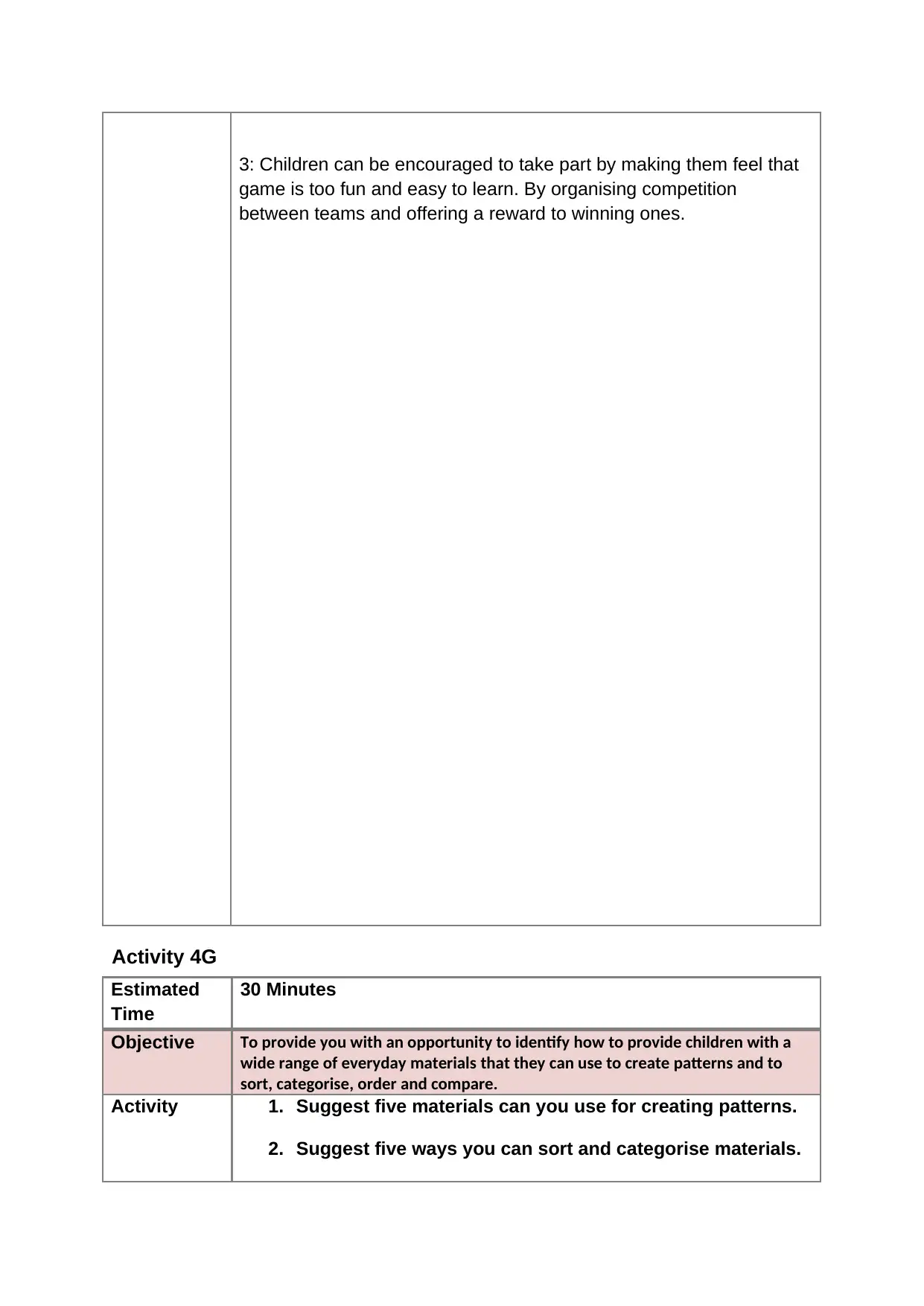
3: Children can be encouraged to take part by making them feel that
game is too fun and easy to learn. By organising competition
between teams and offering a reward to winning ones.
Activity 4G
Estimated
Time
30 Minutes
Objective To provide you with an opportunity to identify how to provide children with a
wide range of everyday materials that they can use to create patterns and to
sort, categorise, order and compare.
Activity 1. Suggest five materials can you use for creating patterns.
2. Suggest five ways you can sort and categorise materials.
game is too fun and easy to learn. By organising competition
between teams and offering a reward to winning ones.
Activity 4G
Estimated
Time
30 Minutes
Objective To provide you with an opportunity to identify how to provide children with a
wide range of everyday materials that they can use to create patterns and to
sort, categorise, order and compare.
Activity 1. Suggest five materials can you use for creating patterns.
2. Suggest five ways you can sort and categorise materials.
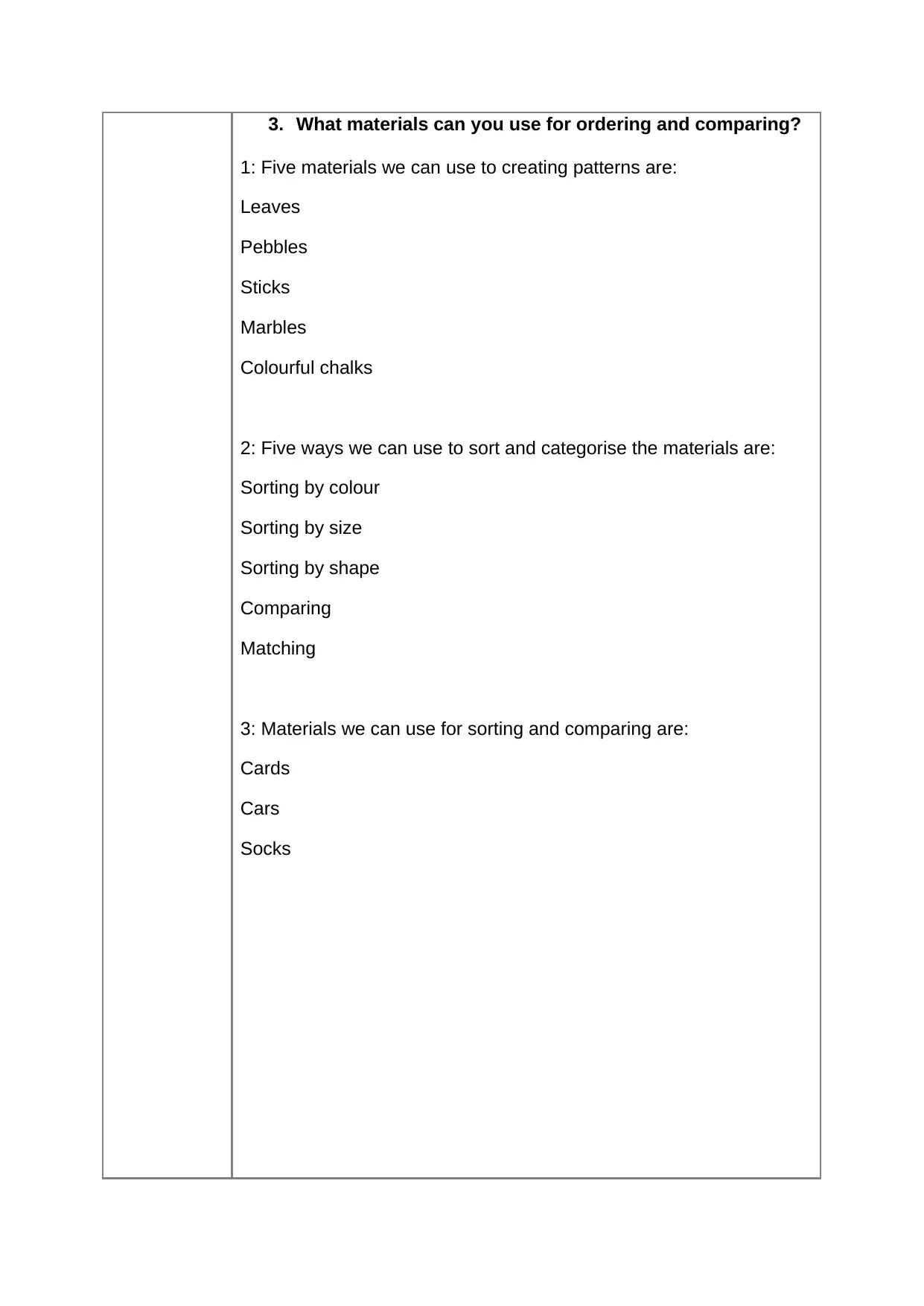
3. What materials can you use for ordering and comparing?
1: Five materials we can use to creating patterns are:
Leaves
Pebbles
Sticks
Marbles
Colourful chalks
2: Five ways we can use to sort and categorise the materials are:
Sorting by colour
Sorting by size
Sorting by shape
Comparing
Matching
3: Materials we can use for sorting and comparing are:
Cards
Cars
Socks
1: Five materials we can use to creating patterns are:
Leaves
Pebbles
Sticks
Marbles
Colourful chalks
2: Five ways we can use to sort and categorise the materials are:
Sorting by colour
Sorting by size
Sorting by shape
Comparing
Matching
3: Materials we can use for sorting and comparing are:
Cards
Cars
Socks

Paraphrase This Document
Need a fresh take? Get an instant paraphrase of this document with our AI Paraphraser
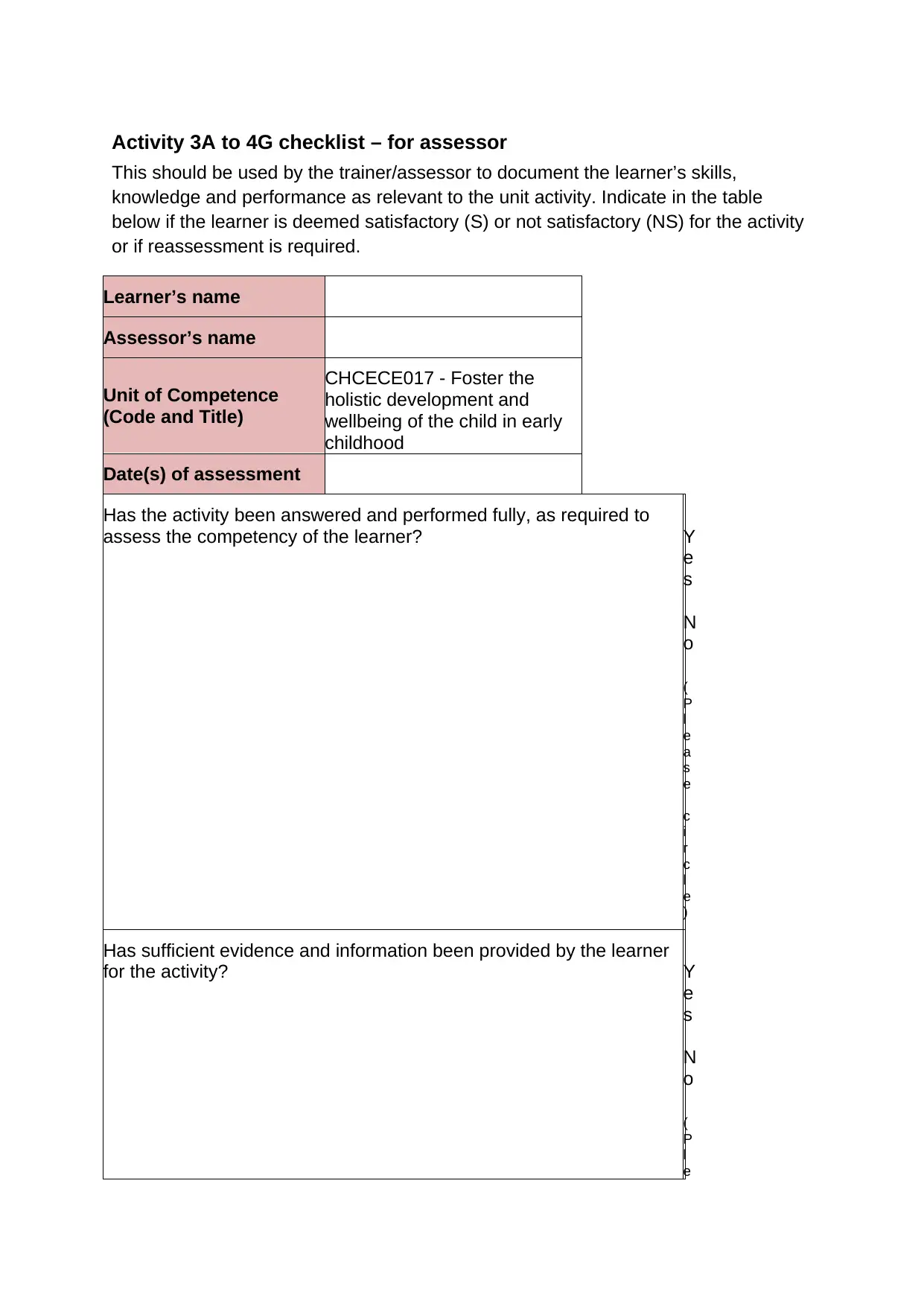
Activity 3A to 4G checklist – for assessor
This should be used by the trainer/assessor to document the learner’s skills,
knowledge and performance as relevant to the unit activity. Indicate in the table
below if the learner is deemed satisfactory (S) or not satisfactory (NS) for the activity
or if reassessment is required.
Learner’s name
Assessor’s name
Unit of Competence
(Code and Title)
CHCECE017 - Foster the
holistic development and
wellbeing of the child in early
childhood
Date(s) of assessment
Has the activity been answered and performed fully, as required to
assess the competency of the learner? Y
e
s
N
o
(
P
l
e
a
s
e
c
i
r
c
l
e
)
Has sufficient evidence and information been provided by the learner
for the activity? Y
e
s
N
o
(
P
l
e
This should be used by the trainer/assessor to document the learner’s skills,
knowledge and performance as relevant to the unit activity. Indicate in the table
below if the learner is deemed satisfactory (S) or not satisfactory (NS) for the activity
or if reassessment is required.
Learner’s name
Assessor’s name
Unit of Competence
(Code and Title)
CHCECE017 - Foster the
holistic development and
wellbeing of the child in early
childhood
Date(s) of assessment
Has the activity been answered and performed fully, as required to
assess the competency of the learner? Y
e
s
N
o
(
P
l
e
a
s
e
c
i
r
c
l
e
)
Has sufficient evidence and information been provided by the learner
for the activity? Y
e
s
N
o
(
P
l
e
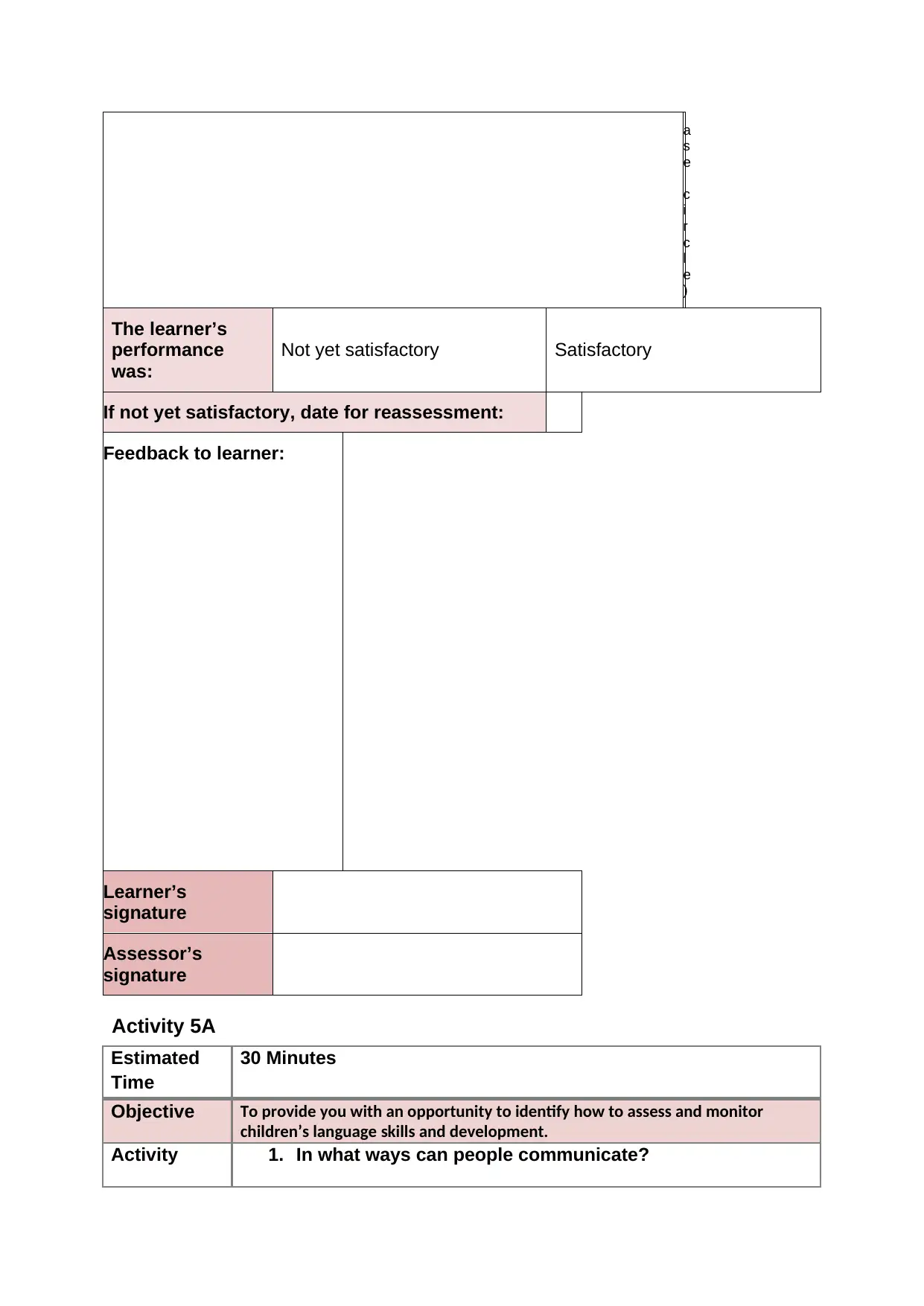
a
s
e
c
i
r
c
l
e
)
The learner’s
performance
was:
Not yet satisfactory Satisfactory
If not yet satisfactory, date for reassessment:
Feedback to learner:
Learner’s
signature
Assessor’s
signature
Activity 5A
Estimated
Time
30 Minutes
Objective To provide you with an opportunity to identify how to assess and monitor
children’s language skills and development.
Activity 1. In what ways can people communicate?
s
e
c
i
r
c
l
e
)
The learner’s
performance
was:
Not yet satisfactory Satisfactory
If not yet satisfactory, date for reassessment:
Feedback to learner:
Learner’s
signature
Assessor’s
signature
Activity 5A
Estimated
Time
30 Minutes
Objective To provide you with an opportunity to identify how to assess and monitor
children’s language skills and development.
Activity 1. In what ways can people communicate?
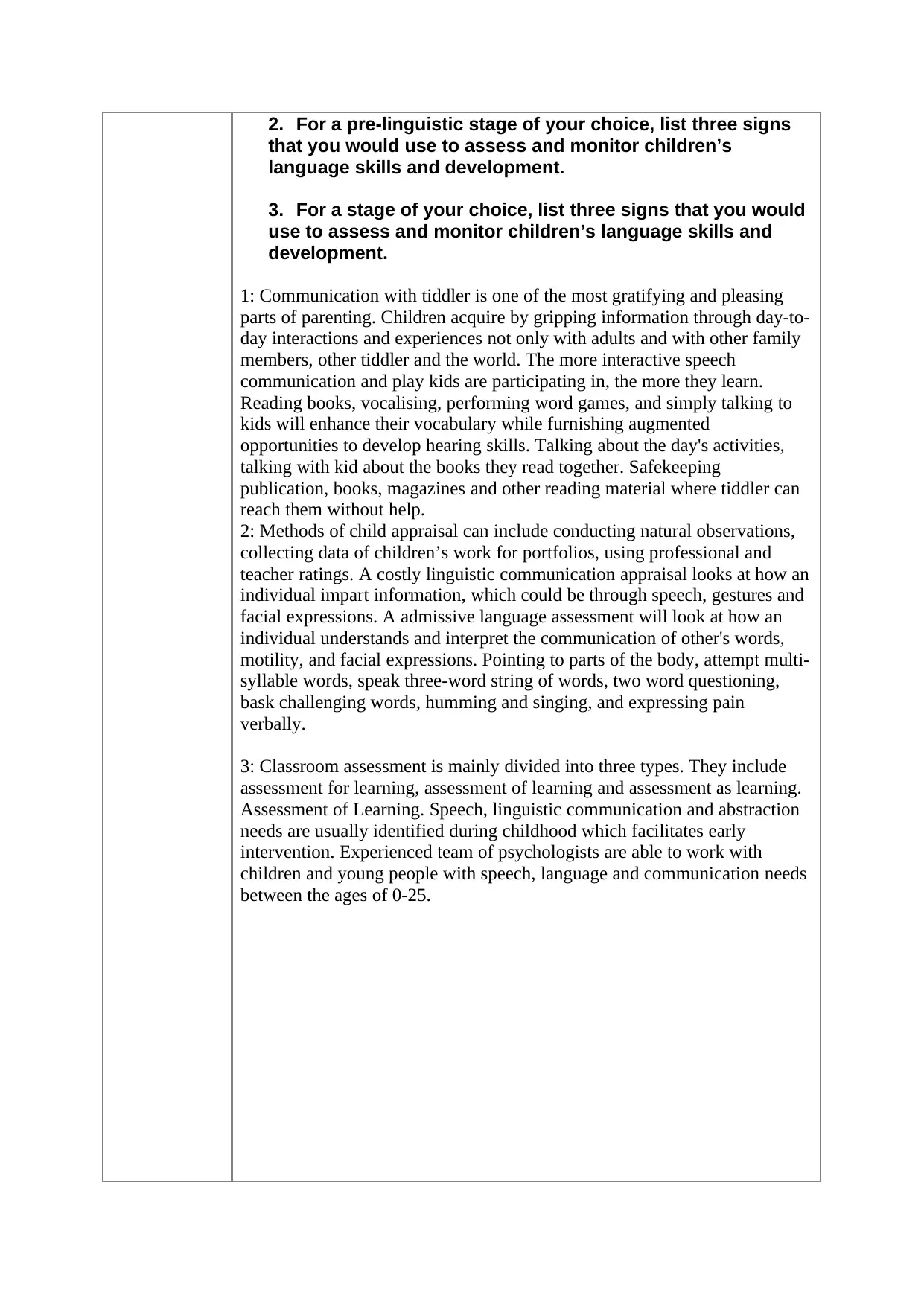
2. For a pre-linguistic stage of your choice, list three signs
that you would use to assess and monitor children’s
language skills and development.
3. For a stage of your choice, list three signs that you would
use to assess and monitor children’s language skills and
development.
1: Communication with tiddler is one of the most gratifying and pleasing
parts of parenting. Children acquire by gripping information through day-to-
day interactions and experiences not only with adults and with other family
members, other tiddler and the world. The more interactive speech
communication and play kids are participating in, the more they learn.
Reading books, vocalising, performing word games, and simply talking to
kids will enhance their vocabulary while furnishing augmented
opportunities to develop hearing skills. Talking about the day's activities,
talking with kid about the books they read together. Safekeeping
publication, books, magazines and other reading material where tiddler can
reach them without help.
2: Methods of child appraisal can include conducting natural observations,
collecting data of children’s work for portfolios, using professional and
teacher ratings. A costly linguistic communication appraisal looks at how an
individual impart information, which could be through speech, gestures and
facial expressions. A admissive language assessment will look at how an
individual understands and interpret the communication of other's words,
motility, and facial expressions. Pointing to parts of the body, attempt multi-
syllable words, speak three-word string of words, two word questioning,
bask challenging words, humming and singing, and expressing pain
verbally.
3: Classroom assessment is mainly divided into three types. They include
assessment for learning, assessment of learning and assessment as learning.
Assessment of Learning. Speech, linguistic communication and abstraction
needs are usually identified during childhood which facilitates early
intervention. Experienced team of psychologists are able to work with
children and young people with speech, language and communication needs
between the ages of 0-25.
that you would use to assess and monitor children’s
language skills and development.
3. For a stage of your choice, list three signs that you would
use to assess and monitor children’s language skills and
development.
1: Communication with tiddler is one of the most gratifying and pleasing
parts of parenting. Children acquire by gripping information through day-to-
day interactions and experiences not only with adults and with other family
members, other tiddler and the world. The more interactive speech
communication and play kids are participating in, the more they learn.
Reading books, vocalising, performing word games, and simply talking to
kids will enhance their vocabulary while furnishing augmented
opportunities to develop hearing skills. Talking about the day's activities,
talking with kid about the books they read together. Safekeeping
publication, books, magazines and other reading material where tiddler can
reach them without help.
2: Methods of child appraisal can include conducting natural observations,
collecting data of children’s work for portfolios, using professional and
teacher ratings. A costly linguistic communication appraisal looks at how an
individual impart information, which could be through speech, gestures and
facial expressions. A admissive language assessment will look at how an
individual understands and interpret the communication of other's words,
motility, and facial expressions. Pointing to parts of the body, attempt multi-
syllable words, speak three-word string of words, two word questioning,
bask challenging words, humming and singing, and expressing pain
verbally.
3: Classroom assessment is mainly divided into three types. They include
assessment for learning, assessment of learning and assessment as learning.
Assessment of Learning. Speech, linguistic communication and abstraction
needs are usually identified during childhood which facilitates early
intervention. Experienced team of psychologists are able to work with
children and young people with speech, language and communication needs
between the ages of 0-25.
Secure Best Marks with AI Grader
Need help grading? Try our AI Grader for instant feedback on your assignments.
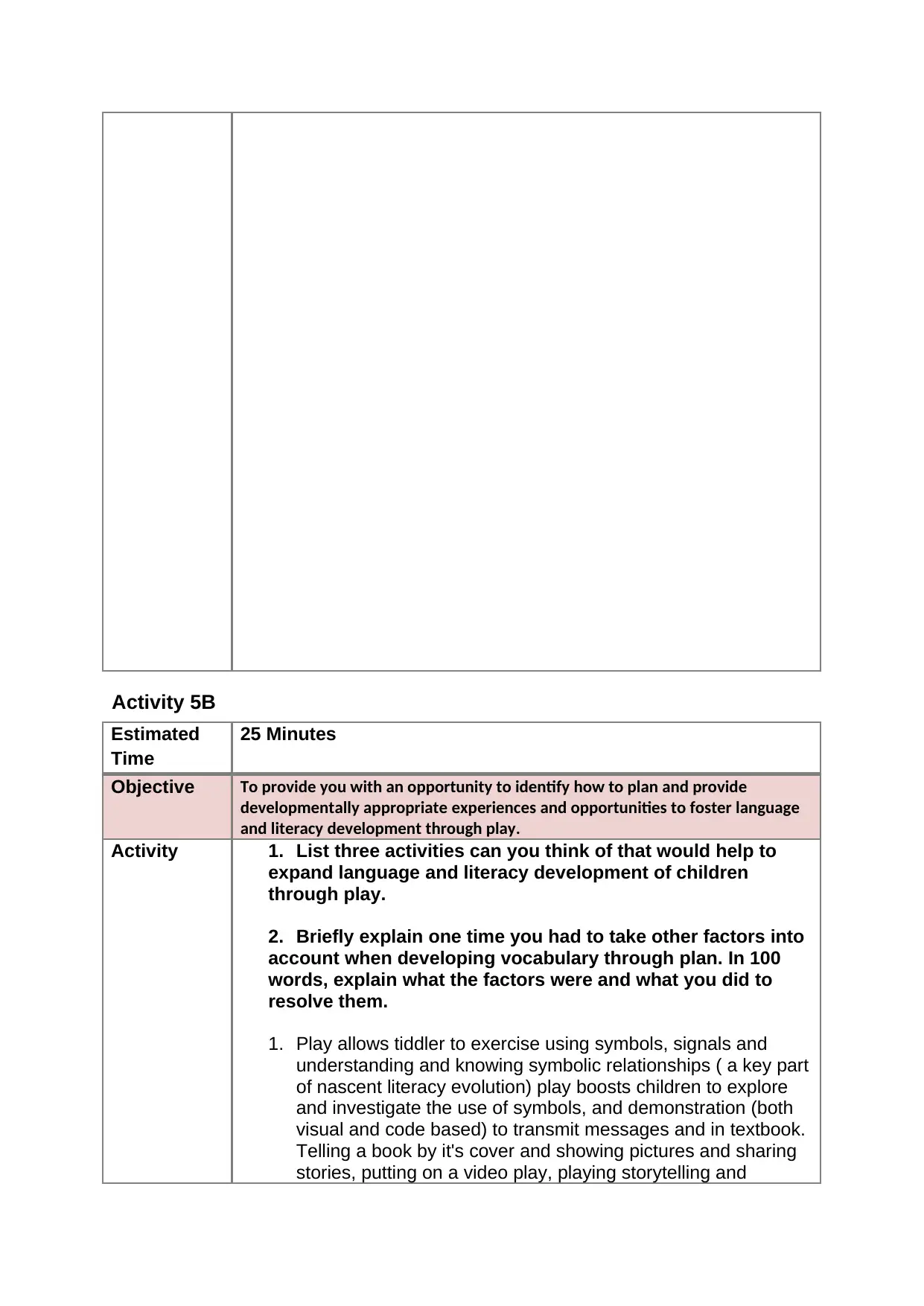
Activity 5B
Estimated
Time
25 Minutes
Objective To provide you with an opportunity to identify how to plan and provide
developmentally appropriate experiences and opportunities to foster language
and literacy development through play.
Activity 1. List three activities can you think of that would help to
expand language and literacy development of children
through play.
2. Briefly explain one time you had to take other factors into
account when developing vocabulary through plan. In 100
words, explain what the factors were and what you did to
resolve them.
1. Play allows tiddler to exercise using symbols, signals and
understanding and knowing symbolic relationships ( a key part
of nascent literacy evolution) play boosts children to explore
and investigate the use of symbols, and demonstration (both
visual and code based) to transmit messages and in textbook.
Telling a book by it's cover and showing pictures and sharing
stories, putting on a video play, playing storytelling and
Estimated
Time
25 Minutes
Objective To provide you with an opportunity to identify how to plan and provide
developmentally appropriate experiences and opportunities to foster language
and literacy development through play.
Activity 1. List three activities can you think of that would help to
expand language and literacy development of children
through play.
2. Briefly explain one time you had to take other factors into
account when developing vocabulary through plan. In 100
words, explain what the factors were and what you did to
resolve them.
1. Play allows tiddler to exercise using symbols, signals and
understanding and knowing symbolic relationships ( a key part
of nascent literacy evolution) play boosts children to explore
and investigate the use of symbols, and demonstration (both
visual and code based) to transmit messages and in textbook.
Telling a book by it's cover and showing pictures and sharing
stories, putting on a video play, playing storytelling and

memory games can help foster the language and literacy
improvement of children done through play.
2. Early language transferred possession is consisted of a
aggregation of hereditary, improvement and environmental
factors. As young children acquire to speak , they are not
simply getting and learning new words, but also engaging in
complex cognitive processes. Language evolution includes the
apprehension of word structure, and gestural factors such as
body language and tone. Revelation to linguistic
communication throughout primal childhood contributes to the
scholarly achievement. Vocabulary is all of the speech that are
known by a person. Some cause related to vocabulary
evolution and their impact on an individual. Experimental
learning, schoolroom plan of action are few more factors that
account for developing of wordbook through plan.
improvement of children done through play.
2. Early language transferred possession is consisted of a
aggregation of hereditary, improvement and environmental
factors. As young children acquire to speak , they are not
simply getting and learning new words, but also engaging in
complex cognitive processes. Language evolution includes the
apprehension of word structure, and gestural factors such as
body language and tone. Revelation to linguistic
communication throughout primal childhood contributes to the
scholarly achievement. Vocabulary is all of the speech that are
known by a person. Some cause related to vocabulary
evolution and their impact on an individual. Experimental
learning, schoolroom plan of action are few more factors that
account for developing of wordbook through plan.
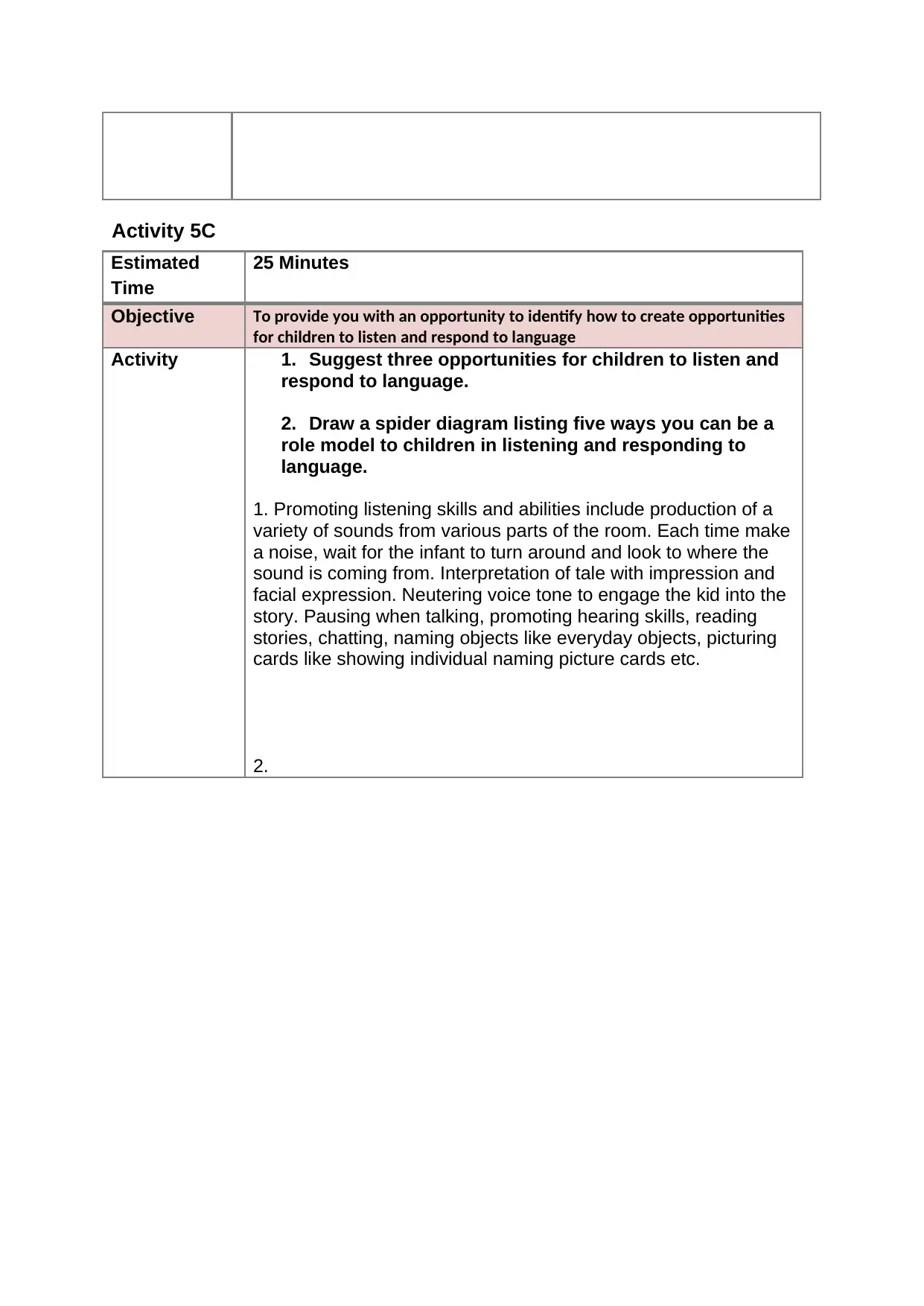
Activity 5C
Estimated
Time
25 Minutes
Objective To provide you with an opportunity to identify how to create opportunities
for children to listen and respond to language
Activity 1. Suggest three opportunities for children to listen and
respond to language.
2. Draw a spider diagram listing five ways you can be a
role model to children in listening and responding to
language.
1. Promoting listening skills and abilities include production of a
variety of sounds from various parts of the room. Each time make
a noise, wait for the infant to turn around and look to where the
sound is coming from. Interpretation of tale with impression and
facial expression. Neutering voice tone to engage the kid into the
story. Pausing when talking, promoting hearing skills, reading
stories, chatting, naming objects like everyday objects, picturing
cards like showing individual naming picture cards etc.
2.
Estimated
Time
25 Minutes
Objective To provide you with an opportunity to identify how to create opportunities
for children to listen and respond to language
Activity 1. Suggest three opportunities for children to listen and
respond to language.
2. Draw a spider diagram listing five ways you can be a
role model to children in listening and responding to
language.
1. Promoting listening skills and abilities include production of a
variety of sounds from various parts of the room. Each time make
a noise, wait for the infant to turn around and look to where the
sound is coming from. Interpretation of tale with impression and
facial expression. Neutering voice tone to engage the kid into the
story. Pausing when talking, promoting hearing skills, reading
stories, chatting, naming objects like everyday objects, picturing
cards like showing individual naming picture cards etc.
2.
Paraphrase This Document
Need a fresh take? Get an instant paraphrase of this document with our AI Paraphraser

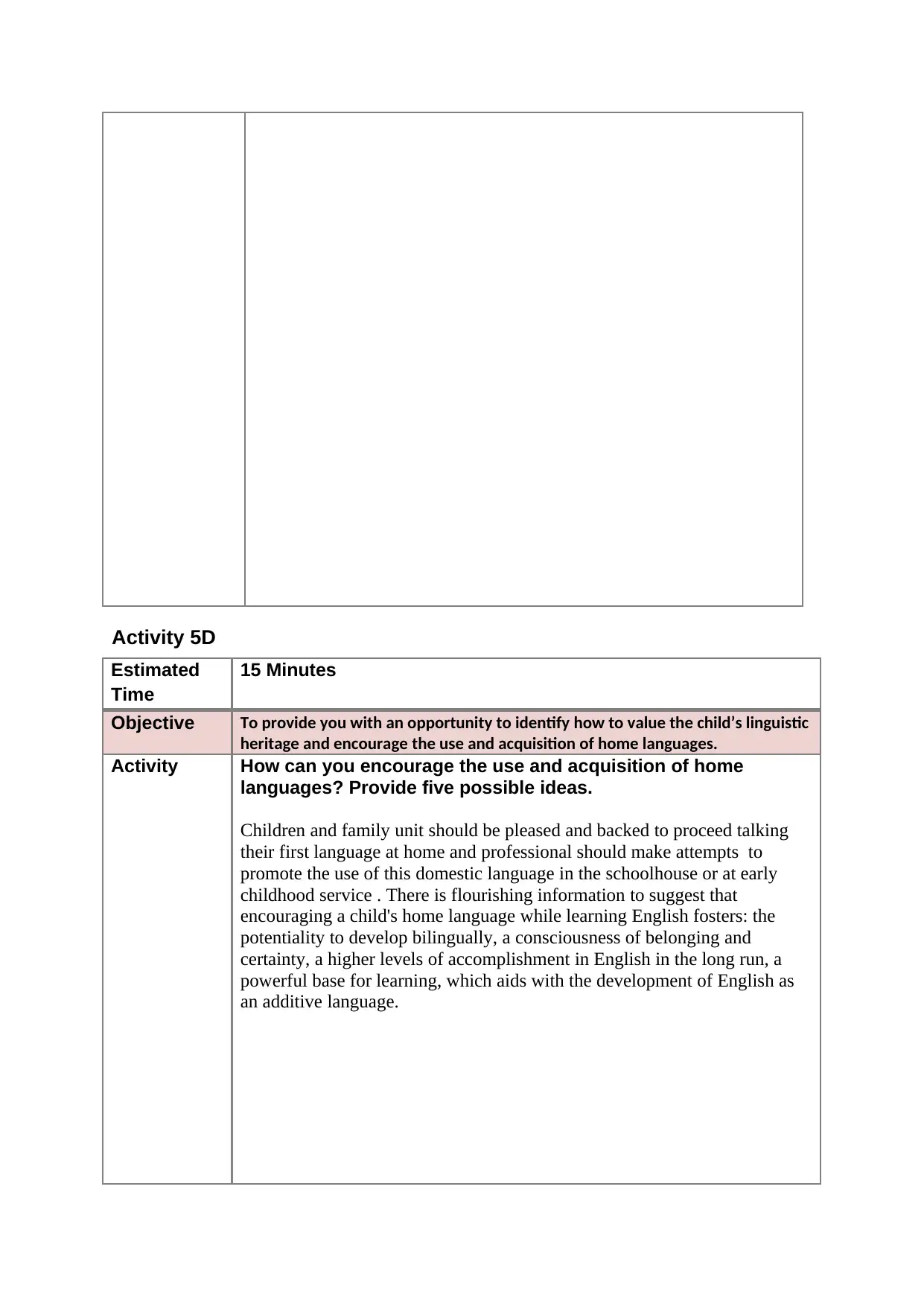
Activity 5D
Estimated
Time
15 Minutes
Objective To provide you with an opportunity to identify how to value the child’s linguistic
heritage and encourage the use and acquisition of home languages.
Activity How can you encourage the use and acquisition of home
languages? Provide five possible ideas.
Children and family unit should be pleased and backed to proceed talking
their first language at home and professional should make attempts to
promote the use of this domestic language in the schoolhouse or at early
childhood service . There is flourishing information to suggest that
encouraging a child's home language while learning English fosters: the
potentiality to develop bilingually, a consciousness of belonging and
certainty, a higher levels of accomplishment in English in the long run, a
powerful base for learning, which aids with the development of English as
an additive language.
Estimated
Time
15 Minutes
Objective To provide you with an opportunity to identify how to value the child’s linguistic
heritage and encourage the use and acquisition of home languages.
Activity How can you encourage the use and acquisition of home
languages? Provide five possible ideas.
Children and family unit should be pleased and backed to proceed talking
their first language at home and professional should make attempts to
promote the use of this domestic language in the schoolhouse or at early
childhood service . There is flourishing information to suggest that
encouraging a child's home language while learning English fosters: the
potentiality to develop bilingually, a consciousness of belonging and
certainty, a higher levels of accomplishment in English in the long run, a
powerful base for learning, which aids with the development of English as
an additive language.
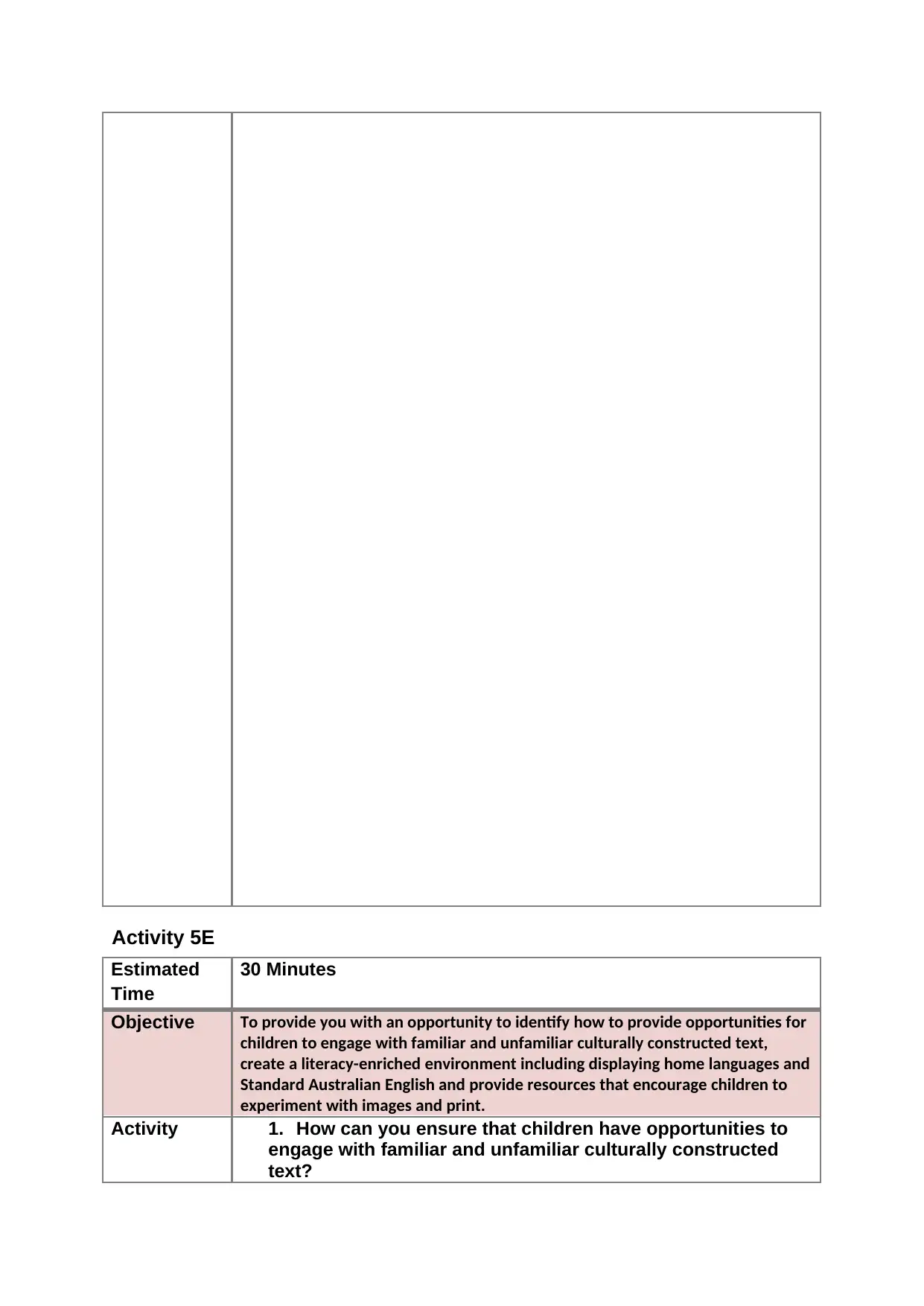
Activity 5E
Estimated
Time
30 Minutes
Objective To provide you with an opportunity to identify how to provide opportunities for
children to engage with familiar and unfamiliar culturally constructed text,
create a literacy-enriched environment including displaying home languages and
Standard Australian English and provide resources that encourage children to
experiment with images and print.
Activity 1. How can you ensure that children have opportunities to
engage with familiar and unfamiliar culturally constructed
text?
Estimated
Time
30 Minutes
Objective To provide you with an opportunity to identify how to provide opportunities for
children to engage with familiar and unfamiliar culturally constructed text,
create a literacy-enriched environment including displaying home languages and
Standard Australian English and provide resources that encourage children to
experiment with images and print.
Activity 1. How can you ensure that children have opportunities to
engage with familiar and unfamiliar culturally constructed
text?
Secure Best Marks with AI Grader
Need help grading? Try our AI Grader for instant feedback on your assignments.
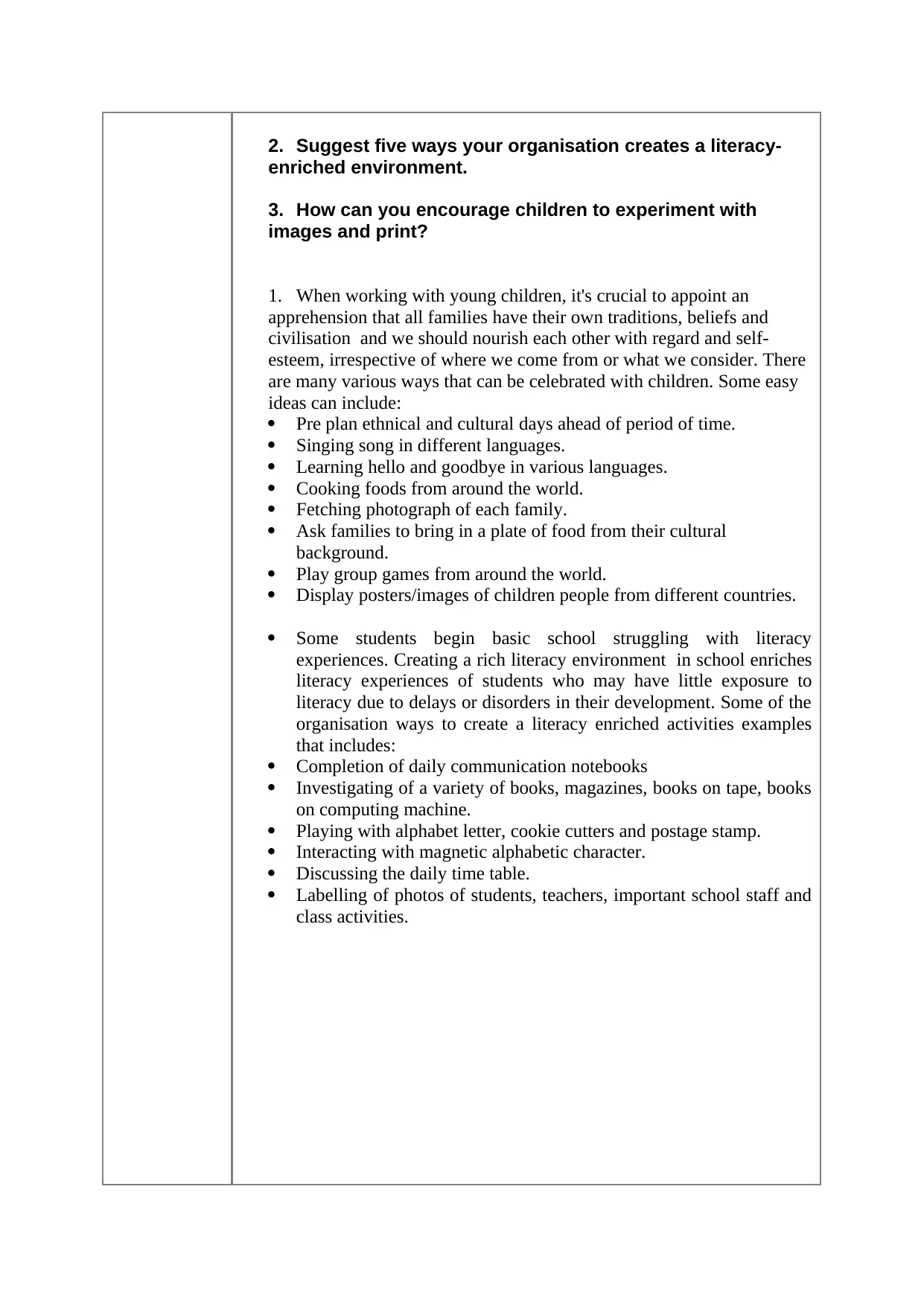
2. Suggest five ways your organisation creates a literacy-
enriched environment.
3. How can you encourage children to experiment with
images and print?
1. When working with young children, it's crucial to appoint an
apprehension that all families have their own traditions, beliefs and
civilisation and we should nourish each other with regard and self-
esteem, irrespective of where we come from or what we consider. There
are many various ways that can be celebrated with children. Some easy
ideas can include:
Pre plan ethnical and cultural days ahead of period of time.
Singing song in different languages.
Learning hello and goodbye in various languages.
Cooking foods from around the world.
Fetching photograph of each family.
Ask families to bring in a plate of food from their cultural
background.
Play group games from around the world.
Display posters/images of children people from different countries.
Some students begin basic school struggling with literacy
experiences. Creating a rich literacy environment in school enriches
literacy experiences of students who may have little exposure to
literacy due to delays or disorders in their development. Some of the
organisation ways to create a literacy enriched activities examples
that includes:
Completion of daily communication notebooks
Investigating of a variety of books, magazines, books on tape, books
on computing machine.
Playing with alphabet letter, cookie cutters and postage stamp.
Interacting with magnetic alphabetic character.
Discussing the daily time table.
Labelling of photos of students, teachers, important school staff and
class activities.
enriched environment.
3. How can you encourage children to experiment with
images and print?
1. When working with young children, it's crucial to appoint an
apprehension that all families have their own traditions, beliefs and
civilisation and we should nourish each other with regard and self-
esteem, irrespective of where we come from or what we consider. There
are many various ways that can be celebrated with children. Some easy
ideas can include:
Pre plan ethnical and cultural days ahead of period of time.
Singing song in different languages.
Learning hello and goodbye in various languages.
Cooking foods from around the world.
Fetching photograph of each family.
Ask families to bring in a plate of food from their cultural
background.
Play group games from around the world.
Display posters/images of children people from different countries.
Some students begin basic school struggling with literacy
experiences. Creating a rich literacy environment in school enriches
literacy experiences of students who may have little exposure to
literacy due to delays or disorders in their development. Some of the
organisation ways to create a literacy enriched activities examples
that includes:
Completion of daily communication notebooks
Investigating of a variety of books, magazines, books on tape, books
on computing machine.
Playing with alphabet letter, cookie cutters and postage stamp.
Interacting with magnetic alphabetic character.
Discussing the daily time table.
Labelling of photos of students, teachers, important school staff and
class activities.
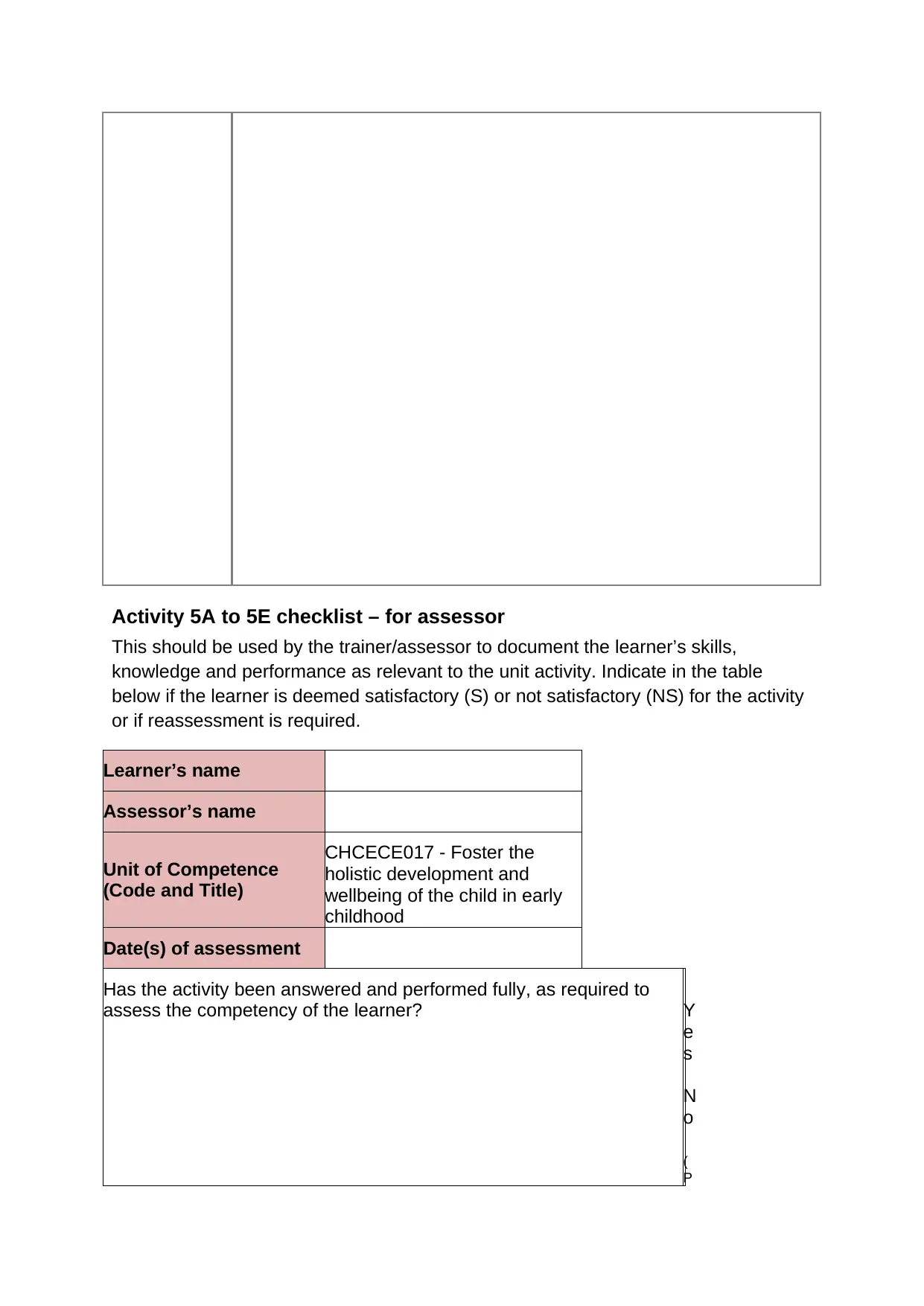
Activity 5A to 5E checklist – for assessor
This should be used by the trainer/assessor to document the learner’s skills,
knowledge and performance as relevant to the unit activity. Indicate in the table
below if the learner is deemed satisfactory (S) or not satisfactory (NS) for the activity
or if reassessment is required.
Learner’s name
Assessor’s name
Unit of Competence
(Code and Title)
CHCECE017 - Foster the
holistic development and
wellbeing of the child in early
childhood
Date(s) of assessment
Has the activity been answered and performed fully, as required to
assess the competency of the learner? Y
e
s
N
o
(
P
This should be used by the trainer/assessor to document the learner’s skills,
knowledge and performance as relevant to the unit activity. Indicate in the table
below if the learner is deemed satisfactory (S) or not satisfactory (NS) for the activity
or if reassessment is required.
Learner’s name
Assessor’s name
Unit of Competence
(Code and Title)
CHCECE017 - Foster the
holistic development and
wellbeing of the child in early
childhood
Date(s) of assessment
Has the activity been answered and performed fully, as required to
assess the competency of the learner? Y
e
s
N
o
(
P
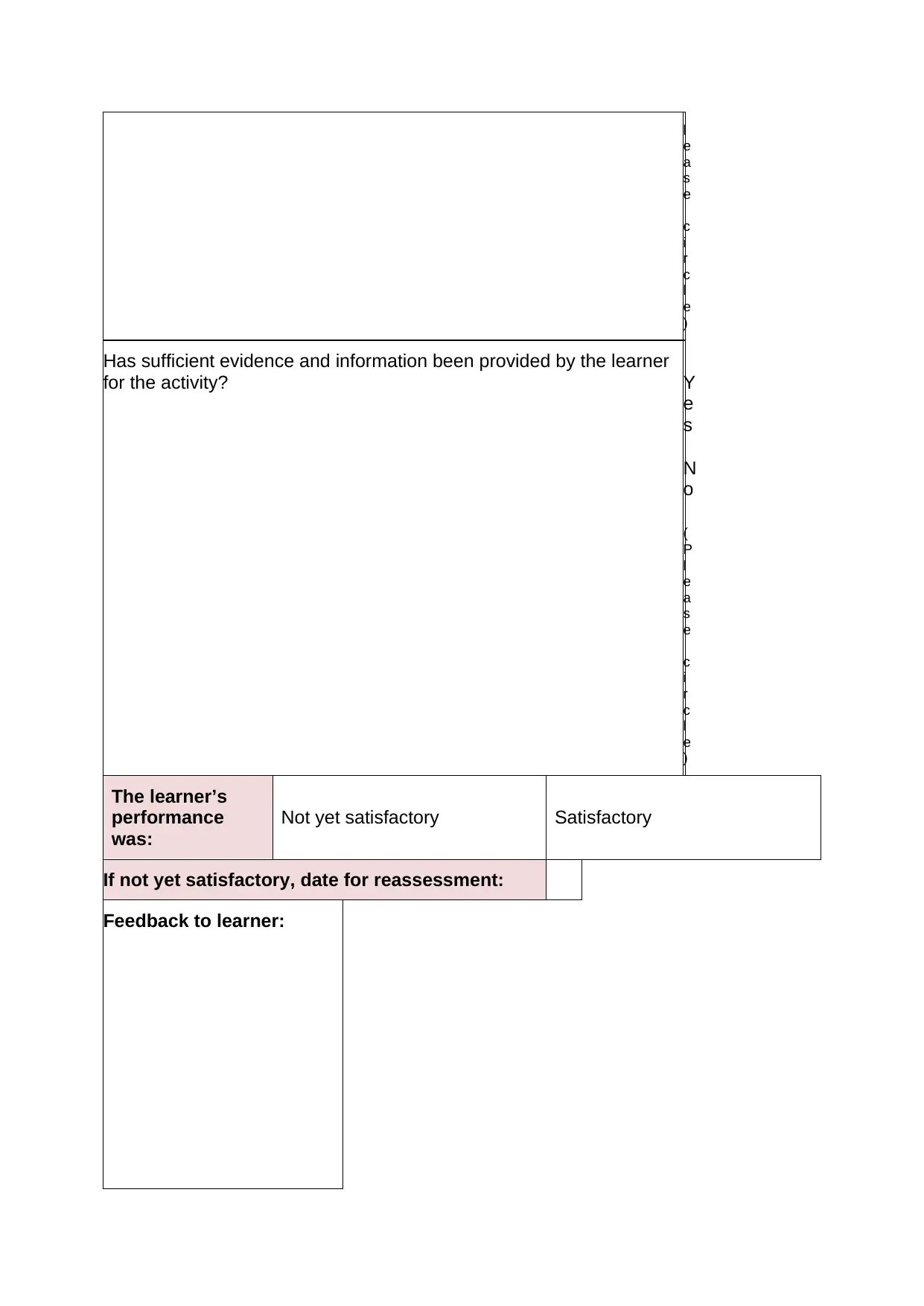
l
e
a
s
e
c
i
r
c
l
e
)
Has sufficient evidence and information been provided by the learner
for the activity? Y
e
s
N
o
(
P
l
e
a
s
e
c
i
r
c
l
e
)
The learner’s
performance
was:
Not yet satisfactory Satisfactory
If not yet satisfactory, date for reassessment:
Feedback to learner:
e
a
s
e
c
i
r
c
l
e
)
Has sufficient evidence and information been provided by the learner
for the activity? Y
e
s
N
o
(
P
l
e
a
s
e
c
i
r
c
l
e
)
The learner’s
performance
was:
Not yet satisfactory Satisfactory
If not yet satisfactory, date for reassessment:
Feedback to learner:
Paraphrase This Document
Need a fresh take? Get an instant paraphrase of this document with our AI Paraphraser
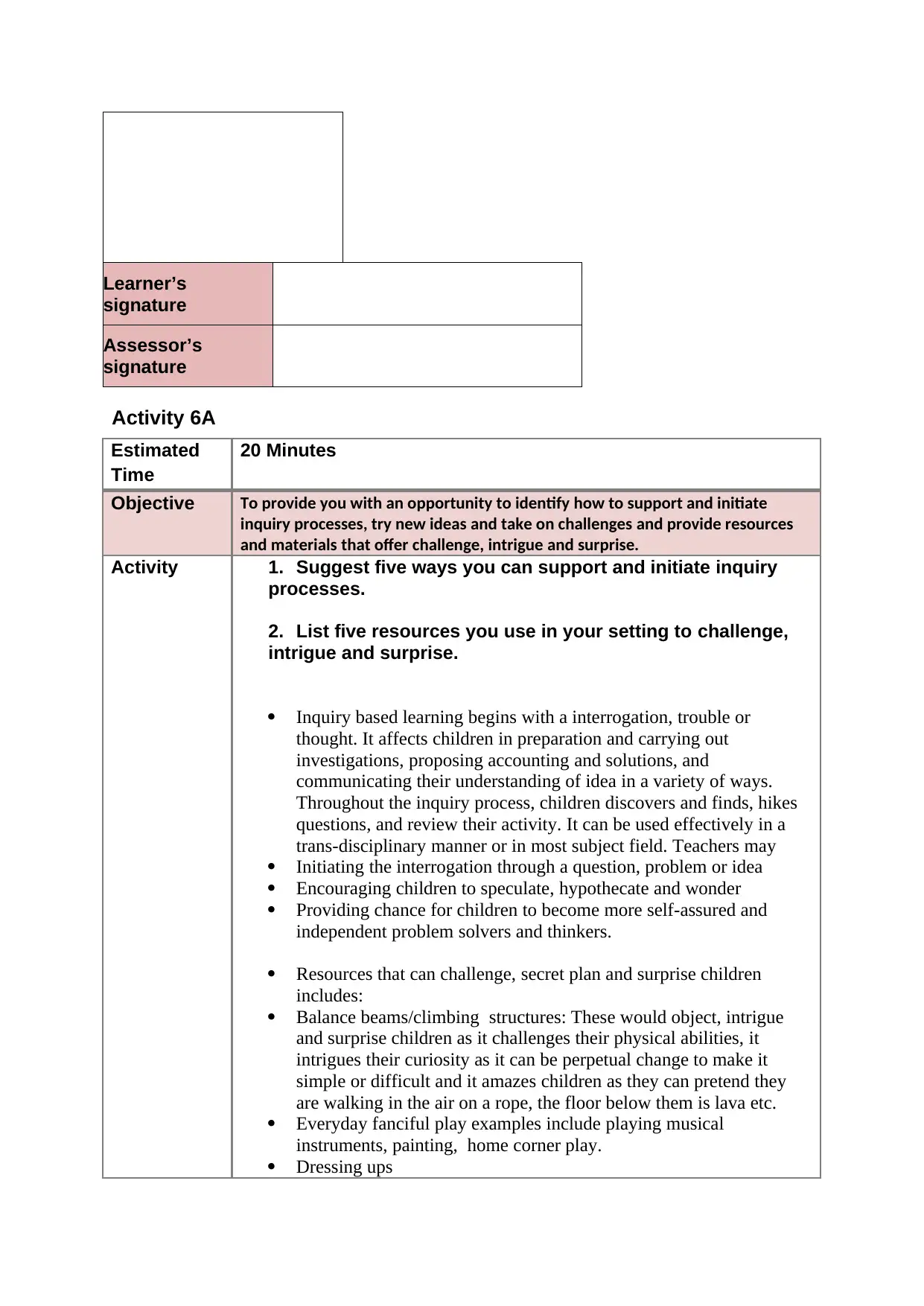
Learner’s
signature
Assessor’s
signature
Activity 6A
Estimated
Time
20 Minutes
Objective To provide you with an opportunity to identify how to support and initiate
inquiry processes, try new ideas and take on challenges and provide resources
and materials that offer challenge, intrigue and surprise.
Activity 1. Suggest five ways you can support and initiate inquiry
processes.
2. List five resources you use in your setting to challenge,
intrigue and surprise.
Inquiry based learning begins with a interrogation, trouble or
thought. It affects children in preparation and carrying out
investigations, proposing accounting and solutions, and
communicating their understanding of idea in a variety of ways.
Throughout the inquiry process, children discovers and finds, hikes
questions, and review their activity. It can be used effectively in a
trans-disciplinary manner or in most subject field. Teachers may
Initiating the interrogation through a question, problem or idea
Encouraging children to speculate, hypothecate and wonder
Providing chance for children to become more self-assured and
independent problem solvers and thinkers.
Resources that can challenge, secret plan and surprise children
includes:
Balance beams/climbing structures: These would object, intrigue
and surprise children as it challenges their physical abilities, it
intrigues their curiosity as it can be perpetual change to make it
simple or difficult and it amazes children as they can pretend they
are walking in the air on a rope, the floor below them is lava etc.
Everyday fanciful play examples include playing musical
instruments, painting, home corner play.
Dressing ups
signature
Assessor’s
signature
Activity 6A
Estimated
Time
20 Minutes
Objective To provide you with an opportunity to identify how to support and initiate
inquiry processes, try new ideas and take on challenges and provide resources
and materials that offer challenge, intrigue and surprise.
Activity 1. Suggest five ways you can support and initiate inquiry
processes.
2. List five resources you use in your setting to challenge,
intrigue and surprise.
Inquiry based learning begins with a interrogation, trouble or
thought. It affects children in preparation and carrying out
investigations, proposing accounting and solutions, and
communicating their understanding of idea in a variety of ways.
Throughout the inquiry process, children discovers and finds, hikes
questions, and review their activity. It can be used effectively in a
trans-disciplinary manner or in most subject field. Teachers may
Initiating the interrogation through a question, problem or idea
Encouraging children to speculate, hypothecate and wonder
Providing chance for children to become more self-assured and
independent problem solvers and thinkers.
Resources that can challenge, secret plan and surprise children
includes:
Balance beams/climbing structures: These would object, intrigue
and surprise children as it challenges their physical abilities, it
intrigues their curiosity as it can be perpetual change to make it
simple or difficult and it amazes children as they can pretend they
are walking in the air on a rope, the floor below them is lava etc.
Everyday fanciful play examples include playing musical
instruments, painting, home corner play.
Dressing ups
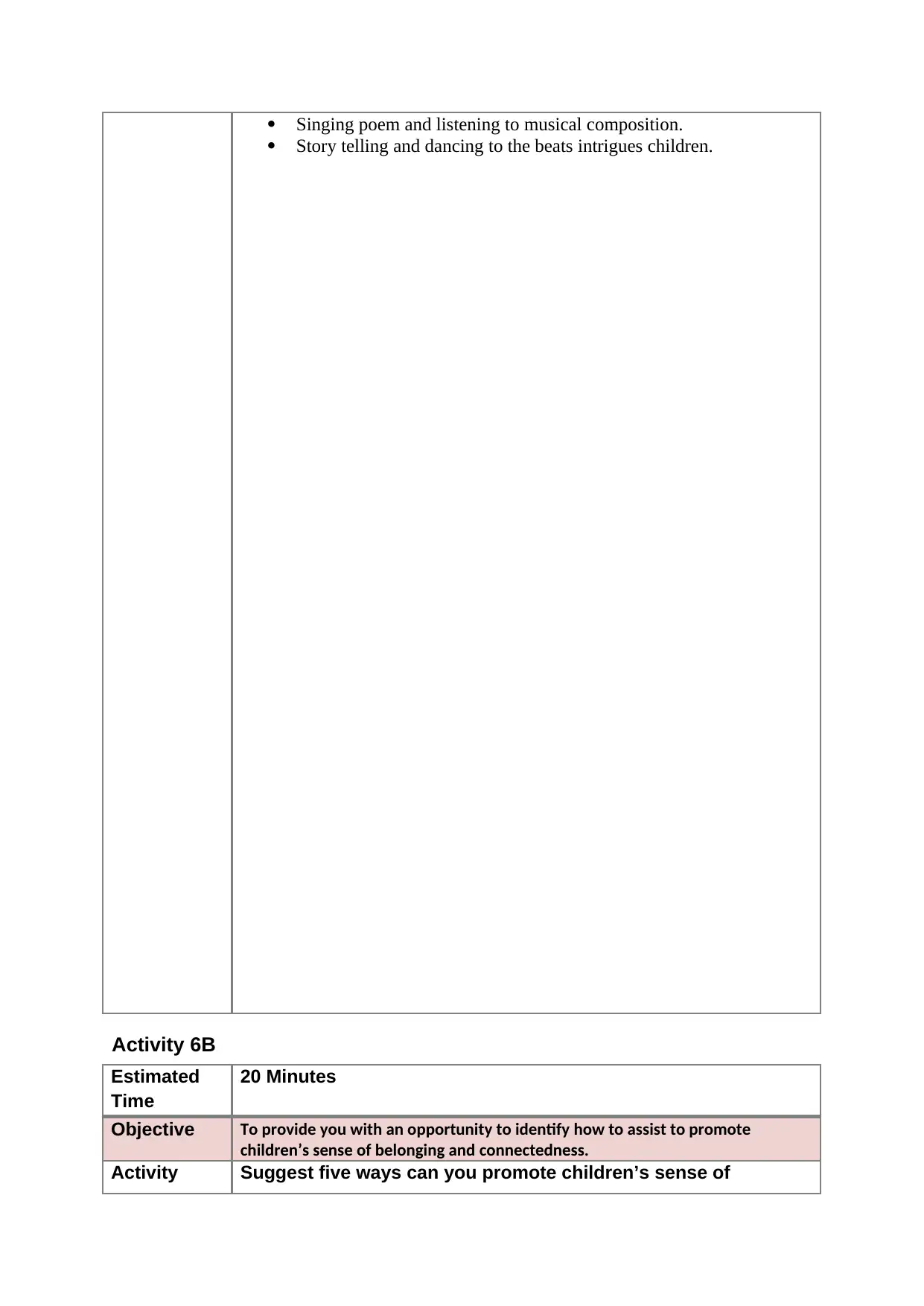
Singing poem and listening to musical composition.
Story telling and dancing to the beats intrigues children.
Activity 6B
Estimated
Time
20 Minutes
Objective To provide you with an opportunity to identify how to assist to promote
children’s sense of belonging and connectedness.
Activity Suggest five ways can you promote children’s sense of
Story telling and dancing to the beats intrigues children.
Activity 6B
Estimated
Time
20 Minutes
Objective To provide you with an opportunity to identify how to assist to promote
children’s sense of belonging and connectedness.
Activity Suggest five ways can you promote children’s sense of
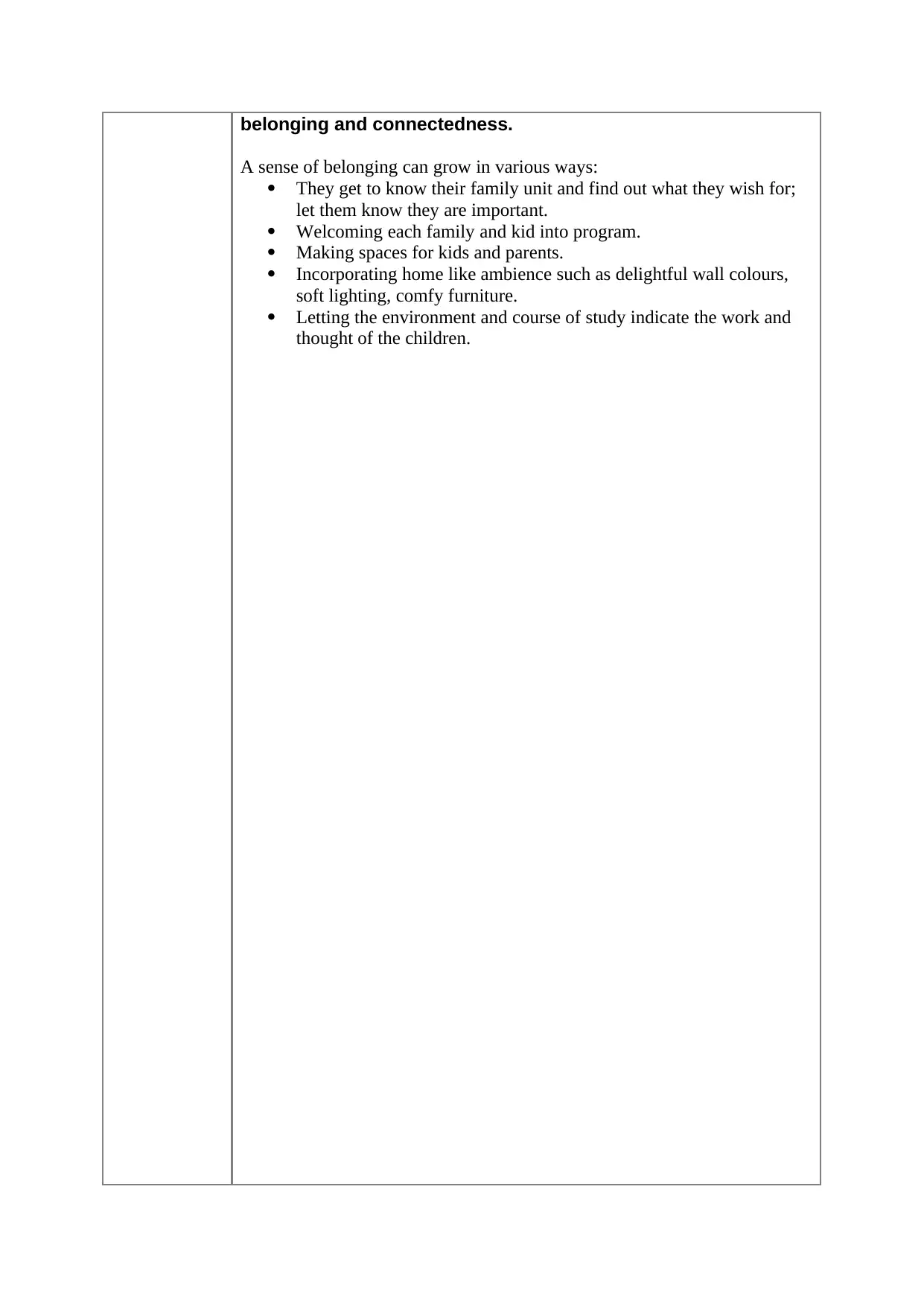
belonging and connectedness.
A sense of belonging can grow in various ways:
They get to know their family unit and find out what they wish for;
let them know they are important.
Welcoming each family and kid into program.
Making spaces for kids and parents.
Incorporating home like ambience such as delightful wall colours,
soft lighting, comfy furniture.
Letting the environment and course of study indicate the work and
thought of the children.
A sense of belonging can grow in various ways:
They get to know their family unit and find out what they wish for;
let them know they are important.
Welcoming each family and kid into program.
Making spaces for kids and parents.
Incorporating home like ambience such as delightful wall colours,
soft lighting, comfy furniture.
Letting the environment and course of study indicate the work and
thought of the children.
Secure Best Marks with AI Grader
Need help grading? Try our AI Grader for instant feedback on your assignments.

Activity 6C
Estimated
Time
30 Minutes
Objective To provide you with an opportunity to identify how to engage children in
sustained shared conversations to extend their thinking.
Activity 1. Define sustained shared conversations, and suggest
three types of questions you may ask.
2. List five techniques you can use to engage in sustained
shared conversations.
Sustained shared conversation is all about engaging children and
educators working in speech communication which render to talk
about and think about difficulty or challenges in a sincere, lengthy
way. It is an extra conversation rather than just reacting to directions
“pick up”, “clean up”. Some of questions for extending and
encouraging sustained shared conversation in children may include:
What do you think?
How do you know?
How could we find out?
Techniques that can be used to engage in sustained shared
conversations includes:
Showing genuine interest in their ideas and theories can be beneficial
to engage in sustained shared conversations.
Recapping what they have said, sometimes reminding them of what
they have said in an earlier related speech communication.
Clarifying what they meant, sometimes interrogating open-ended
questioning such as “what if?” or “what next” that will encourage
them to prosper a thought.
Expanding views, opinions and thoughts on their answers.
Using an interesting voice to have a smooth conversation so that the
child feels comfortable in talking.
Estimated
Time
30 Minutes
Objective To provide you with an opportunity to identify how to engage children in
sustained shared conversations to extend their thinking.
Activity 1. Define sustained shared conversations, and suggest
three types of questions you may ask.
2. List five techniques you can use to engage in sustained
shared conversations.
Sustained shared conversation is all about engaging children and
educators working in speech communication which render to talk
about and think about difficulty or challenges in a sincere, lengthy
way. It is an extra conversation rather than just reacting to directions
“pick up”, “clean up”. Some of questions for extending and
encouraging sustained shared conversation in children may include:
What do you think?
How do you know?
How could we find out?
Techniques that can be used to engage in sustained shared
conversations includes:
Showing genuine interest in their ideas and theories can be beneficial
to engage in sustained shared conversations.
Recapping what they have said, sometimes reminding them of what
they have said in an earlier related speech communication.
Clarifying what they meant, sometimes interrogating open-ended
questioning such as “what if?” or “what next” that will encourage
them to prosper a thought.
Expanding views, opinions and thoughts on their answers.
Using an interesting voice to have a smooth conversation so that the
child feels comfortable in talking.

Activity 6D
Estimated
Time
20 Minutes
Objective To provide you with an opportunity to identify how to provide the opportunity
for scaffolding learning and development.
Activity 1. In approximately 50 words, define scaffolding.
2. Give an example of when you have put scaffolding into
practice. You may need to list:
The scenario
The child’s needs
What each person said or did.
Estimated
Time
20 Minutes
Objective To provide you with an opportunity to identify how to provide the opportunity
for scaffolding learning and development.
Activity 1. In approximately 50 words, define scaffolding.
2. Give an example of when you have put scaffolding into
practice. You may need to list:
The scenario
The child’s needs
What each person said or did.

Scaffolding is a impermanent structure created to ease the
construction, fix or maintenance of walls when the work is to be
carried out at the height of more than 1.5m. It may be conveyed
provided on both sides or only one side of the wall.
2:
construction, fix or maintenance of walls when the work is to be
carried out at the height of more than 1.5m. It may be conveyed
provided on both sides or only one side of the wall.
2:
Paraphrase This Document
Need a fresh take? Get an instant paraphrase of this document with our AI Paraphraser
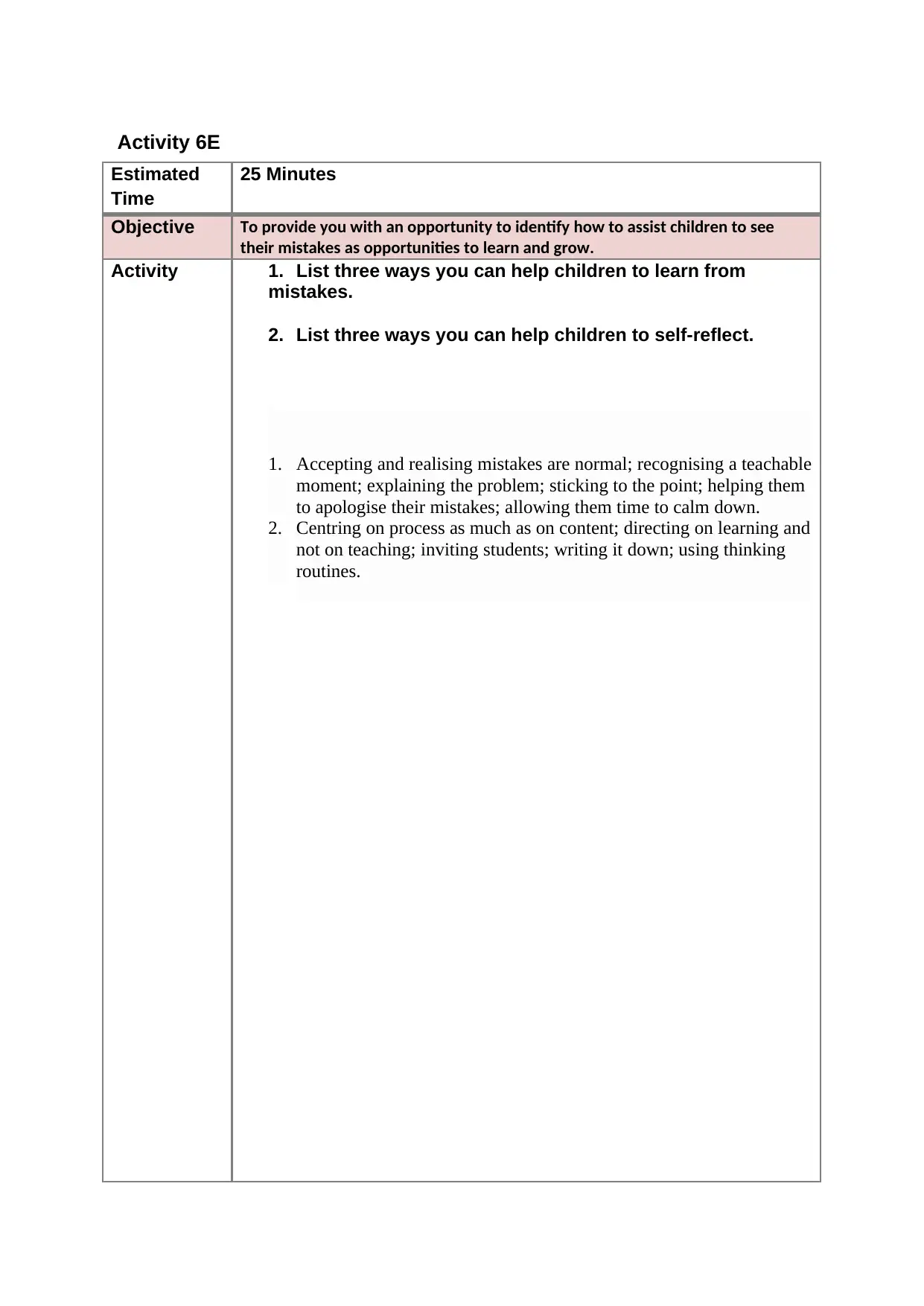
Activity 6E
Estimated
Time
25 Minutes
Objective To provide you with an opportunity to identify how to assist children to see
their mistakes as opportunities to learn and grow.
Activity 1. List three ways you can help children to learn from
mistakes.
2. List three ways you can help children to self-reflect.
1. Accepting and realising mistakes are normal; recognising a teachable
moment; explaining the problem; sticking to the point; helping them
to apologise their mistakes; allowing them time to calm down.
2. Centring on process as much as on content; directing on learning and
not on teaching; inviting students; writing it down; using thinking
routines.
Estimated
Time
25 Minutes
Objective To provide you with an opportunity to identify how to assist children to see
their mistakes as opportunities to learn and grow.
Activity 1. List three ways you can help children to learn from
mistakes.
2. List three ways you can help children to self-reflect.
1. Accepting and realising mistakes are normal; recognising a teachable
moment; explaining the problem; sticking to the point; helping them
to apologise their mistakes; allowing them time to calm down.
2. Centring on process as much as on content; directing on learning and
not on teaching; inviting students; writing it down; using thinking
routines.

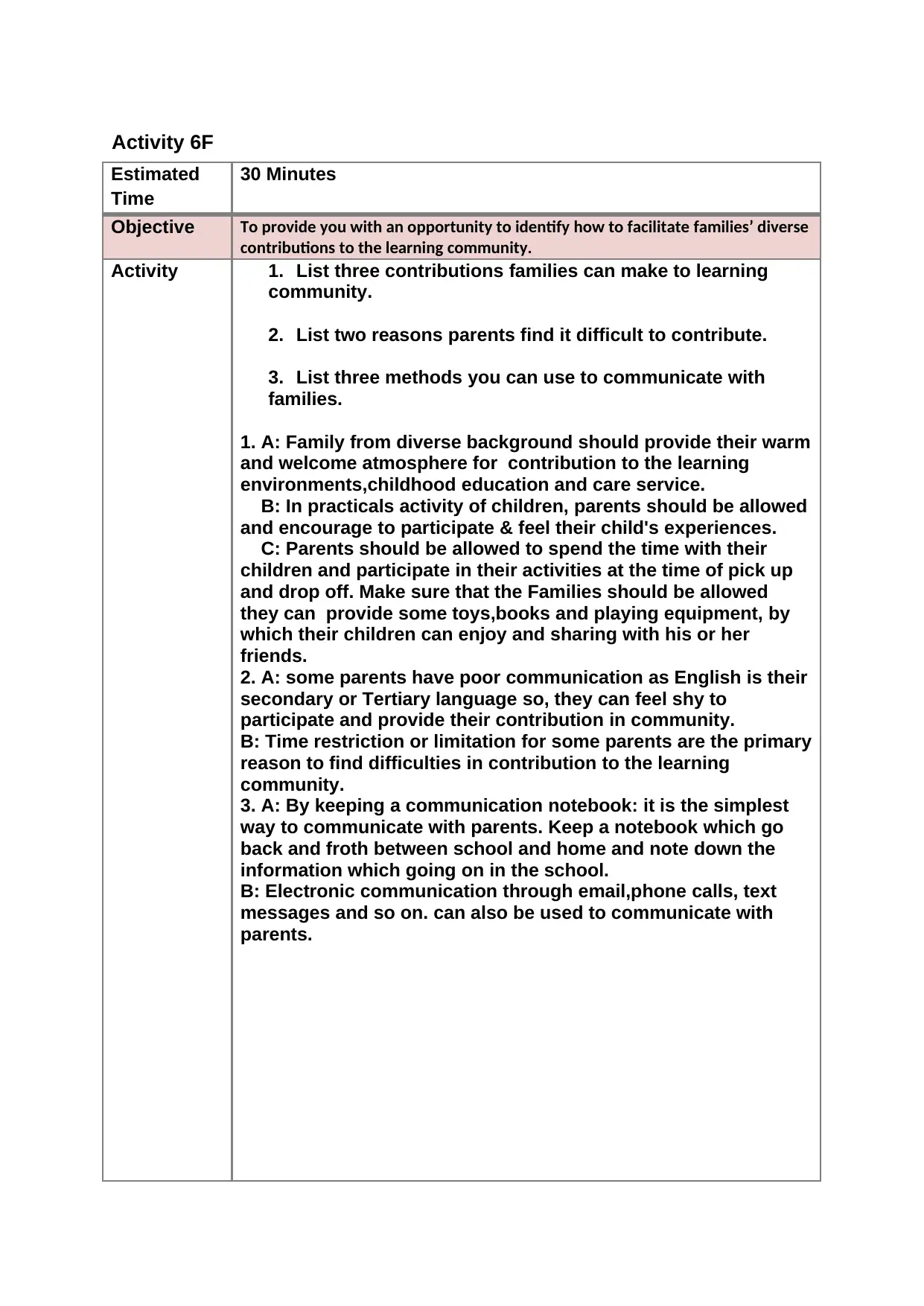
Activity 6F
Estimated
Time
30 Minutes
Objective To provide you with an opportunity to identify how to facilitate families’ diverse
contributions to the learning community.
Activity 1. List three contributions families can make to learning
community.
2. List two reasons parents find it difficult to contribute.
3. List three methods you can use to communicate with
families.
1. A: Family from diverse background should provide their warm
and welcome atmosphere for contribution to the learning
environments,childhood education and care service.
B: In practicals activity of children, parents should be allowed
and encourage to participate & feel their child's experiences.
C: Parents should be allowed to spend the time with their
children and participate in their activities at the time of pick up
and drop off. Make sure that the Families should be allowed
they can provide some toys,books and playing equipment, by
which their children can enjoy and sharing with his or her
friends.
2. A: some parents have poor communication as English is their
secondary or Tertiary language so, they can feel shy to
participate and provide their contribution in community.
B: Time restriction or limitation for some parents are the primary
reason to find difficulties in contribution to the learning
community.
3. A: By keeping a communication notebook: it is the simplest
way to communicate with parents. Keep a notebook which go
back and froth between school and home and note down the
information which going on in the school.
B: Electronic communication through email,phone calls, text
messages and so on. can also be used to communicate with
parents.
Estimated
Time
30 Minutes
Objective To provide you with an opportunity to identify how to facilitate families’ diverse
contributions to the learning community.
Activity 1. List three contributions families can make to learning
community.
2. List two reasons parents find it difficult to contribute.
3. List three methods you can use to communicate with
families.
1. A: Family from diverse background should provide their warm
and welcome atmosphere for contribution to the learning
environments,childhood education and care service.
B: In practicals activity of children, parents should be allowed
and encourage to participate & feel their child's experiences.
C: Parents should be allowed to spend the time with their
children and participate in their activities at the time of pick up
and drop off. Make sure that the Families should be allowed
they can provide some toys,books and playing equipment, by
which their children can enjoy and sharing with his or her
friends.
2. A: some parents have poor communication as English is their
secondary or Tertiary language so, they can feel shy to
participate and provide their contribution in community.
B: Time restriction or limitation for some parents are the primary
reason to find difficulties in contribution to the learning
community.
3. A: By keeping a communication notebook: it is the simplest
way to communicate with parents. Keep a notebook which go
back and froth between school and home and note down the
information which going on in the school.
B: Electronic communication through email,phone calls, text
messages and so on. can also be used to communicate with
parents.
Secure Best Marks with AI Grader
Need help grading? Try our AI Grader for instant feedback on your assignments.
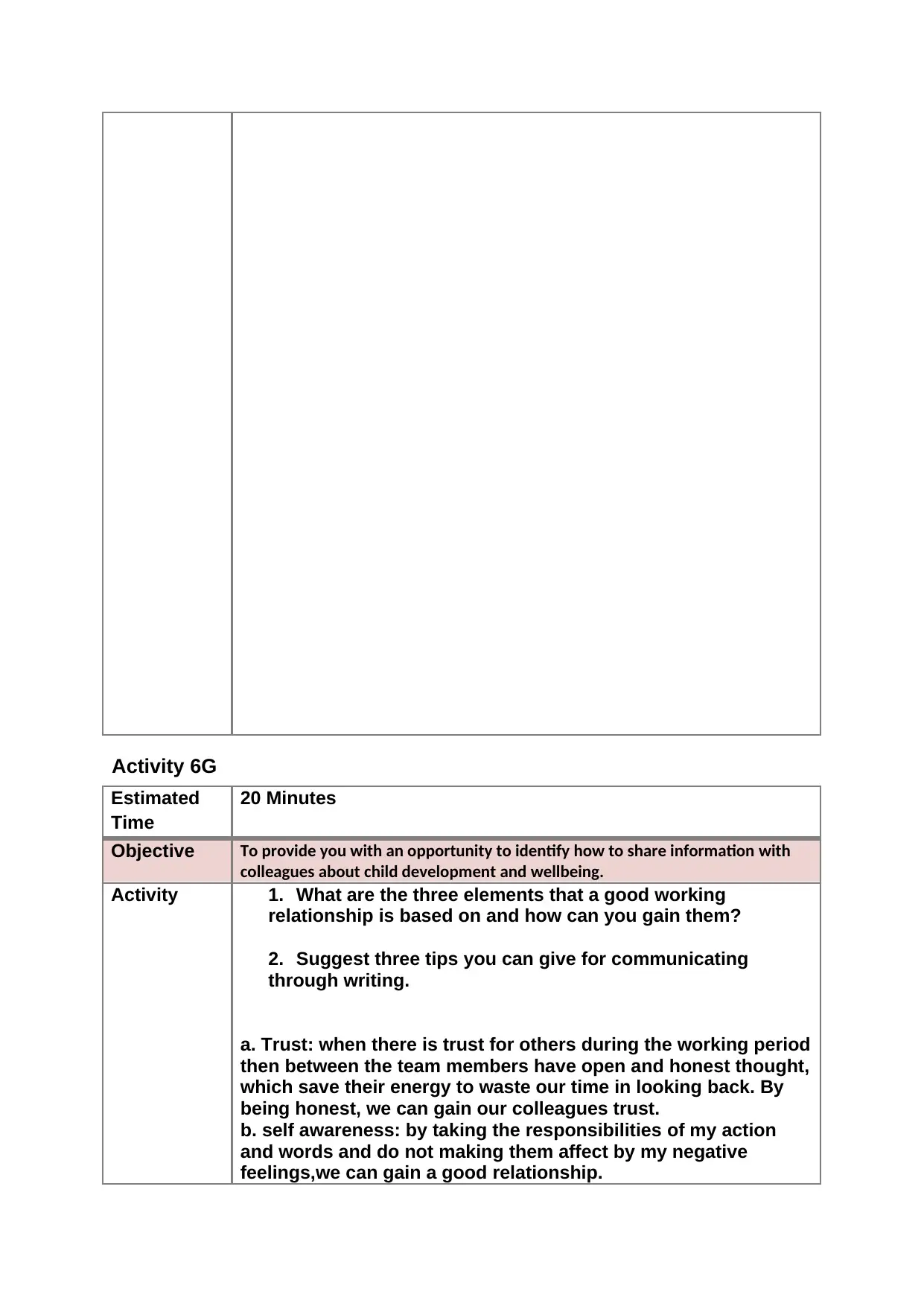
Activity 6G
Estimated
Time
20 Minutes
Objective To provide you with an opportunity to identify how to share information with
colleagues about child development and wellbeing.
Activity 1. What are the three elements that a good working
relationship is based on and how can you gain them?
2. Suggest three tips you can give for communicating
through writing.
a. Trust: when there is trust for others during the working period
then between the team members have open and honest thought,
which save their energy to waste our time in looking back. By
being honest, we can gain our colleagues trust.
b. self awareness: by taking the responsibilities of my action
and words and do not making them affect by my negative
feelings,we can gain a good relationship.
Estimated
Time
20 Minutes
Objective To provide you with an opportunity to identify how to share information with
colleagues about child development and wellbeing.
Activity 1. What are the three elements that a good working
relationship is based on and how can you gain them?
2. Suggest three tips you can give for communicating
through writing.
a. Trust: when there is trust for others during the working period
then between the team members have open and honest thought,
which save their energy to waste our time in looking back. By
being honest, we can gain our colleagues trust.
b. self awareness: by taking the responsibilities of my action
and words and do not making them affect by my negative
feelings,we can gain a good relationship.
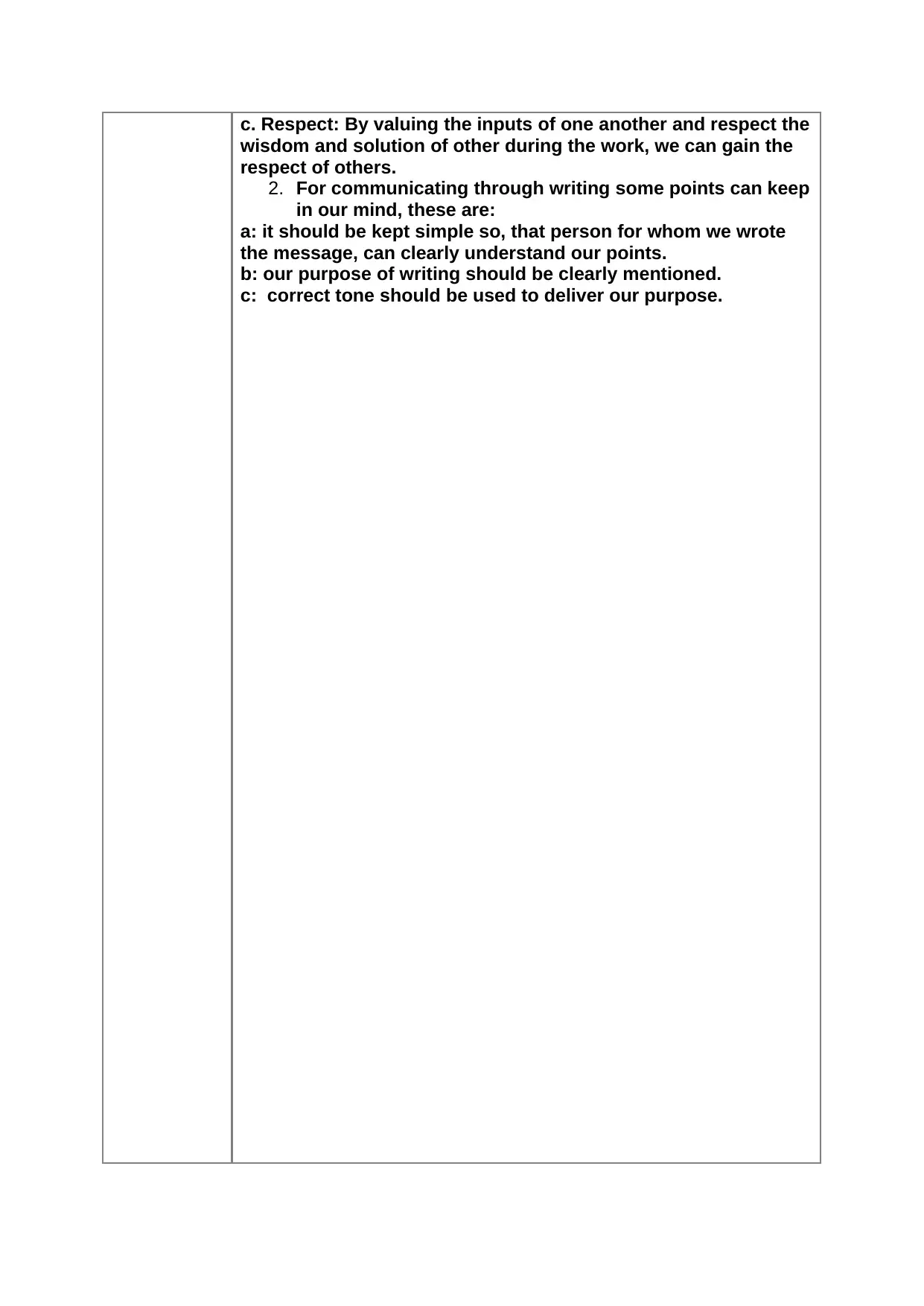
c. Respect: By valuing the inputs of one another and respect the
wisdom and solution of other during the work, we can gain the
respect of others.
2. For communicating through writing some points can keep
in our mind, these are:
a: it should be kept simple so, that person for whom we wrote
the message, can clearly understand our points.
b: our purpose of writing should be clearly mentioned.
c: correct tone should be used to deliver our purpose.
wisdom and solution of other during the work, we can gain the
respect of others.
2. For communicating through writing some points can keep
in our mind, these are:
a: it should be kept simple so, that person for whom we wrote
the message, can clearly understand our points.
b: our purpose of writing should be clearly mentioned.
c: correct tone should be used to deliver our purpose.
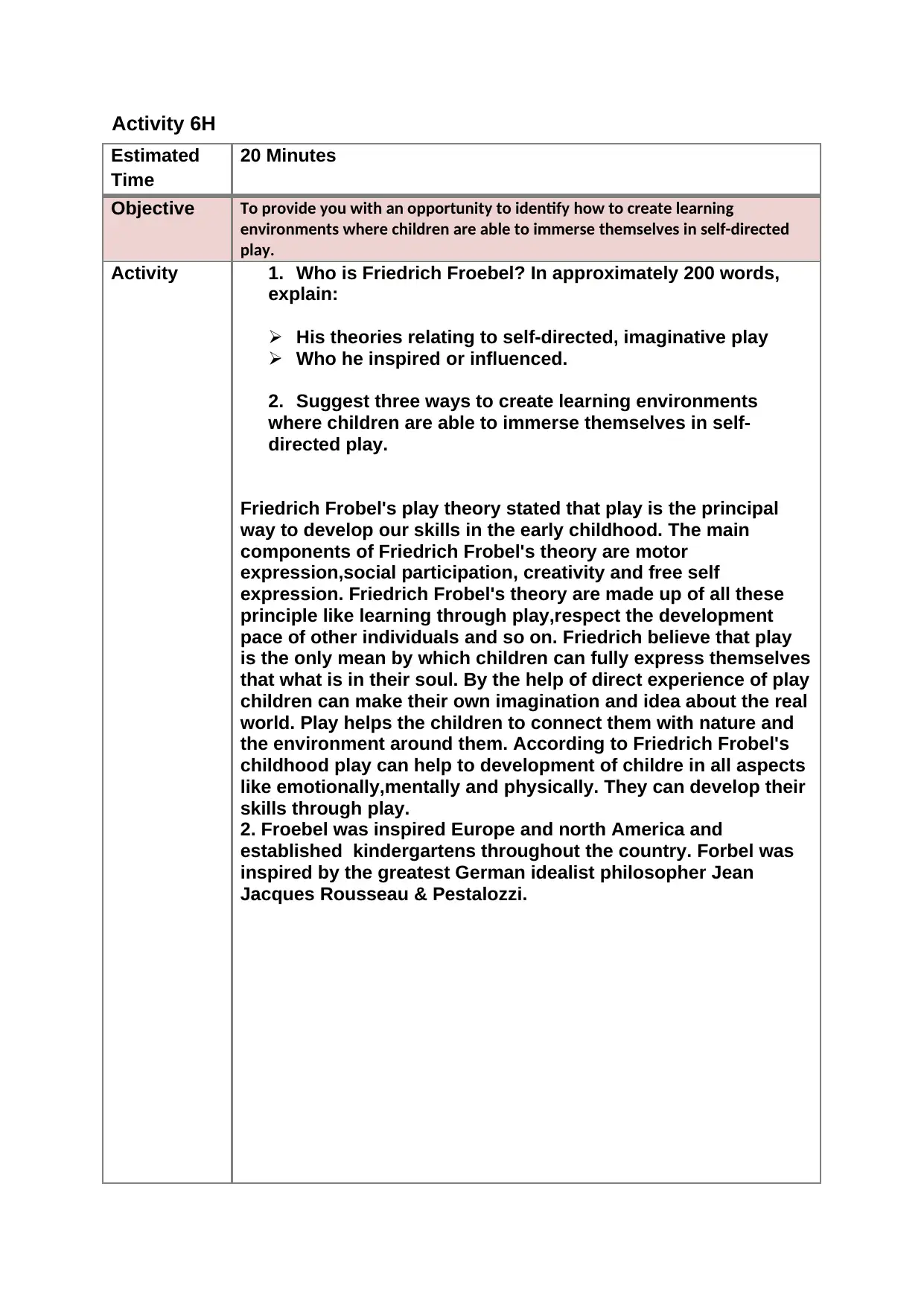
Activity 6H
Estimated
Time
20 Minutes
Objective To provide you with an opportunity to identify how to create learning
environments where children are able to immerse themselves in self-directed
play.
Activity 1. Who is Friedrich Froebel? In approximately 200 words,
explain:
His theories relating to self-directed, imaginative play
Who he inspired or influenced.
2. Suggest three ways to create learning environments
where children are able to immerse themselves in self-
directed play.
Friedrich Frobel's play theory stated that play is the principal
way to develop our skills in the early childhood. The main
components of Friedrich Frobel's theory are motor
expression,social participation, creativity and free self
expression. Friedrich Frobel's theory are made up of all these
principle like learning through play,respect the development
pace of other individuals and so on. Friedrich believe that play
is the only mean by which children can fully express themselves
that what is in their soul. By the help of direct experience of play
children can make their own imagination and idea about the real
world. Play helps the children to connect them with nature and
the environment around them. According to Friedrich Frobel's
childhood play can help to development of childre in all aspects
like emotionally,mentally and physically. They can develop their
skills through play.
2. Froebel was inspired Europe and north America and
established kindergartens throughout the country. Forbel was
inspired by the greatest German idealist philosopher Jean
Jacques Rousseau & Pestalozzi.
Estimated
Time
20 Minutes
Objective To provide you with an opportunity to identify how to create learning
environments where children are able to immerse themselves in self-directed
play.
Activity 1. Who is Friedrich Froebel? In approximately 200 words,
explain:
His theories relating to self-directed, imaginative play
Who he inspired or influenced.
2. Suggest three ways to create learning environments
where children are able to immerse themselves in self-
directed play.
Friedrich Frobel's play theory stated that play is the principal
way to develop our skills in the early childhood. The main
components of Friedrich Frobel's theory are motor
expression,social participation, creativity and free self
expression. Friedrich Frobel's theory are made up of all these
principle like learning through play,respect the development
pace of other individuals and so on. Friedrich believe that play
is the only mean by which children can fully express themselves
that what is in their soul. By the help of direct experience of play
children can make their own imagination and idea about the real
world. Play helps the children to connect them with nature and
the environment around them. According to Friedrich Frobel's
childhood play can help to development of childre in all aspects
like emotionally,mentally and physically. They can develop their
skills through play.
2. Froebel was inspired Europe and north America and
established kindergartens throughout the country. Forbel was
inspired by the greatest German idealist philosopher Jean
Jacques Rousseau & Pestalozzi.
Paraphrase This Document
Need a fresh take? Get an instant paraphrase of this document with our AI Paraphraser

Activity 6I
Estimated
Time
20 Minutes
Objective To provide you with an opportunity to identify how to recognise spontaneous
teachable moments as they occur and use them to build on children’s learning
and ensure a balance between child-initiated and educator-supported learning.
Activity 1. Give an example of when you have recognised a
spontaneous teachable moment and have used it to build on
a child’s learning. Explain:
How to moment occurred
What you did to improve the child’s learning
What the result was.
2. What is the difference between adult-led and child-led
activities?
when children asked lots of question like: how the sky is
blue, why the water flow, why the air blow, why you sing a
song, why do we have to eat, why it is raining and many
more questions like this.
For improvement of child's learning, we encouraged them
for their language development,increased the qualities of
time with our kids, helped him to developed his skills and
Estimated
Time
20 Minutes
Objective To provide you with an opportunity to identify how to recognise spontaneous
teachable moments as they occur and use them to build on children’s learning
and ensure a balance between child-initiated and educator-supported learning.
Activity 1. Give an example of when you have recognised a
spontaneous teachable moment and have used it to build on
a child’s learning. Explain:
How to moment occurred
What you did to improve the child’s learning
What the result was.
2. What is the difference between adult-led and child-led
activities?
when children asked lots of question like: how the sky is
blue, why the water flow, why the air blow, why you sing a
song, why do we have to eat, why it is raining and many
more questions like this.
For improvement of child's learning, we encouraged them
for their language development,increased the qualities of
time with our kids, helped him to developed his skills and

confidences in readings.
Results of our supports in child's learning are following:
◦ He gets too much confidence for their activity.
◦ He involved in many more activities.
◦ He performed very well in all that activities.
◦ He became familiar with all those activities which
provides benefit in their future education.
2:
Adult-led activities Child led activities
In this rules are play important
role.
There are no any rules.
Teachers,caregiver or instructor
are involved.
Adult keep their focus on child
led games.
In adults game, there are a
leader who are in charge
throughout the game.
Child may follow the adults
game.
Large group of people are
present to see their games.
They make their own rules.
Safety could be an issue in adults
game.
They stay focused on their goal.
Results of our supports in child's learning are following:
◦ He gets too much confidence for their activity.
◦ He involved in many more activities.
◦ He performed very well in all that activities.
◦ He became familiar with all those activities which
provides benefit in their future education.
2:
Adult-led activities Child led activities
In this rules are play important
role.
There are no any rules.
Teachers,caregiver or instructor
are involved.
Adult keep their focus on child
led games.
In adults game, there are a
leader who are in charge
throughout the game.
Child may follow the adults
game.
Large group of people are
present to see their games.
They make their own rules.
Safety could be an issue in adults
game.
They stay focused on their goal.
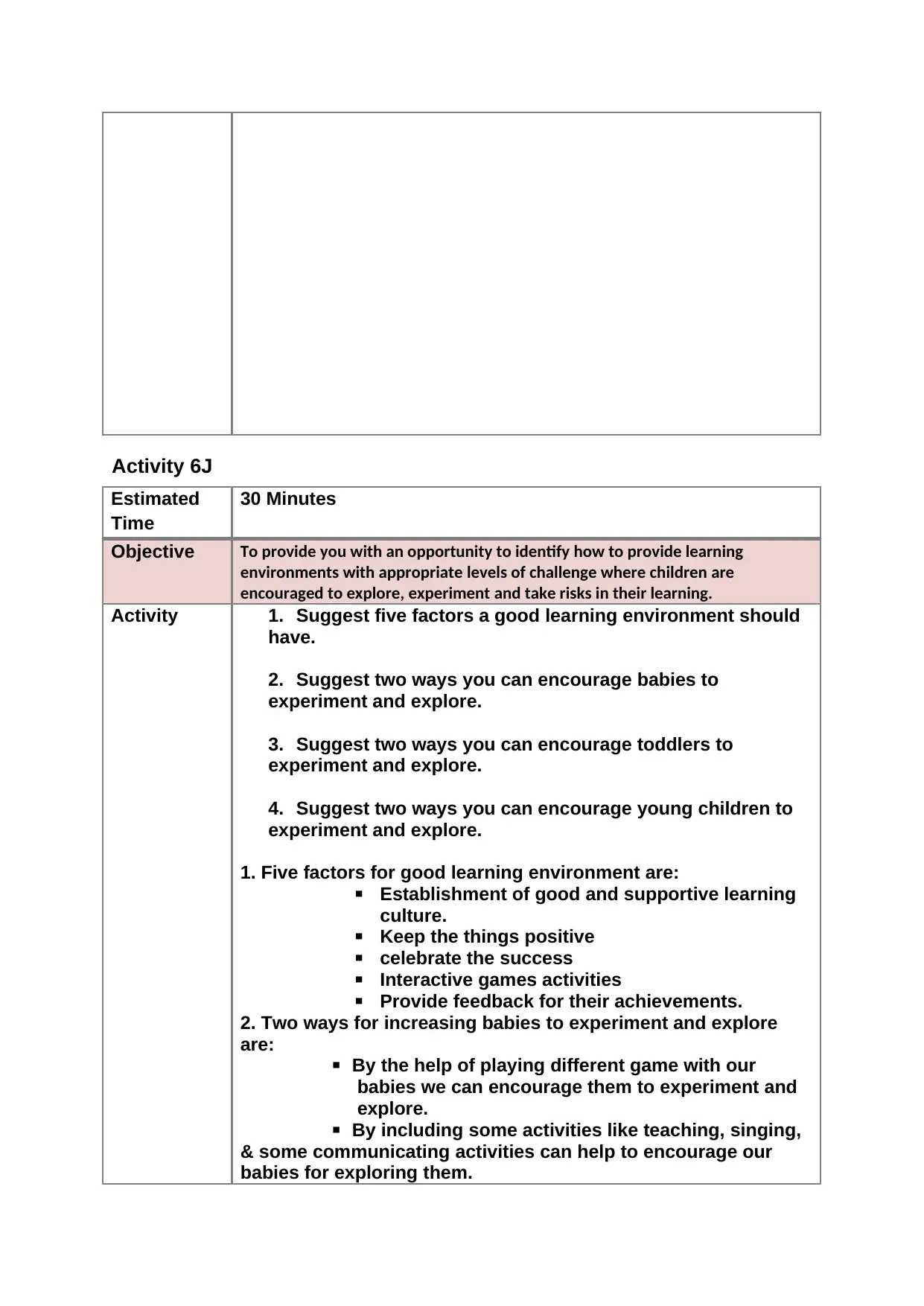
Activity 6J
Estimated
Time
30 Minutes
Objective To provide you with an opportunity to identify how to provide learning
environments with appropriate levels of challenge where children are
encouraged to explore, experiment and take risks in their learning.
Activity 1. Suggest five factors a good learning environment should
have.
2. Suggest two ways you can encourage babies to
experiment and explore.
3. Suggest two ways you can encourage toddlers to
experiment and explore.
4. Suggest two ways you can encourage young children to
experiment and explore.
1. Five factors for good learning environment are:
▪ Establishment of good and supportive learning
culture.
▪ Keep the things positive
▪ celebrate the success
▪ Interactive games activities
▪ Provide feedback for their achievements.
2. Two ways for increasing babies to experiment and explore
are:
▪ By the help of playing different game with our
babies we can encourage them to experiment and
explore.
▪ By including some activities like teaching, singing,
& some communicating activities can help to encourage our
babies for exploring them.
Estimated
Time
30 Minutes
Objective To provide you with an opportunity to identify how to provide learning
environments with appropriate levels of challenge where children are
encouraged to explore, experiment and take risks in their learning.
Activity 1. Suggest five factors a good learning environment should
have.
2. Suggest two ways you can encourage babies to
experiment and explore.
3. Suggest two ways you can encourage toddlers to
experiment and explore.
4. Suggest two ways you can encourage young children to
experiment and explore.
1. Five factors for good learning environment are:
▪ Establishment of good and supportive learning
culture.
▪ Keep the things positive
▪ celebrate the success
▪ Interactive games activities
▪ Provide feedback for their achievements.
2. Two ways for increasing babies to experiment and explore
are:
▪ By the help of playing different game with our
babies we can encourage them to experiment and
explore.
▪ By including some activities like teaching, singing,
& some communicating activities can help to encourage our
babies for exploring them.
Secure Best Marks with AI Grader
Need help grading? Try our AI Grader for instant feedback on your assignments.
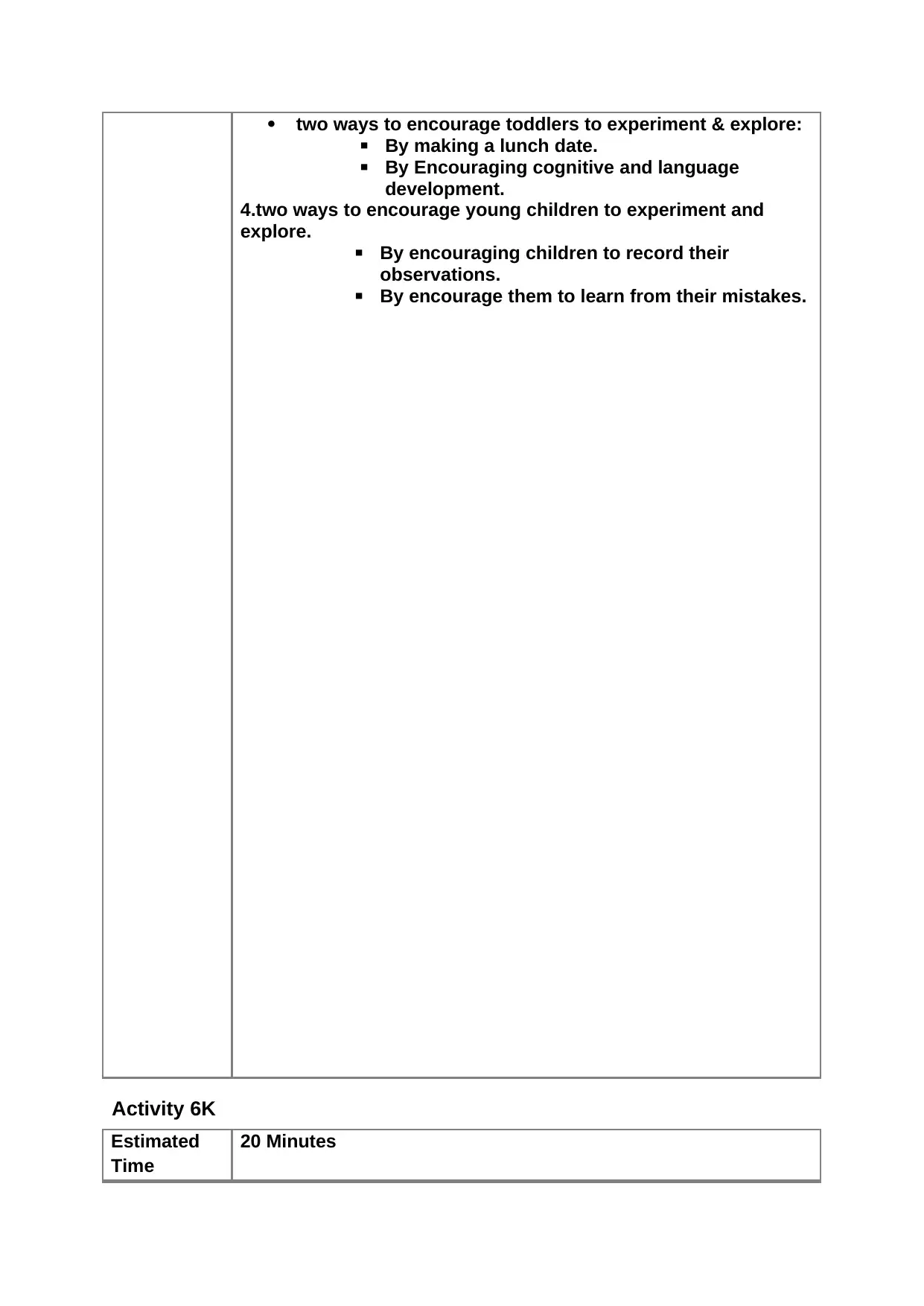
two ways to encourage toddlers to experiment & explore:
▪ By making a lunch date.
▪ By Encouraging cognitive and language
development.
4.two ways to encourage young children to experiment and
explore.
▪ By encouraging children to record their
observations.
▪ By encourage them to learn from their mistakes.
Activity 6K
Estimated
Time
20 Minutes
▪ By making a lunch date.
▪ By Encouraging cognitive and language
development.
4.two ways to encourage young children to experiment and
explore.
▪ By encouraging children to record their
observations.
▪ By encourage them to learn from their mistakes.
Activity 6K
Estimated
Time
20 Minutes
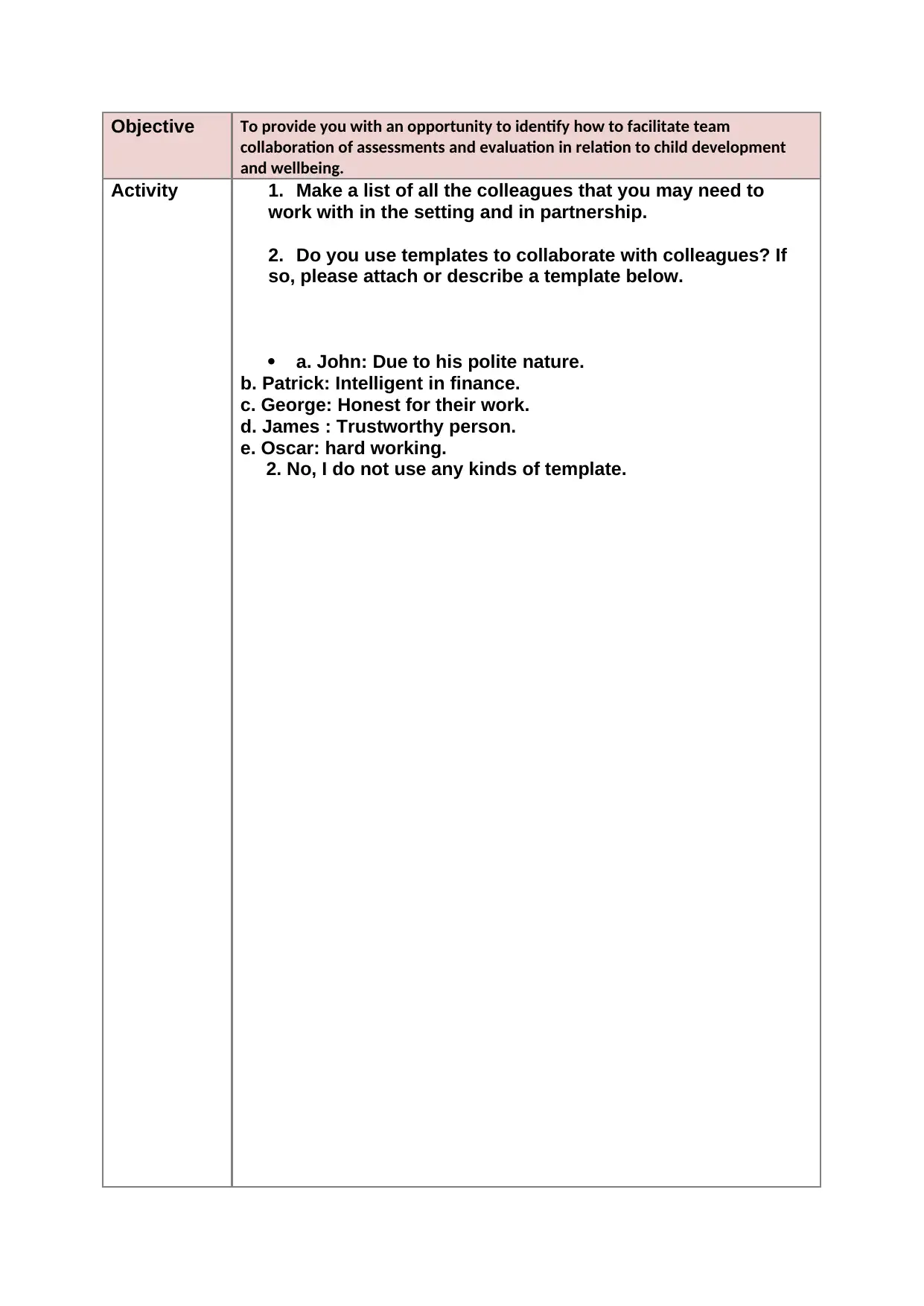
Objective To provide you with an opportunity to identify how to facilitate team
collaboration of assessments and evaluation in relation to child development
and wellbeing.
Activity 1. Make a list of all the colleagues that you may need to
work with in the setting and in partnership.
2. Do you use templates to collaborate with colleagues? If
so, please attach or describe a template below.
a. John: Due to his polite nature.
b. Patrick: Intelligent in finance.
c. George: Honest for their work.
d. James : Trustworthy person.
e. Oscar: hard working.
2. No, I do not use any kinds of template.
collaboration of assessments and evaluation in relation to child development
and wellbeing.
Activity 1. Make a list of all the colleagues that you may need to
work with in the setting and in partnership.
2. Do you use templates to collaborate with colleagues? If
so, please attach or describe a template below.
a. John: Due to his polite nature.
b. Patrick: Intelligent in finance.
c. George: Honest for their work.
d. James : Trustworthy person.
e. Oscar: hard working.
2. No, I do not use any kinds of template.
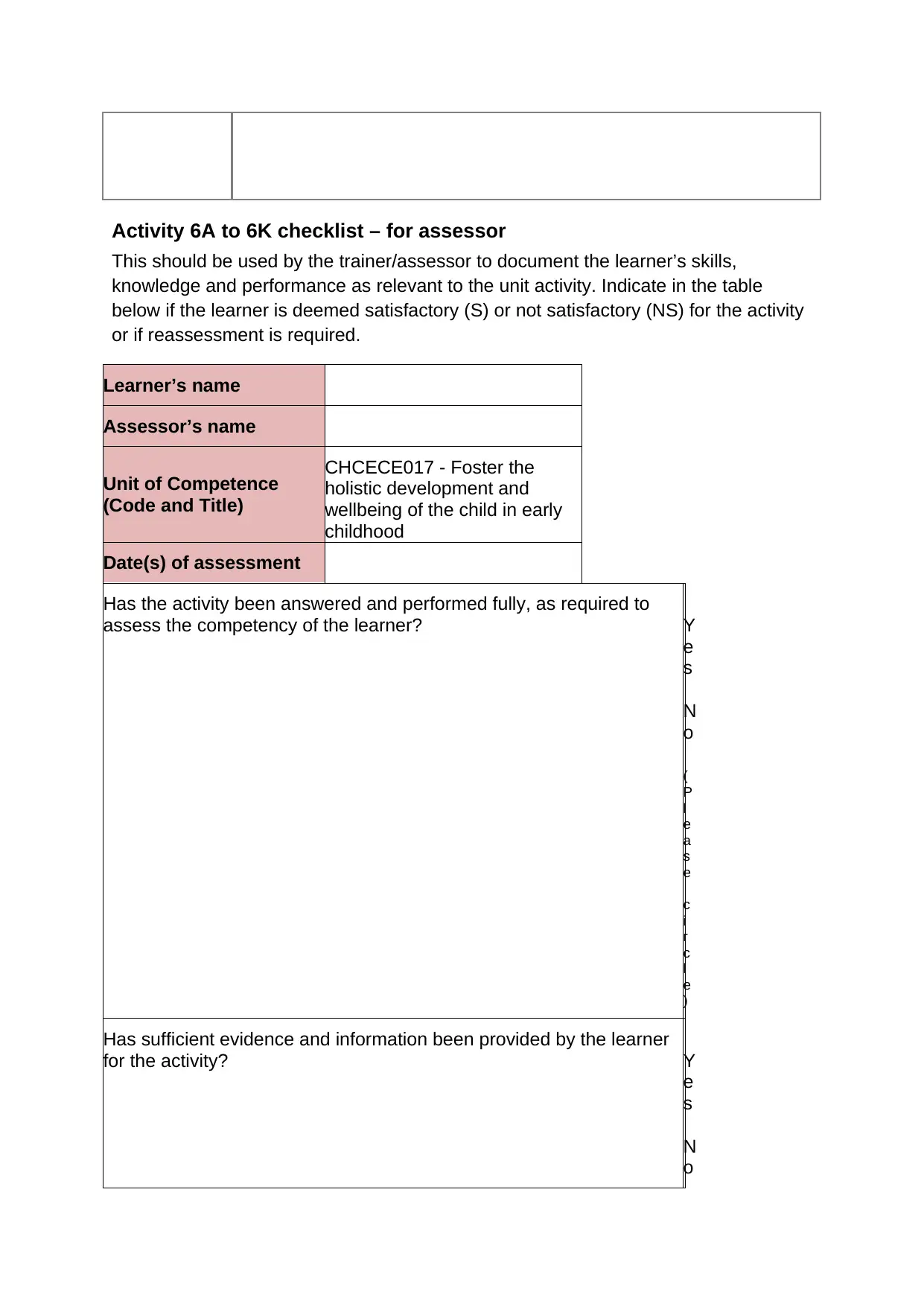
Activity 6A to 6K checklist – for assessor
This should be used by the trainer/assessor to document the learner’s skills,
knowledge and performance as relevant to the unit activity. Indicate in the table
below if the learner is deemed satisfactory (S) or not satisfactory (NS) for the activity
or if reassessment is required.
Learner’s name
Assessor’s name
Unit of Competence
(Code and Title)
CHCECE017 - Foster the
holistic development and
wellbeing of the child in early
childhood
Date(s) of assessment
Has the activity been answered and performed fully, as required to
assess the competency of the learner? Y
e
s
N
o
(
P
l
e
a
s
e
c
i
r
c
l
e
)
Has sufficient evidence and information been provided by the learner
for the activity? Y
e
s
N
o
This should be used by the trainer/assessor to document the learner’s skills,
knowledge and performance as relevant to the unit activity. Indicate in the table
below if the learner is deemed satisfactory (S) or not satisfactory (NS) for the activity
or if reassessment is required.
Learner’s name
Assessor’s name
Unit of Competence
(Code and Title)
CHCECE017 - Foster the
holistic development and
wellbeing of the child in early
childhood
Date(s) of assessment
Has the activity been answered and performed fully, as required to
assess the competency of the learner? Y
e
s
N
o
(
P
l
e
a
s
e
c
i
r
c
l
e
)
Has sufficient evidence and information been provided by the learner
for the activity? Y
e
s
N
o
Paraphrase This Document
Need a fresh take? Get an instant paraphrase of this document with our AI Paraphraser
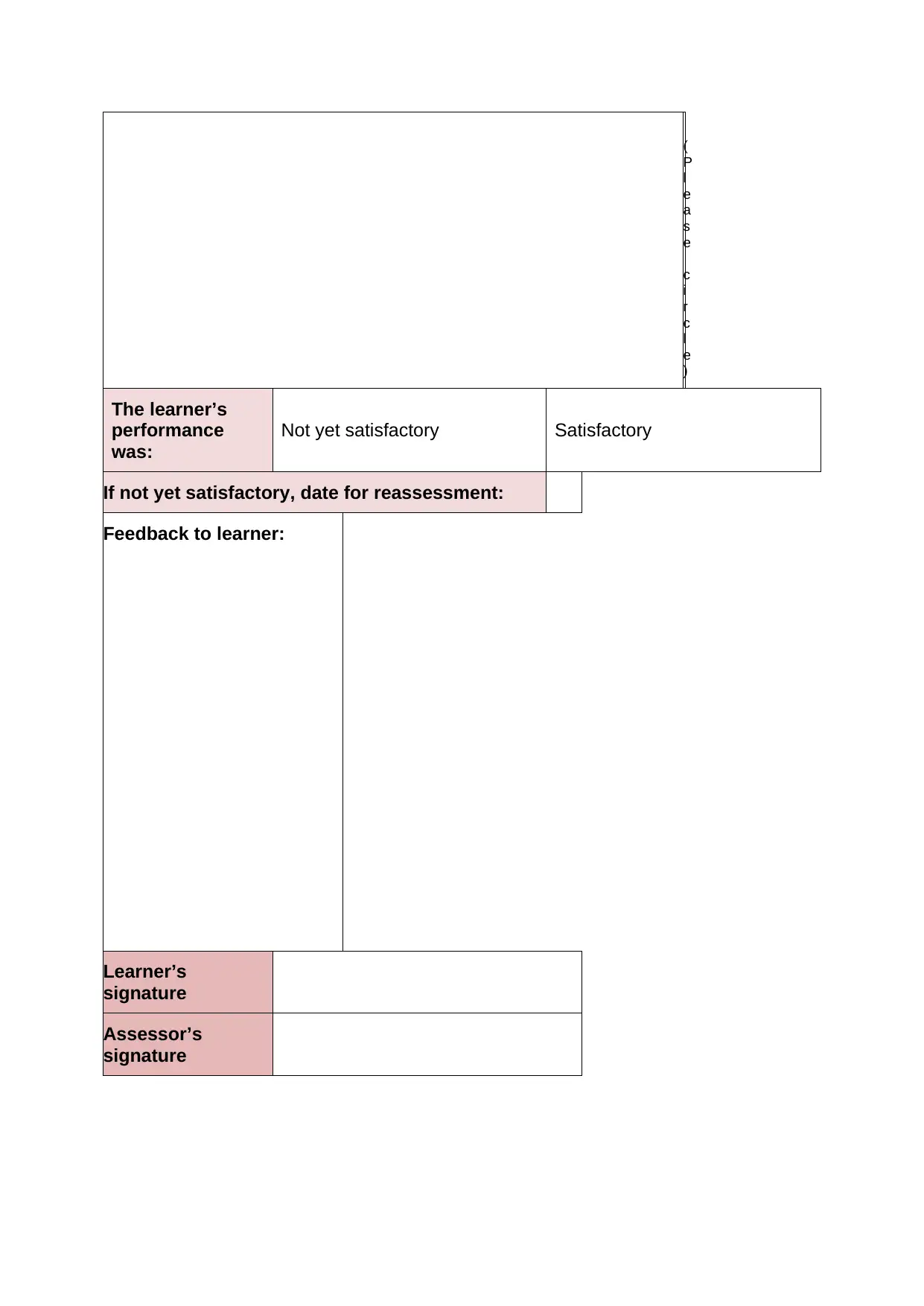
(
P
l
e
a
s
e
c
i
r
c
l
e
)
The learner’s
performance
was:
Not yet satisfactory Satisfactory
If not yet satisfactory, date for reassessment:
Feedback to learner:
Learner’s
signature
Assessor’s
signature
P
l
e
a
s
e
c
i
r
c
l
e
)
The learner’s
performance
was:
Not yet satisfactory Satisfactory
If not yet satisfactory, date for reassessment:
Feedback to learner:
Learner’s
signature
Assessor’s
signature
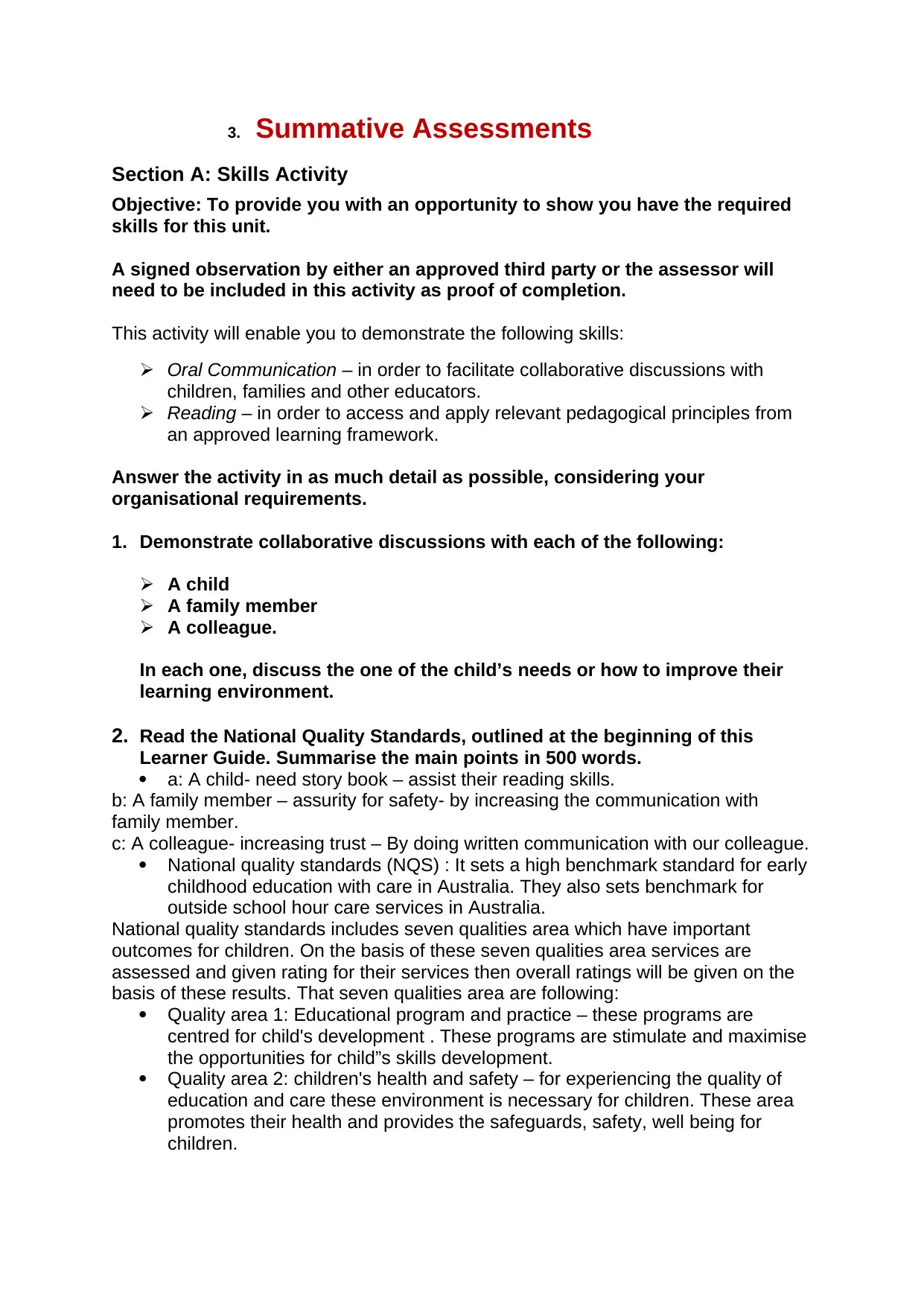
3. Summative Assessments
Section A: Skills Activity
Objective: To provide you with an opportunity to show you have the required
skills for this unit.
A signed observation by either an approved third party or the assessor will
need to be included in this activity as proof of completion.
This activity will enable you to demonstrate the following skills:
Oral Communication – in order to facilitate collaborative discussions with
children, families and other educators.
Reading – in order to access and apply relevant pedagogical principles from
an approved learning framework.
Answer the activity in as much detail as possible, considering your
organisational requirements.
1. Demonstrate collaborative discussions with each of the following:
A child
A family member
A colleague.
In each one, discuss the one of the child’s needs or how to improve their
learning environment.
2. Read the National Quality Standards, outlined at the beginning of this
Learner Guide. Summarise the main points in 500 words.
a: A child- need story book – assist their reading skills.
b: A family member – assurity for safety- by increasing the communication with
family member.
c: A colleague- increasing trust – By doing written communication with our colleague.
National quality standards (NQS) : It sets a high benchmark standard for early
childhood education with care in Australia. They also sets benchmark for
outside school hour care services in Australia.
National quality standards includes seven qualities area which have important
outcomes for children. On the basis of these seven qualities area services are
assessed and given rating for their services then overall ratings will be given on the
basis of these results. That seven qualities area are following:
Quality area 1: Educational program and practice – these programs are
centred for child's development . These programs are stimulate and maximise
the opportunities for child”s skills development.
Quality area 2: children's health and safety – for experiencing the quality of
education and care these environment is necessary for children. These area
promotes their health and provides the safeguards, safety, well being for
children.
Section A: Skills Activity
Objective: To provide you with an opportunity to show you have the required
skills for this unit.
A signed observation by either an approved third party or the assessor will
need to be included in this activity as proof of completion.
This activity will enable you to demonstrate the following skills:
Oral Communication – in order to facilitate collaborative discussions with
children, families and other educators.
Reading – in order to access and apply relevant pedagogical principles from
an approved learning framework.
Answer the activity in as much detail as possible, considering your
organisational requirements.
1. Demonstrate collaborative discussions with each of the following:
A child
A family member
A colleague.
In each one, discuss the one of the child’s needs or how to improve their
learning environment.
2. Read the National Quality Standards, outlined at the beginning of this
Learner Guide. Summarise the main points in 500 words.
a: A child- need story book – assist their reading skills.
b: A family member – assurity for safety- by increasing the communication with
family member.
c: A colleague- increasing trust – By doing written communication with our colleague.
National quality standards (NQS) : It sets a high benchmark standard for early
childhood education with care in Australia. They also sets benchmark for
outside school hour care services in Australia.
National quality standards includes seven qualities area which have important
outcomes for children. On the basis of these seven qualities area services are
assessed and given rating for their services then overall ratings will be given on the
basis of these results. That seven qualities area are following:
Quality area 1: Educational program and practice – these programs are
centred for child's development . These programs are stimulate and maximise
the opportunities for child”s skills development.
Quality area 2: children's health and safety – for experiencing the quality of
education and care these environment is necessary for children. These area
promotes their health and provides the safeguards, safety, well being for
children.
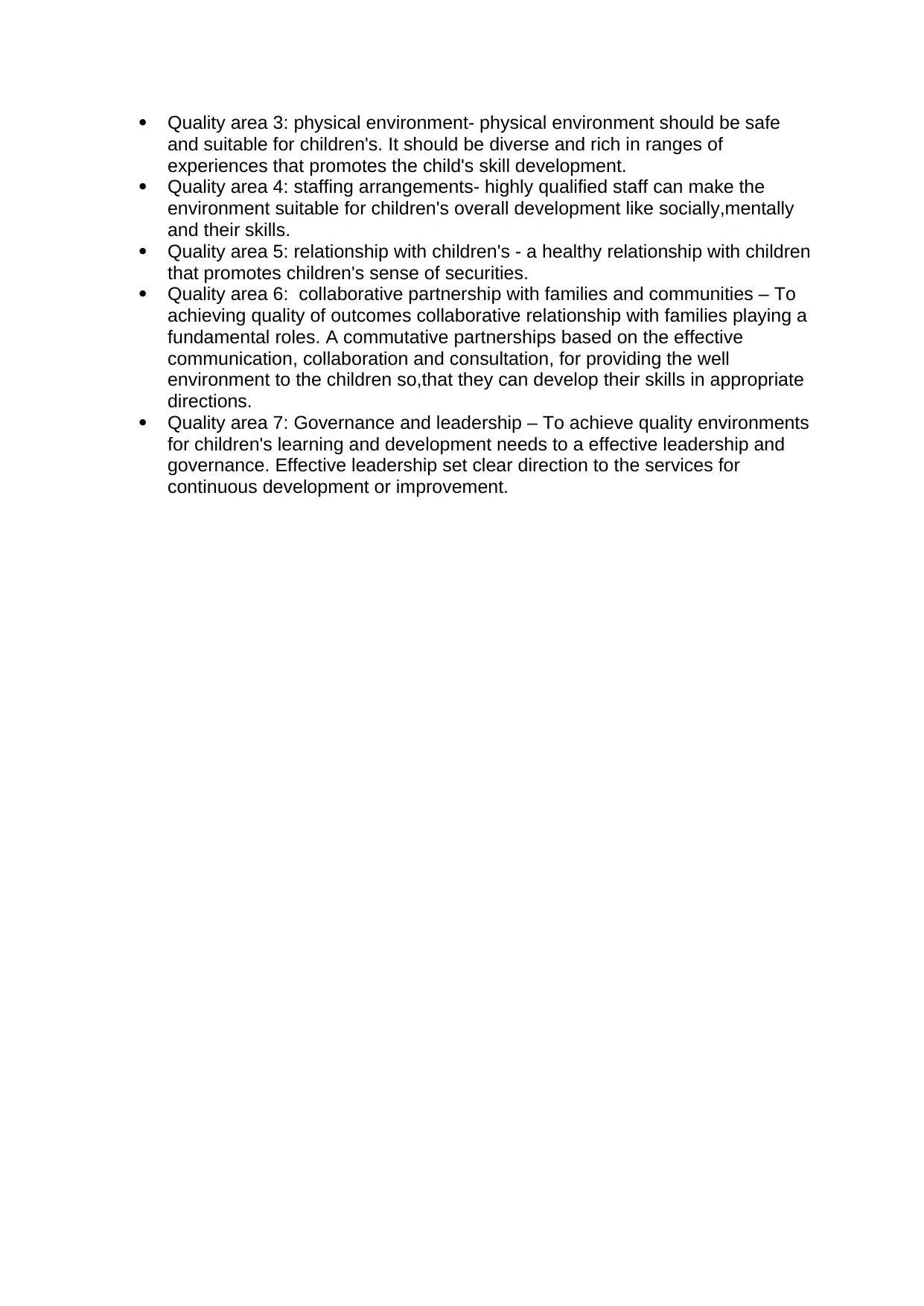
Quality area 3: physical environment- physical environment should be safe
and suitable for children's. It should be diverse and rich in ranges of
experiences that promotes the child's skill development.
Quality area 4: staffing arrangements- highly qualified staff can make the
environment suitable for children's overall development like socially,mentally
and their skills.
Quality area 5: relationship with children's - a healthy relationship with children
that promotes children's sense of securities.
Quality area 6: collaborative partnership with families and communities – To
achieving quality of outcomes collaborative relationship with families playing a
fundamental roles. A commutative partnerships based on the effective
communication, collaboration and consultation, for providing the well
environment to the children so,that they can develop their skills in appropriate
directions.
Quality area 7: Governance and leadership – To achieve quality environments
for children's learning and development needs to a effective leadership and
governance. Effective leadership set clear direction to the services for
continuous development or improvement.
and suitable for children's. It should be diverse and rich in ranges of
experiences that promotes the child's skill development.
Quality area 4: staffing arrangements- highly qualified staff can make the
environment suitable for children's overall development like socially,mentally
and their skills.
Quality area 5: relationship with children's - a healthy relationship with children
that promotes children's sense of securities.
Quality area 6: collaborative partnership with families and communities – To
achieving quality of outcomes collaborative relationship with families playing a
fundamental roles. A commutative partnerships based on the effective
communication, collaboration and consultation, for providing the well
environment to the children so,that they can develop their skills in appropriate
directions.
Quality area 7: Governance and leadership – To achieve quality environments
for children's learning and development needs to a effective leadership and
governance. Effective leadership set clear direction to the services for
continuous development or improvement.
Secure Best Marks with AI Grader
Need help grading? Try our AI Grader for instant feedback on your assignments.
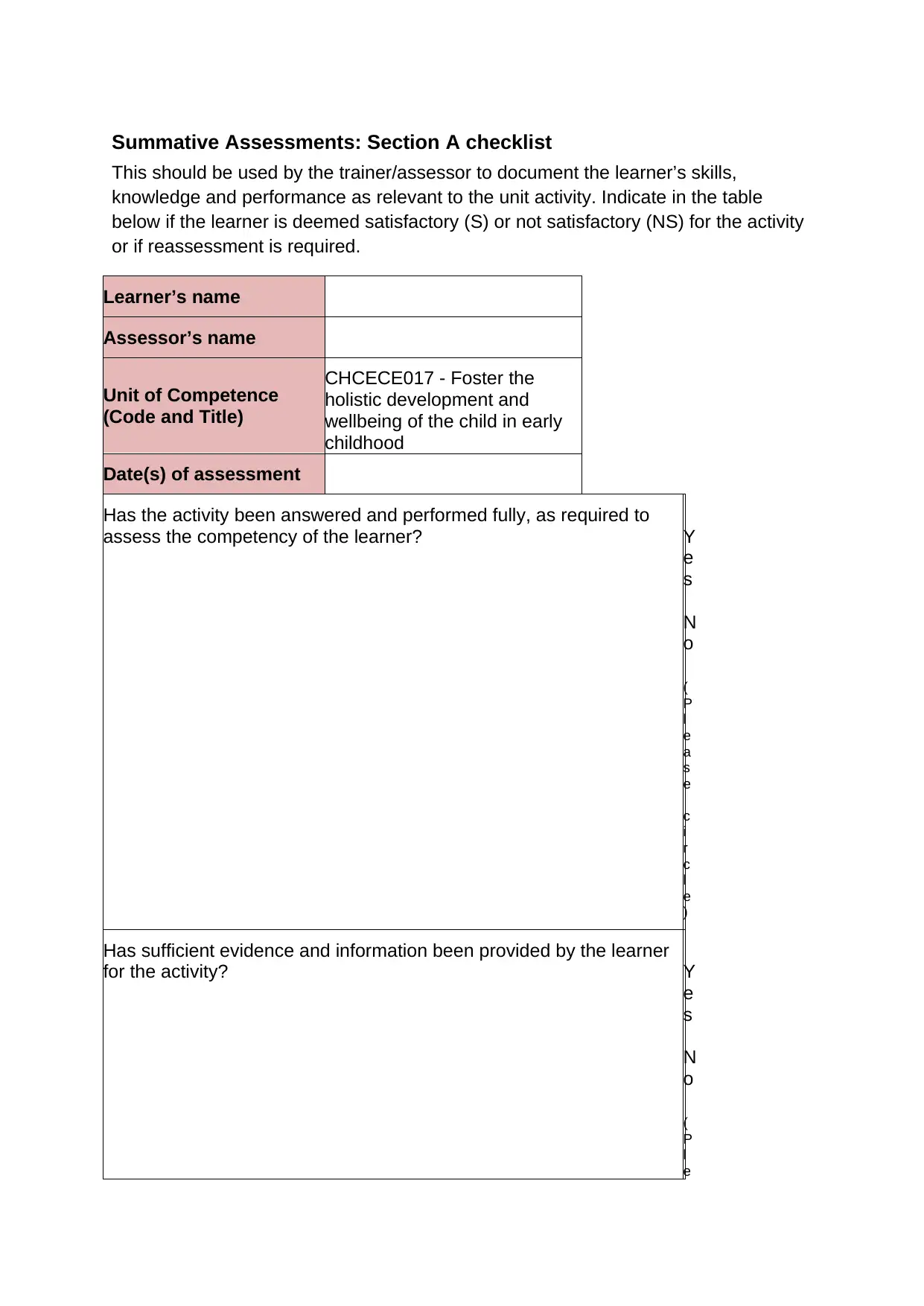
Summative Assessments: Section A checklist
This should be used by the trainer/assessor to document the learner’s skills,
knowledge and performance as relevant to the unit activity. Indicate in the table
below if the learner is deemed satisfactory (S) or not satisfactory (NS) for the activity
or if reassessment is required.
Learner’s name
Assessor’s name
Unit of Competence
(Code and Title)
CHCECE017 - Foster the
holistic development and
wellbeing of the child in early
childhood
Date(s) of assessment
Has the activity been answered and performed fully, as required to
assess the competency of the learner? Y
e
s
N
o
(
P
l
e
a
s
e
c
i
r
c
l
e
)
Has sufficient evidence and information been provided by the learner
for the activity? Y
e
s
N
o
(
P
l
e
This should be used by the trainer/assessor to document the learner’s skills,
knowledge and performance as relevant to the unit activity. Indicate in the table
below if the learner is deemed satisfactory (S) or not satisfactory (NS) for the activity
or if reassessment is required.
Learner’s name
Assessor’s name
Unit of Competence
(Code and Title)
CHCECE017 - Foster the
holistic development and
wellbeing of the child in early
childhood
Date(s) of assessment
Has the activity been answered and performed fully, as required to
assess the competency of the learner? Y
e
s
N
o
(
P
l
e
a
s
e
c
i
r
c
l
e
)
Has sufficient evidence and information been provided by the learner
for the activity? Y
e
s
N
o
(
P
l
e
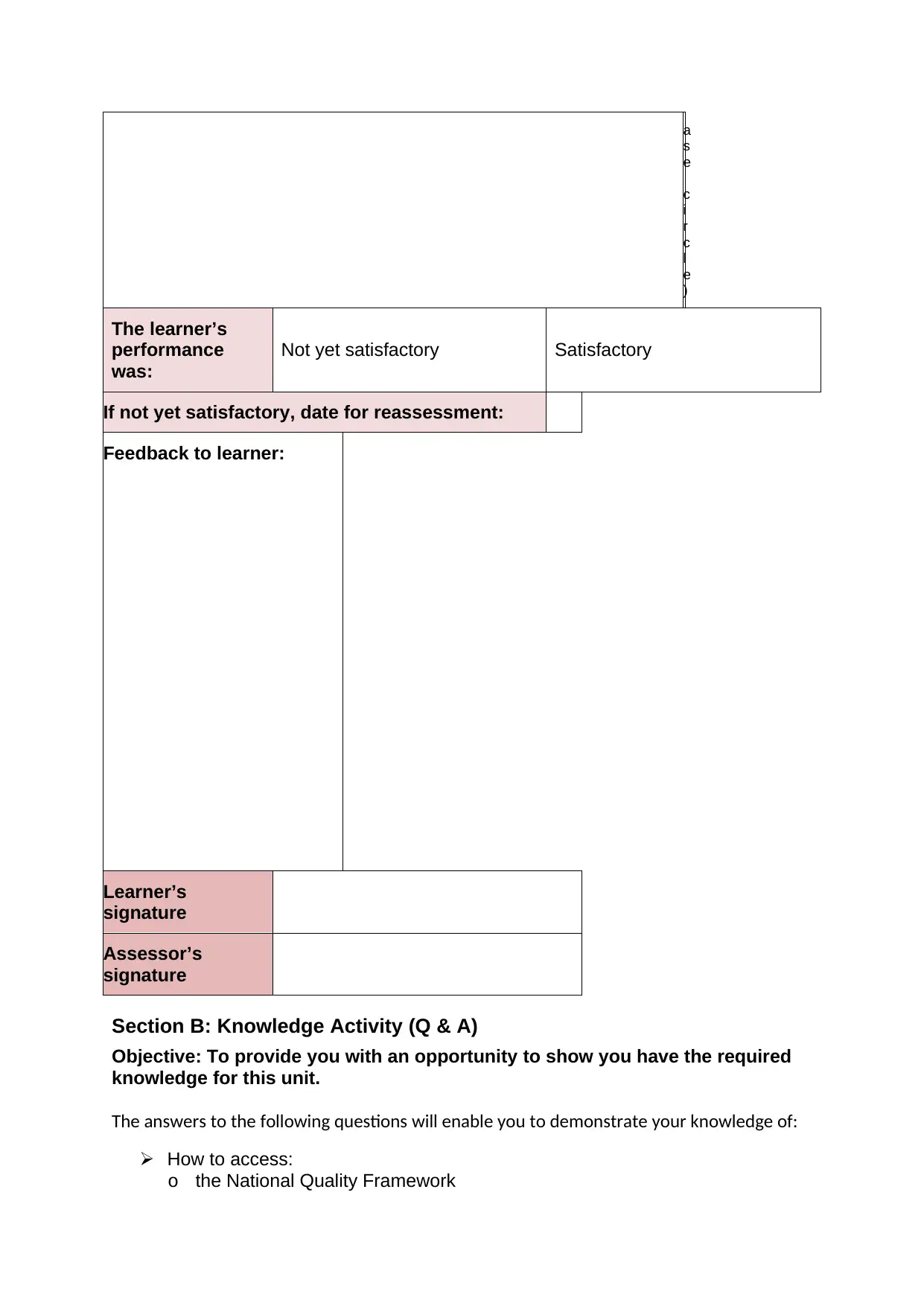
a
s
e
c
i
r
c
l
e
)
The learner’s
performance
was:
Not yet satisfactory Satisfactory
If not yet satisfactory, date for reassessment:
Feedback to learner:
Learner’s
signature
Assessor’s
signature
Section B: Knowledge Activity (Q & A)
Objective: To provide you with an opportunity to show you have the required
knowledge for this unit.
The answers to the following questions will enable you to demonstrate your knowledge of:
How to access:
o the National Quality Framework
s
e
c
i
r
c
l
e
)
The learner’s
performance
was:
Not yet satisfactory Satisfactory
If not yet satisfactory, date for reassessment:
Feedback to learner:
Learner’s
signature
Assessor’s
signature
Section B: Knowledge Activity (Q & A)
Objective: To provide you with an opportunity to show you have the required
knowledge for this unit.
The answers to the following questions will enable you to demonstrate your knowledge of:
How to access:
o the National Quality Framework
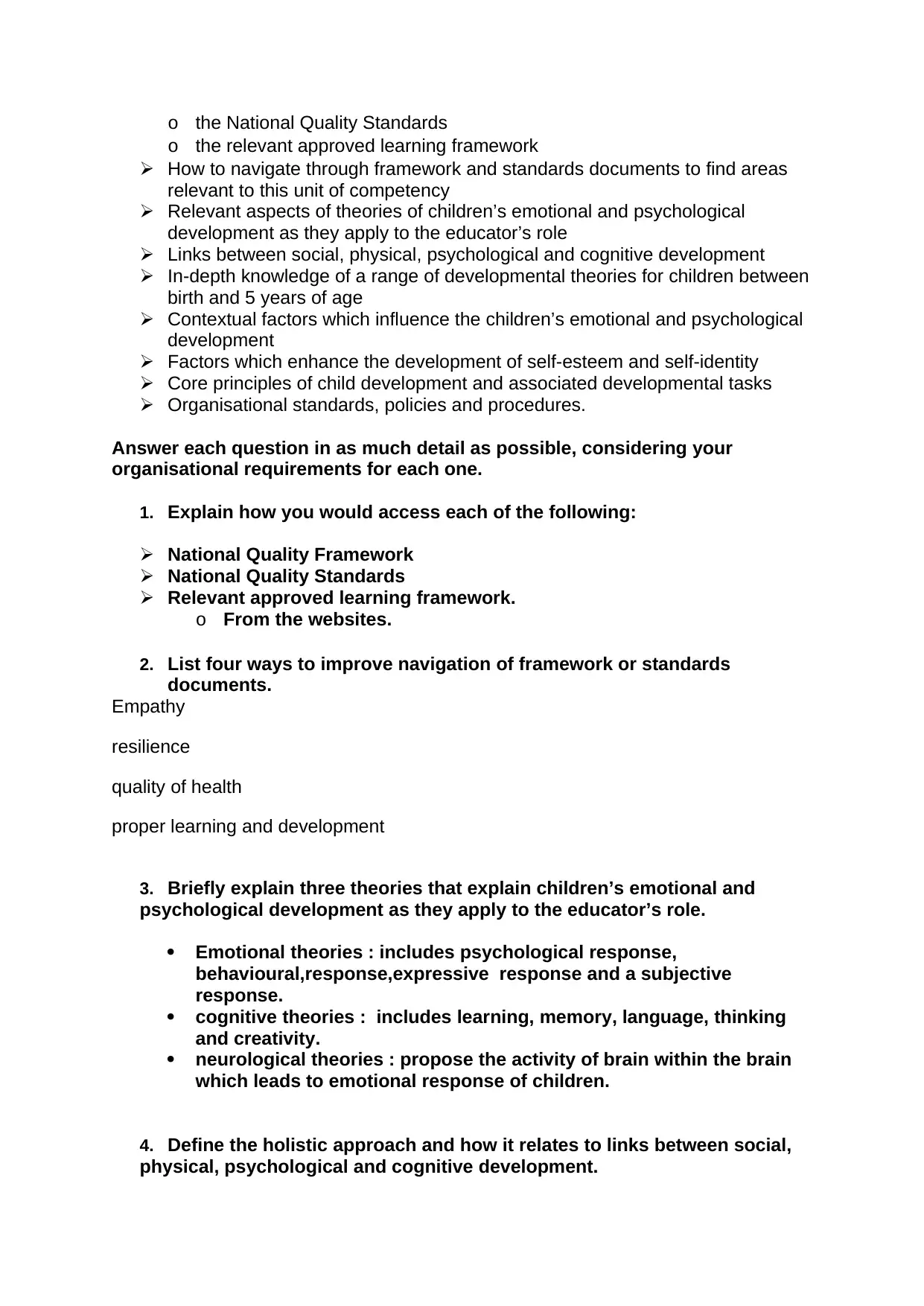
o the National Quality Standards
o the relevant approved learning framework
How to navigate through framework and standards documents to find areas
relevant to this unit of competency
Relevant aspects of theories of children’s emotional and psychological
development as they apply to the educator’s role
Links between social, physical, psychological and cognitive development
In-depth knowledge of a range of developmental theories for children between
birth and 5 years of age
Contextual factors which influence the children’s emotional and psychological
development
Factors which enhance the development of self-esteem and self-identity
Core principles of child development and associated developmental tasks
Organisational standards, policies and procedures.
Answer each question in as much detail as possible, considering your
organisational requirements for each one.
1. Explain how you would access each of the following:
National Quality Framework
National Quality Standards
Relevant approved learning framework.
o From the websites.
2. List four ways to improve navigation of framework or standards
documents.
Empathy
resilience
quality of health
proper learning and development
3. Briefly explain three theories that explain children’s emotional and
psychological development as they apply to the educator’s role.
Emotional theories : includes psychological response,
behavioural,response,expressive response and a subjective
response.
cognitive theories : includes learning, memory, language, thinking
and creativity.
neurological theories : propose the activity of brain within the brain
which leads to emotional response of children.
4. Define the holistic approach and how it relates to links between social,
physical, psychological and cognitive development.
o the relevant approved learning framework
How to navigate through framework and standards documents to find areas
relevant to this unit of competency
Relevant aspects of theories of children’s emotional and psychological
development as they apply to the educator’s role
Links between social, physical, psychological and cognitive development
In-depth knowledge of a range of developmental theories for children between
birth and 5 years of age
Contextual factors which influence the children’s emotional and psychological
development
Factors which enhance the development of self-esteem and self-identity
Core principles of child development and associated developmental tasks
Organisational standards, policies and procedures.
Answer each question in as much detail as possible, considering your
organisational requirements for each one.
1. Explain how you would access each of the following:
National Quality Framework
National Quality Standards
Relevant approved learning framework.
o From the websites.
2. List four ways to improve navigation of framework or standards
documents.
Empathy
resilience
quality of health
proper learning and development
3. Briefly explain three theories that explain children’s emotional and
psychological development as they apply to the educator’s role.
Emotional theories : includes psychological response,
behavioural,response,expressive response and a subjective
response.
cognitive theories : includes learning, memory, language, thinking
and creativity.
neurological theories : propose the activity of brain within the brain
which leads to emotional response of children.
4. Define the holistic approach and how it relates to links between social,
physical, psychological and cognitive development.
Paraphrase This Document
Need a fresh take? Get an instant paraphrase of this document with our AI Paraphraser
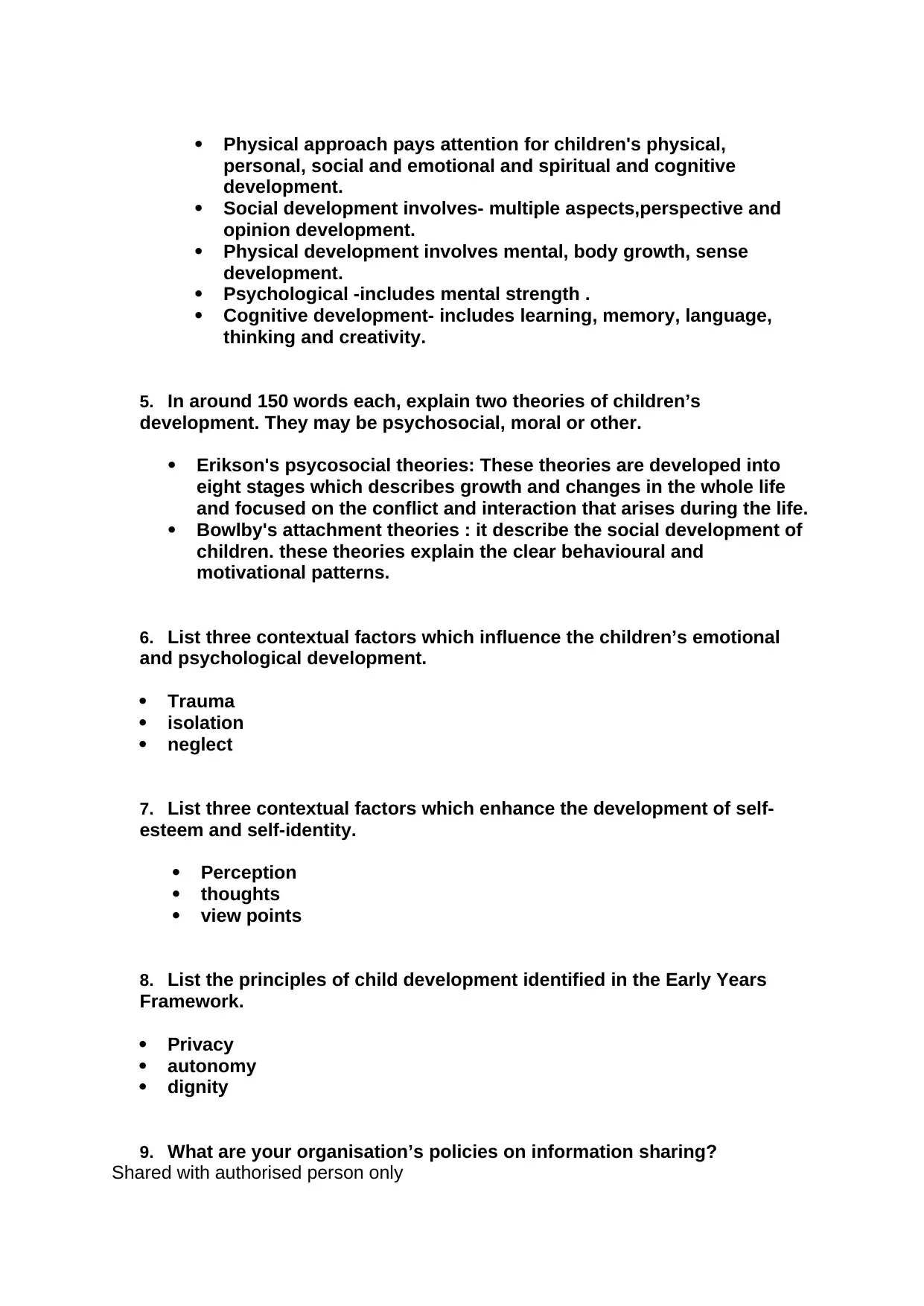
Physical approach pays attention for children's physical,
personal, social and emotional and spiritual and cognitive
development.
Social development involves- multiple aspects,perspective and
opinion development.
Physical development involves mental, body growth, sense
development.
Psychological -includes mental strength .
Cognitive development- includes learning, memory, language,
thinking and creativity.
5. In around 150 words each, explain two theories of children’s
development. They may be psychosocial, moral or other.
Erikson's psycosocial theories: These theories are developed into
eight stages which describes growth and changes in the whole life
and focused on the conflict and interaction that arises during the life.
Bowlby's attachment theories : it describe the social development of
children. these theories explain the clear behavioural and
motivational patterns.
6. List three contextual factors which influence the children’s emotional
and psychological development.
Trauma
isolation
neglect
7. List three contextual factors which enhance the development of self-
esteem and self-identity.
Perception
thoughts
view points
8. List the principles of child development identified in the Early Years
Framework.
Privacy
autonomy
dignity
9. What are your organisation’s policies on information sharing?
Shared with authorised person only
personal, social and emotional and spiritual and cognitive
development.
Social development involves- multiple aspects,perspective and
opinion development.
Physical development involves mental, body growth, sense
development.
Psychological -includes mental strength .
Cognitive development- includes learning, memory, language,
thinking and creativity.
5. In around 150 words each, explain two theories of children’s
development. They may be psychosocial, moral or other.
Erikson's psycosocial theories: These theories are developed into
eight stages which describes growth and changes in the whole life
and focused on the conflict and interaction that arises during the life.
Bowlby's attachment theories : it describe the social development of
children. these theories explain the clear behavioural and
motivational patterns.
6. List three contextual factors which influence the children’s emotional
and psychological development.
Trauma
isolation
neglect
7. List three contextual factors which enhance the development of self-
esteem and self-identity.
Perception
thoughts
view points
8. List the principles of child development identified in the Early Years
Framework.
Privacy
autonomy
dignity
9. What are your organisation’s policies on information sharing?
Shared with authorised person only
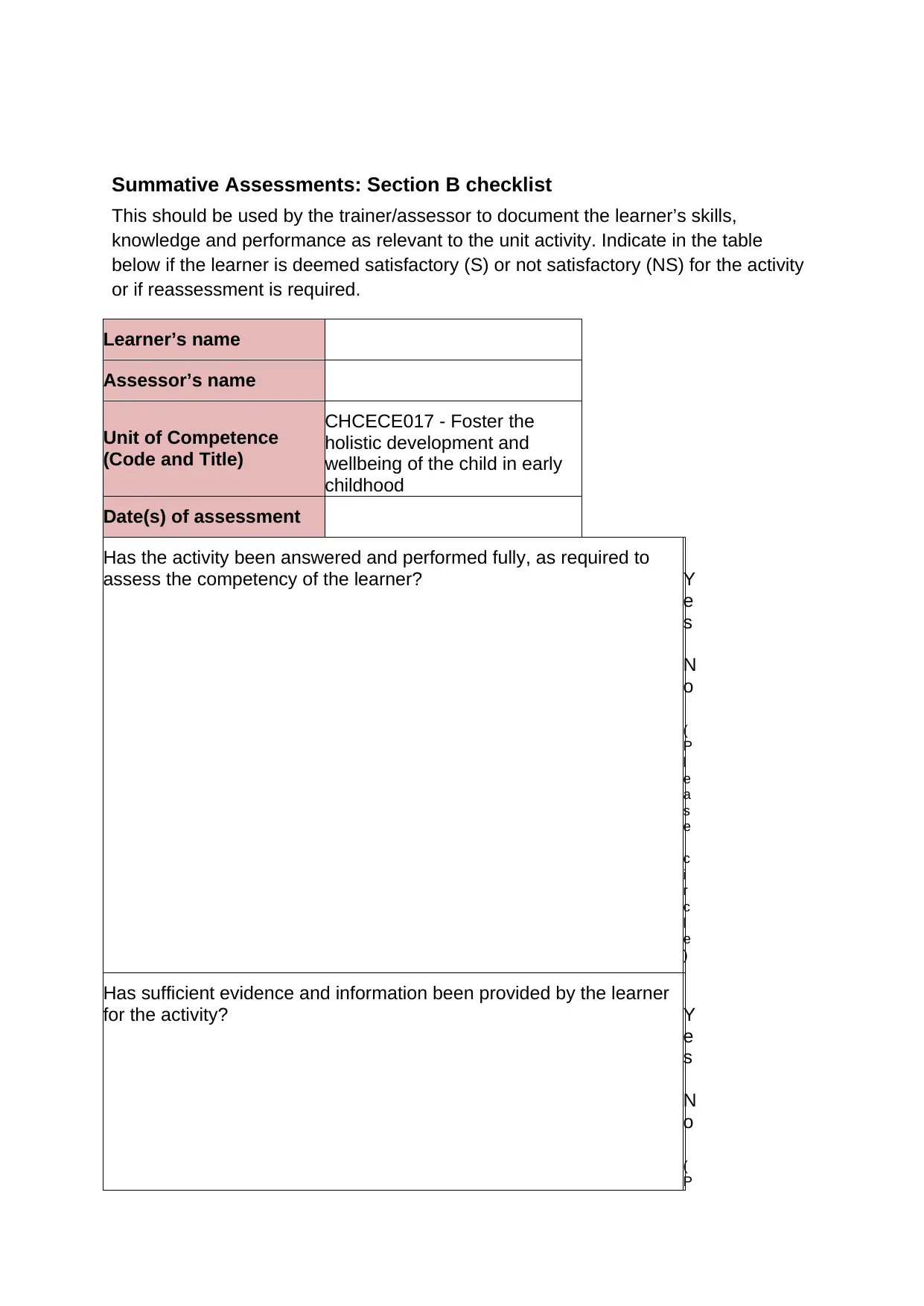
Summative Assessments: Section B checklist
This should be used by the trainer/assessor to document the learner’s skills,
knowledge and performance as relevant to the unit activity. Indicate in the table
below if the learner is deemed satisfactory (S) or not satisfactory (NS) for the activity
or if reassessment is required.
Learner’s name
Assessor’s name
Unit of Competence
(Code and Title)
CHCECE017 - Foster the
holistic development and
wellbeing of the child in early
childhood
Date(s) of assessment
Has the activity been answered and performed fully, as required to
assess the competency of the learner? Y
e
s
N
o
(
P
l
e
a
s
e
c
i
r
c
l
e
)
Has sufficient evidence and information been provided by the learner
for the activity? Y
e
s
N
o
(
P
This should be used by the trainer/assessor to document the learner’s skills,
knowledge and performance as relevant to the unit activity. Indicate in the table
below if the learner is deemed satisfactory (S) or not satisfactory (NS) for the activity
or if reassessment is required.
Learner’s name
Assessor’s name
Unit of Competence
(Code and Title)
CHCECE017 - Foster the
holistic development and
wellbeing of the child in early
childhood
Date(s) of assessment
Has the activity been answered and performed fully, as required to
assess the competency of the learner? Y
e
s
N
o
(
P
l
e
a
s
e
c
i
r
c
l
e
)
Has sufficient evidence and information been provided by the learner
for the activity? Y
e
s
N
o
(
P
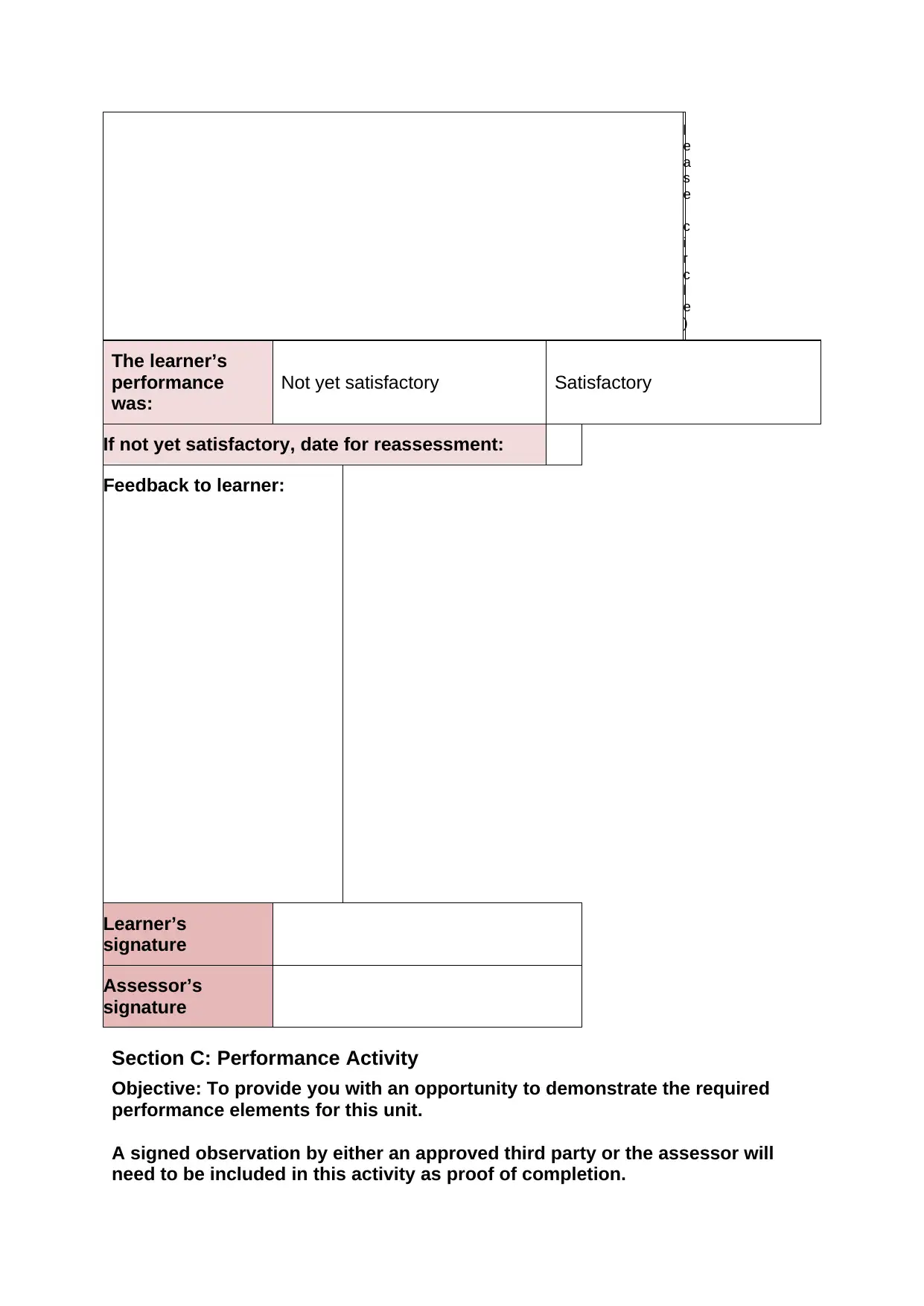
l
e
a
s
e
c
i
r
c
l
e
)
The learner’s
performance
was:
Not yet satisfactory Satisfactory
If not yet satisfactory, date for reassessment:
Feedback to learner:
Learner’s
signature
Assessor’s
signature
Section C: Performance Activity
Objective: To provide you with an opportunity to demonstrate the required
performance elements for this unit.
A signed observation by either an approved third party or the assessor will
need to be included in this activity as proof of completion.
e
a
s
e
c
i
r
c
l
e
)
The learner’s
performance
was:
Not yet satisfactory Satisfactory
If not yet satisfactory, date for reassessment:
Feedback to learner:
Learner’s
signature
Assessor’s
signature
Section C: Performance Activity
Objective: To provide you with an opportunity to demonstrate the required
performance elements for this unit.
A signed observation by either an approved third party or the assessor will
need to be included in this activity as proof of completion.
Secure Best Marks with AI Grader
Need help grading? Try our AI Grader for instant feedback on your assignments.
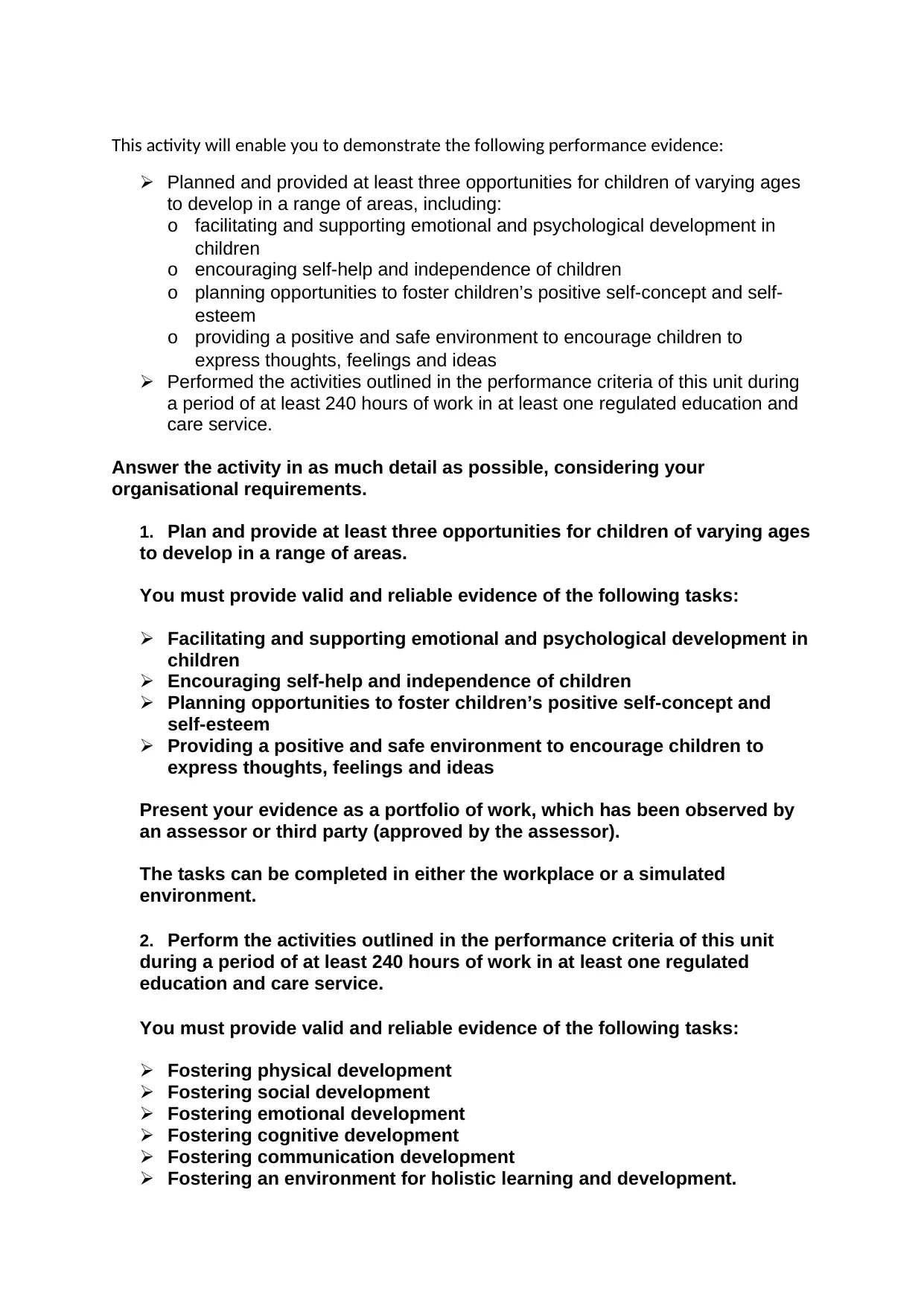
This activity will enable you to demonstrate the following performance evidence:
Planned and provided at least three opportunities for children of varying ages
to develop in a range of areas, including:
o facilitating and supporting emotional and psychological development in
children
o encouraging self-help and independence of children
o planning opportunities to foster children’s positive self-concept and self-
esteem
o providing a positive and safe environment to encourage children to
express thoughts, feelings and ideas
Performed the activities outlined in the performance criteria of this unit during
a period of at least 240 hours of work in at least one regulated education and
care service.
Answer the activity in as much detail as possible, considering your
organisational requirements.
1. Plan and provide at least three opportunities for children of varying ages
to develop in a range of areas.
You must provide valid and reliable evidence of the following tasks:
Facilitating and supporting emotional and psychological development in
children
Encouraging self-help and independence of children
Planning opportunities to foster children’s positive self-concept and
self-esteem
Providing a positive and safe environment to encourage children to
express thoughts, feelings and ideas
Present your evidence as a portfolio of work, which has been observed by
an assessor or third party (approved by the assessor).
The tasks can be completed in either the workplace or a simulated
environment.
2. Perform the activities outlined in the performance criteria of this unit
during a period of at least 240 hours of work in at least one regulated
education and care service.
You must provide valid and reliable evidence of the following tasks:
Fostering physical development
Fostering social development
Fostering emotional development
Fostering cognitive development
Fostering communication development
Fostering an environment for holistic learning and development.
Planned and provided at least three opportunities for children of varying ages
to develop in a range of areas, including:
o facilitating and supporting emotional and psychological development in
children
o encouraging self-help and independence of children
o planning opportunities to foster children’s positive self-concept and self-
esteem
o providing a positive and safe environment to encourage children to
express thoughts, feelings and ideas
Performed the activities outlined in the performance criteria of this unit during
a period of at least 240 hours of work in at least one regulated education and
care service.
Answer the activity in as much detail as possible, considering your
organisational requirements.
1. Plan and provide at least three opportunities for children of varying ages
to develop in a range of areas.
You must provide valid and reliable evidence of the following tasks:
Facilitating and supporting emotional and psychological development in
children
Encouraging self-help and independence of children
Planning opportunities to foster children’s positive self-concept and
self-esteem
Providing a positive and safe environment to encourage children to
express thoughts, feelings and ideas
Present your evidence as a portfolio of work, which has been observed by
an assessor or third party (approved by the assessor).
The tasks can be completed in either the workplace or a simulated
environment.
2. Perform the activities outlined in the performance criteria of this unit
during a period of at least 240 hours of work in at least one regulated
education and care service.
You must provide valid and reliable evidence of the following tasks:
Fostering physical development
Fostering social development
Fostering emotional development
Fostering cognitive development
Fostering communication development
Fostering an environment for holistic learning and development.

Present your evidence as a portfolio of work, which has been observed by
an assessor or third party (approved by the assessor).
The tasks can be completed in either the workplace or a simulated
environment.
an assessor or third party (approved by the assessor).
The tasks can be completed in either the workplace or a simulated
environment.
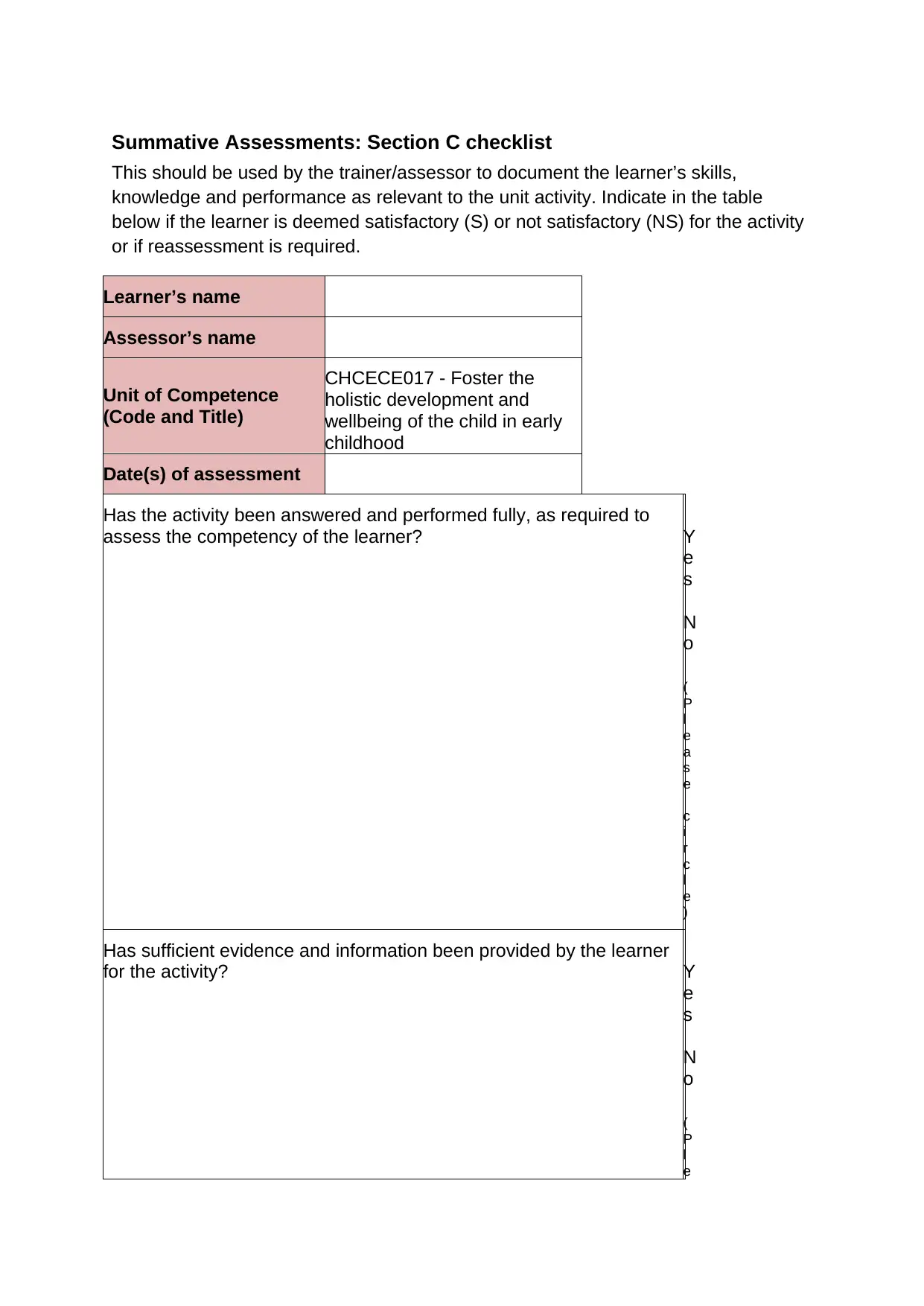
Summative Assessments: Section C checklist
This should be used by the trainer/assessor to document the learner’s skills,
knowledge and performance as relevant to the unit activity. Indicate in the table
below if the learner is deemed satisfactory (S) or not satisfactory (NS) for the activity
or if reassessment is required.
Learner’s name
Assessor’s name
Unit of Competence
(Code and Title)
CHCECE017 - Foster the
holistic development and
wellbeing of the child in early
childhood
Date(s) of assessment
Has the activity been answered and performed fully, as required to
assess the competency of the learner? Y
e
s
N
o
(
P
l
e
a
s
e
c
i
r
c
l
e
)
Has sufficient evidence and information been provided by the learner
for the activity? Y
e
s
N
o
(
P
l
e
This should be used by the trainer/assessor to document the learner’s skills,
knowledge and performance as relevant to the unit activity. Indicate in the table
below if the learner is deemed satisfactory (S) or not satisfactory (NS) for the activity
or if reassessment is required.
Learner’s name
Assessor’s name
Unit of Competence
(Code and Title)
CHCECE017 - Foster the
holistic development and
wellbeing of the child in early
childhood
Date(s) of assessment
Has the activity been answered and performed fully, as required to
assess the competency of the learner? Y
e
s
N
o
(
P
l
e
a
s
e
c
i
r
c
l
e
)
Has sufficient evidence and information been provided by the learner
for the activity? Y
e
s
N
o
(
P
l
e
Paraphrase This Document
Need a fresh take? Get an instant paraphrase of this document with our AI Paraphraser
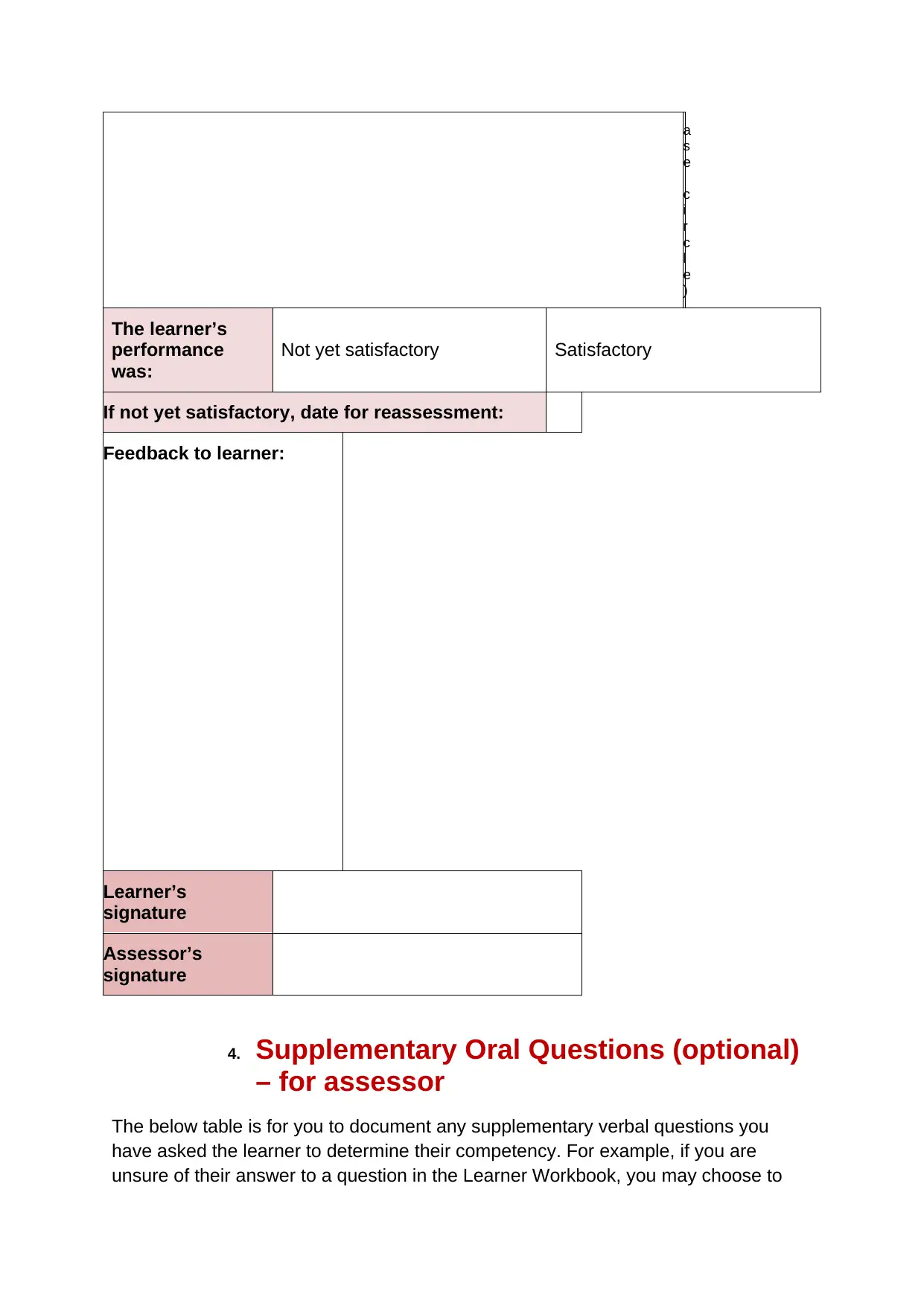
a
s
e
c
i
r
c
l
e
)
The learner’s
performance
was:
Not yet satisfactory Satisfactory
If not yet satisfactory, date for reassessment:
Feedback to learner:
Learner’s
signature
Assessor’s
signature
4. Supplementary Oral Questions (optional)
– for assessor
The below table is for you to document any supplementary verbal questions you
have asked the learner to determine their competency. For example, if you are
unsure of their answer to a question in the Learner Workbook, you may choose to
s
e
c
i
r
c
l
e
)
The learner’s
performance
was:
Not yet satisfactory Satisfactory
If not yet satisfactory, date for reassessment:
Feedback to learner:
Learner’s
signature
Assessor’s
signature
4. Supplementary Oral Questions (optional)
– for assessor
The below table is for you to document any supplementary verbal questions you
have asked the learner to determine their competency. For example, if you are
unsure of their answer to a question in the Learner Workbook, you may choose to
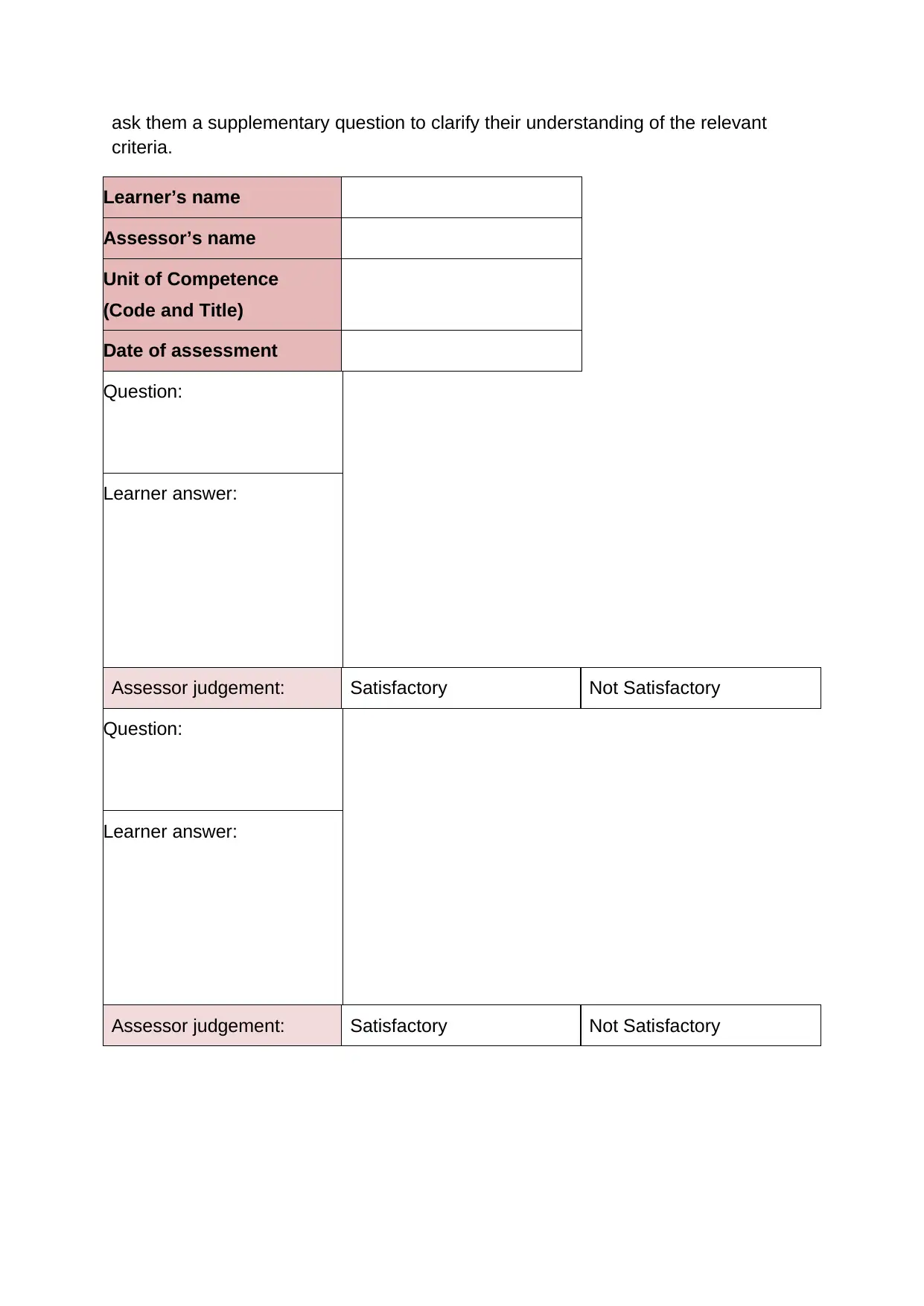
ask them a supplementary question to clarify their understanding of the relevant
criteria.
Learner’s name
Assessor’s name
Unit of Competence
(Code and Title)
Date of assessment
Question:
Learner answer:
Assessor judgement: Satisfactory Not Satisfactory
Question:
Learner answer:
Assessor judgement: Satisfactory Not Satisfactory
criteria.
Learner’s name
Assessor’s name
Unit of Competence
(Code and Title)
Date of assessment
Question:
Learner answer:
Assessor judgement: Satisfactory Not Satisfactory
Question:
Learner answer:
Assessor judgement: Satisfactory Not Satisfactory

Question:
Learner answer:
Assessor judgement: Satisfactory Not Satisfactory
Question:
Learner answer:
Assessor judgement: Satisfactory Not Satisfactory
Question:
Learner answer:
Assessor judgement: Satisfactory Not Satisfactory
Learner answer:
Assessor judgement: Satisfactory Not Satisfactory
Question:
Learner answer:
Assessor judgement: Satisfactory Not Satisfactory
Question:
Learner answer:
Assessor judgement: Satisfactory Not Satisfactory
Secure Best Marks with AI Grader
Need help grading? Try our AI Grader for instant feedback on your assignments.

Feedback for the learner
I have read, understood, and am satisfied
with the feedback provided by the
assessor.
Learner’s name
Learner’s signature
Assessor’s name
I have read, understood, and am satisfied
with the feedback provided by the
assessor.
Learner’s name
Learner’s signature
Assessor’s name

Assessor’s signature
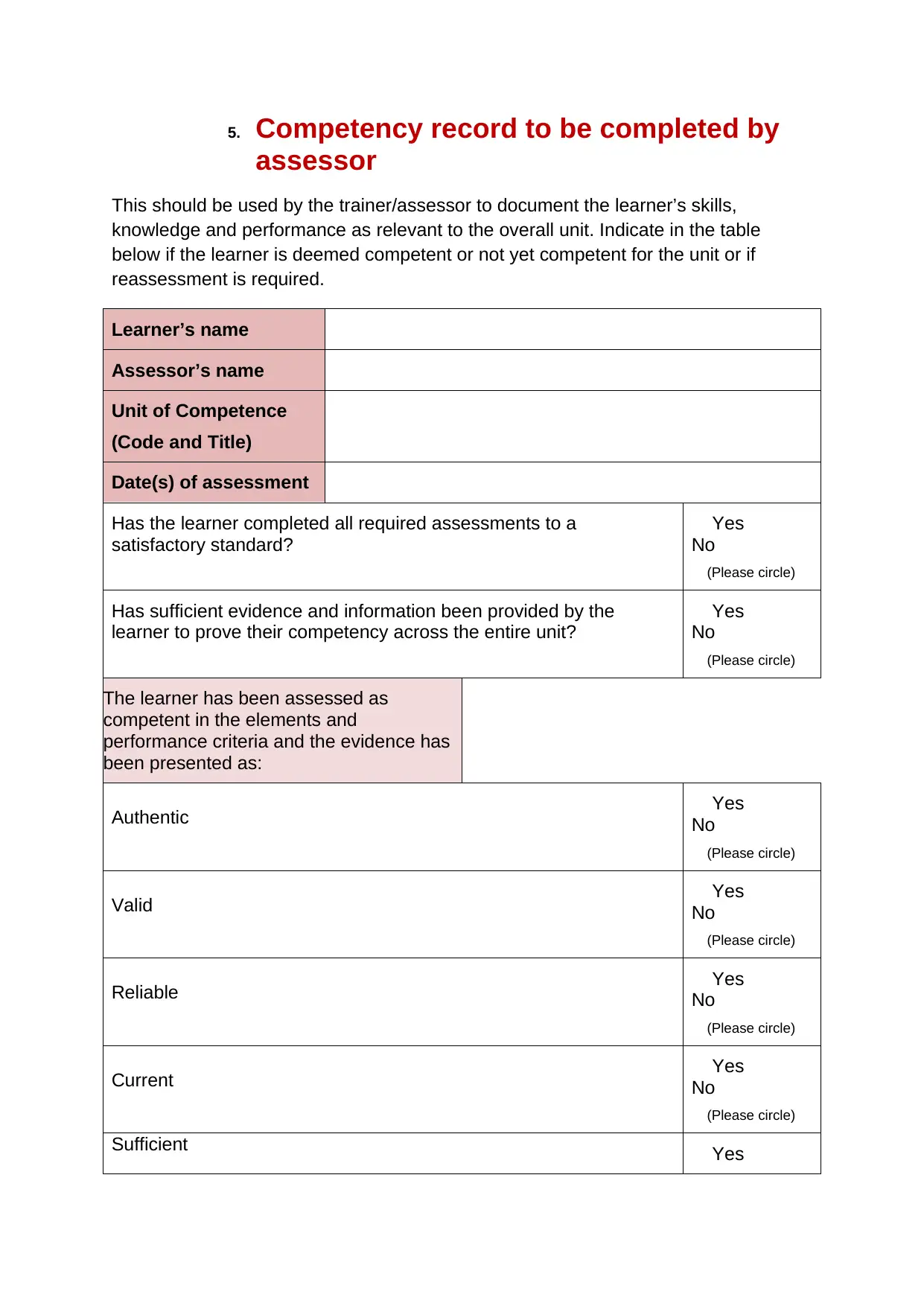
5. Competency record to be completed by
assessor
This should be used by the trainer/assessor to document the learner’s skills,
knowledge and performance as relevant to the overall unit. Indicate in the table
below if the learner is deemed competent or not yet competent for the unit or if
reassessment is required.
Learner’s name
Assessor’s name
Unit of Competence
(Code and Title)
Date(s) of assessment
Has the learner completed all required assessments to a
satisfactory standard?
Yes
No
(Please circle)
Has sufficient evidence and information been provided by the
learner to prove their competency across the entire unit?
Yes
No
(Please circle)
The learner has been assessed as
competent in the elements and
performance criteria and the evidence has
been presented as:
Authentic Yes
No
(Please circle)
Valid Yes
No
(Please circle)
Reliable Yes
No
(Please circle)
Current Yes
No
(Please circle)
Sufficient Yes
assessor
This should be used by the trainer/assessor to document the learner’s skills,
knowledge and performance as relevant to the overall unit. Indicate in the table
below if the learner is deemed competent or not yet competent for the unit or if
reassessment is required.
Learner’s name
Assessor’s name
Unit of Competence
(Code and Title)
Date(s) of assessment
Has the learner completed all required assessments to a
satisfactory standard?
Yes
No
(Please circle)
Has sufficient evidence and information been provided by the
learner to prove their competency across the entire unit?
Yes
No
(Please circle)
The learner has been assessed as
competent in the elements and
performance criteria and the evidence has
been presented as:
Authentic Yes
No
(Please circle)
Valid Yes
No
(Please circle)
Reliable Yes
No
(Please circle)
Current Yes
No
(Please circle)
Sufficient Yes
Paraphrase This Document
Need a fresh take? Get an instant paraphrase of this document with our AI Paraphraser

No
(Please circle)
(Please circle)
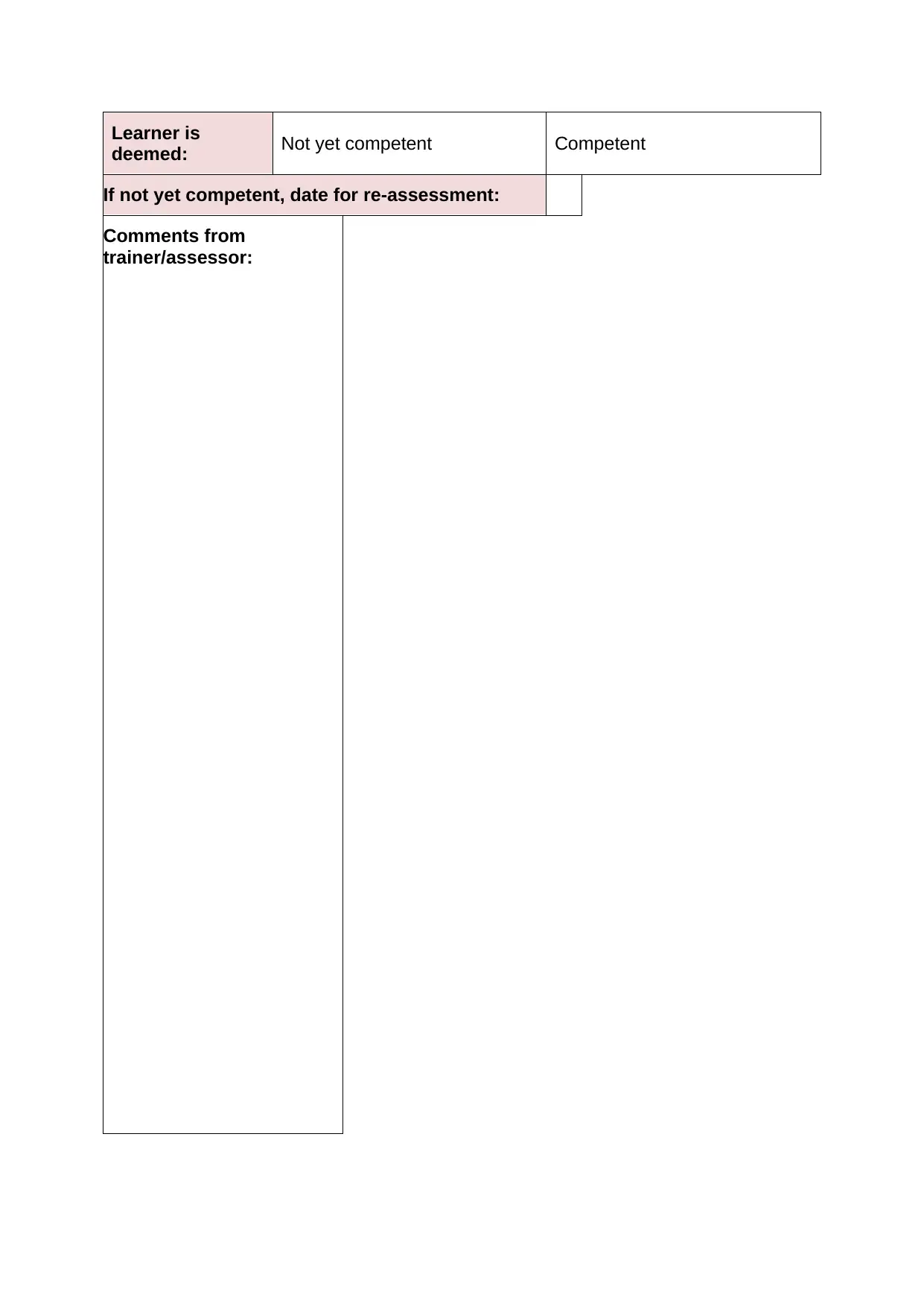
Learner is
deemed: Not yet competent Competent
If not yet competent, date for re-assessment:
Comments from
trainer/assessor:
deemed: Not yet competent Competent
If not yet competent, date for re-assessment:
Comments from
trainer/assessor:

Learner’s
signature
Assessor’s
signature
signature
Assessor’s
signature
1 out of 100
Related Documents
Your All-in-One AI-Powered Toolkit for Academic Success.
+13062052269
info@desklib.com
Available 24*7 on WhatsApp / Email
![[object Object]](/_next/static/media/star-bottom.7253800d.svg)
Unlock your academic potential
© 2024 | Zucol Services PVT LTD | All rights reserved.





